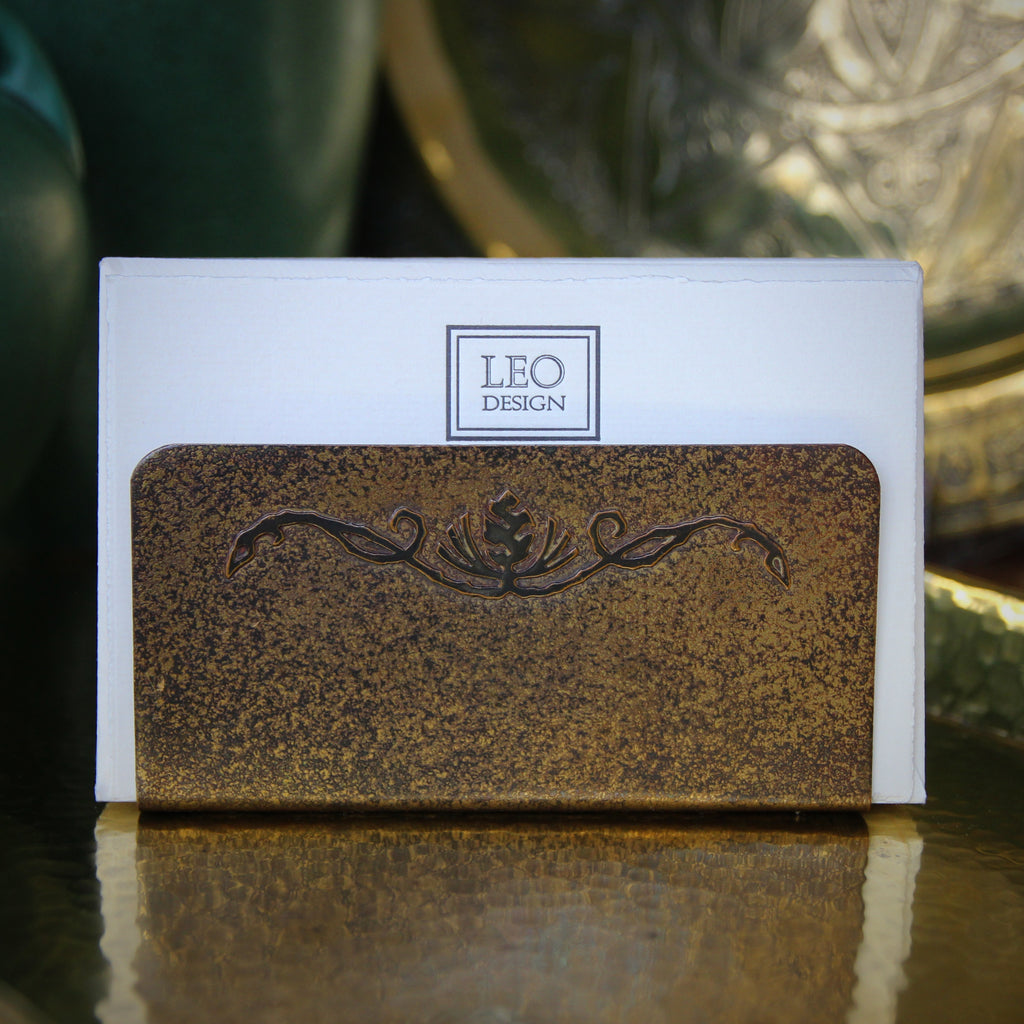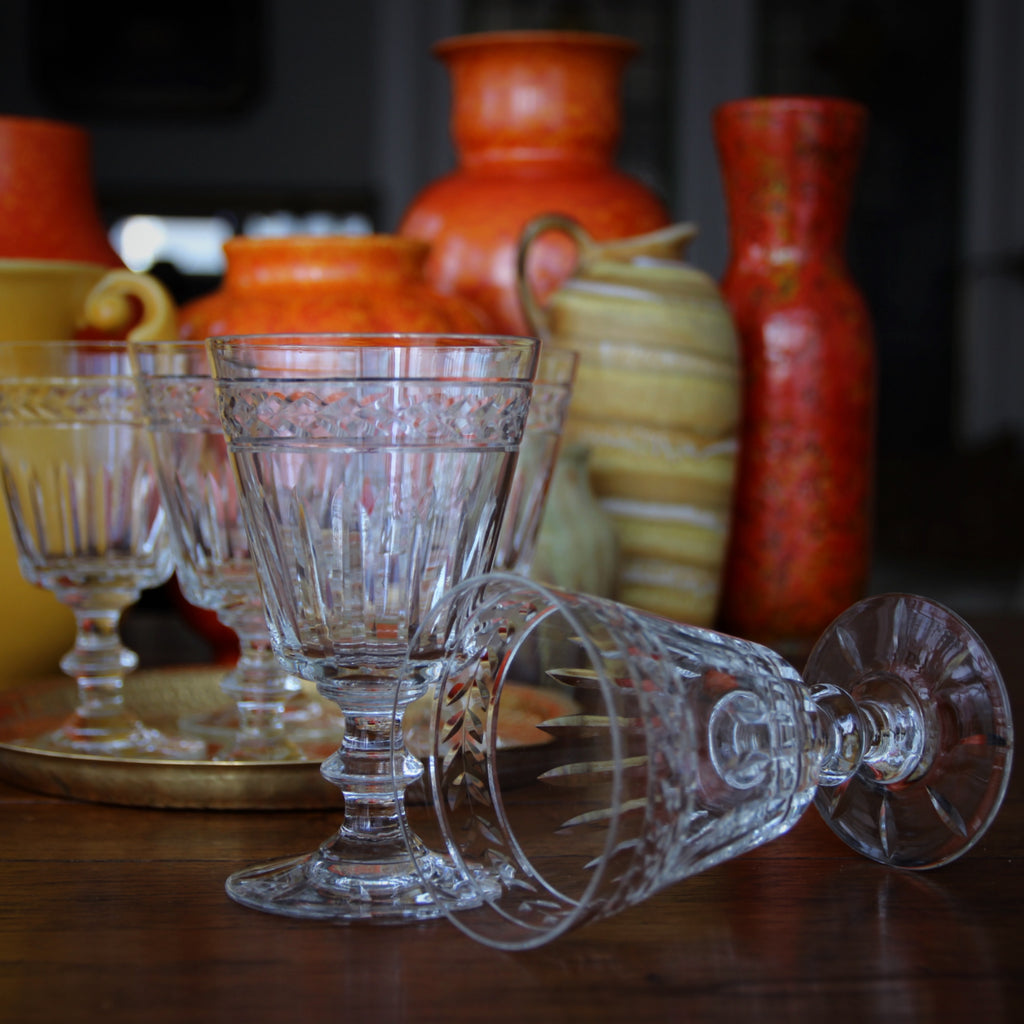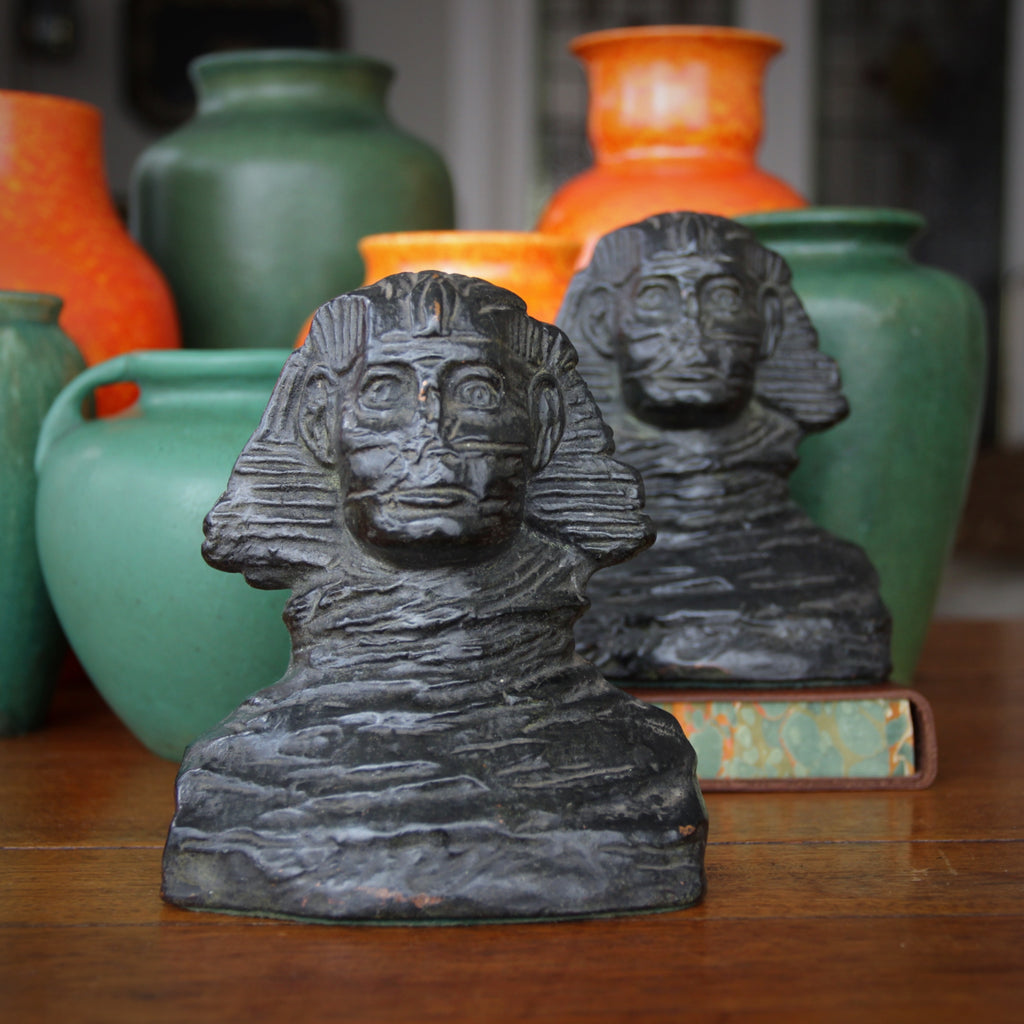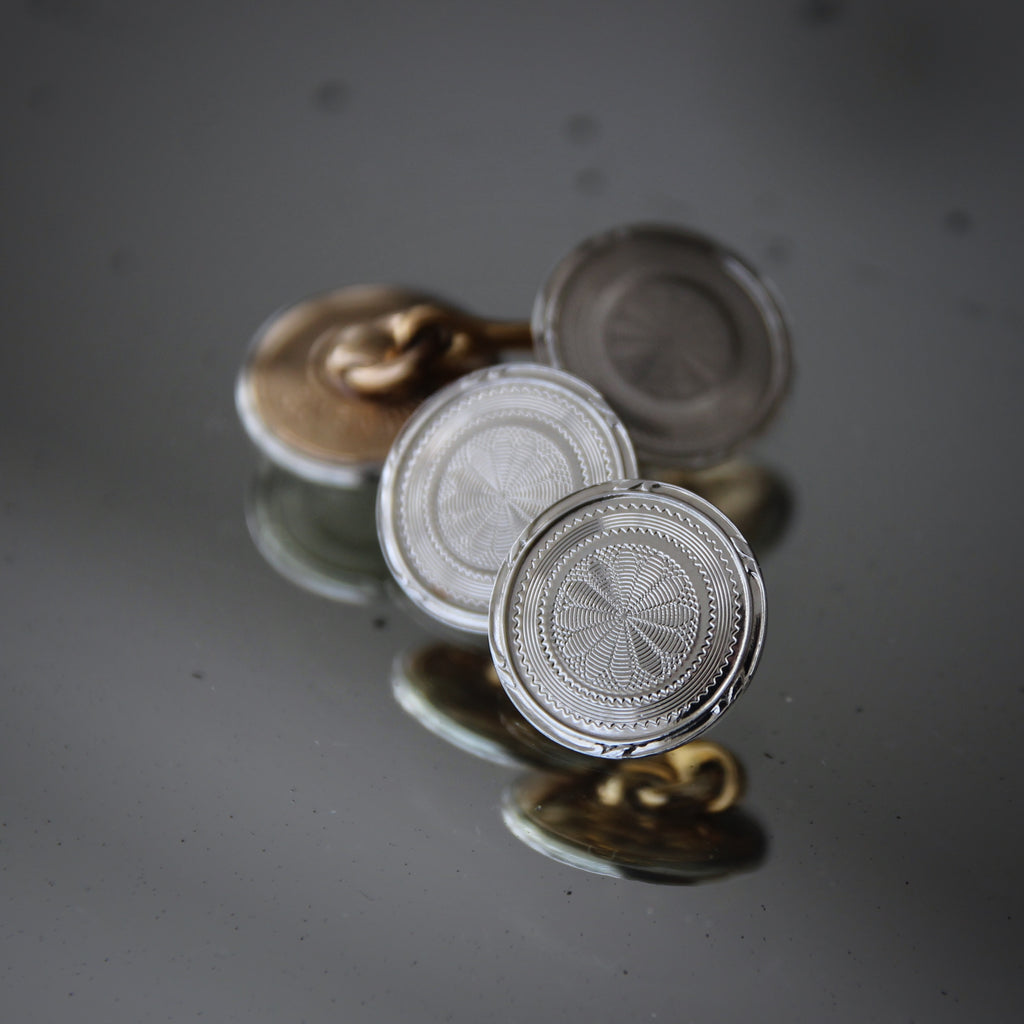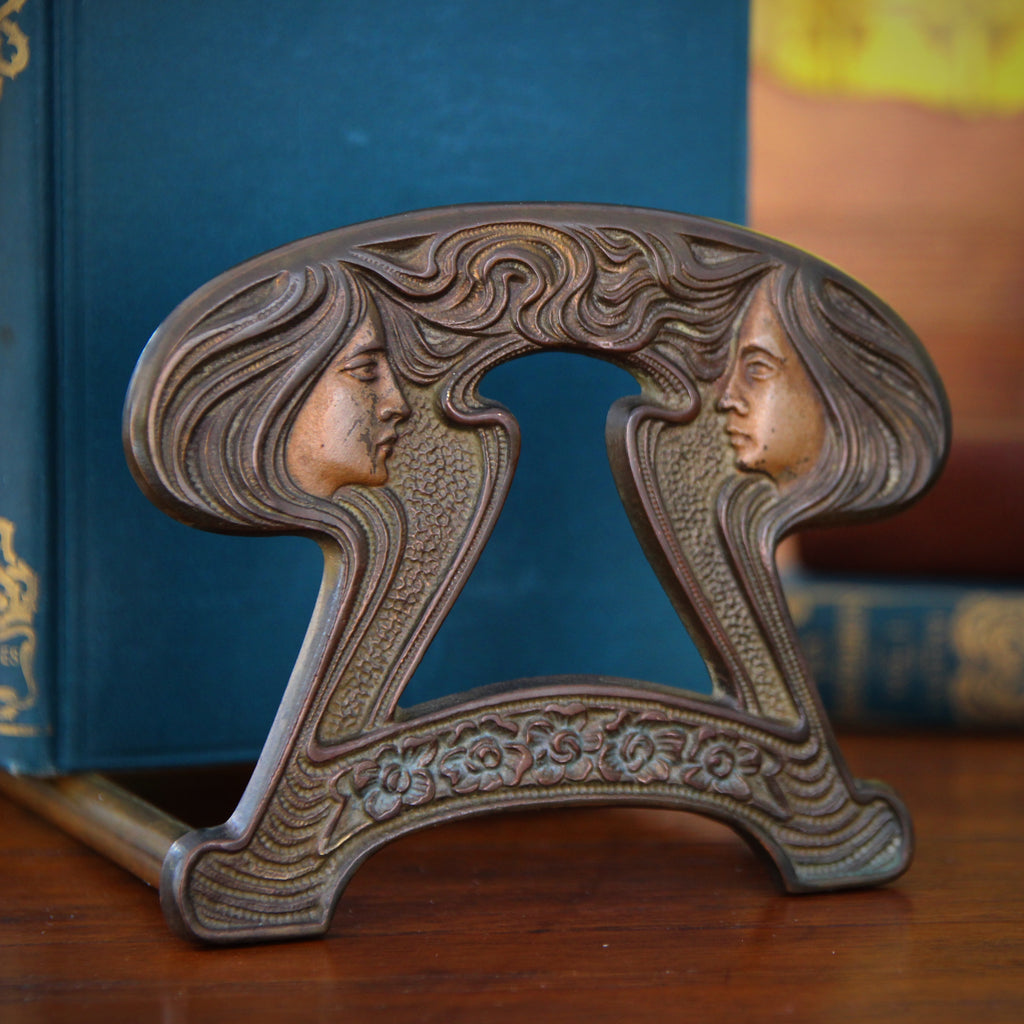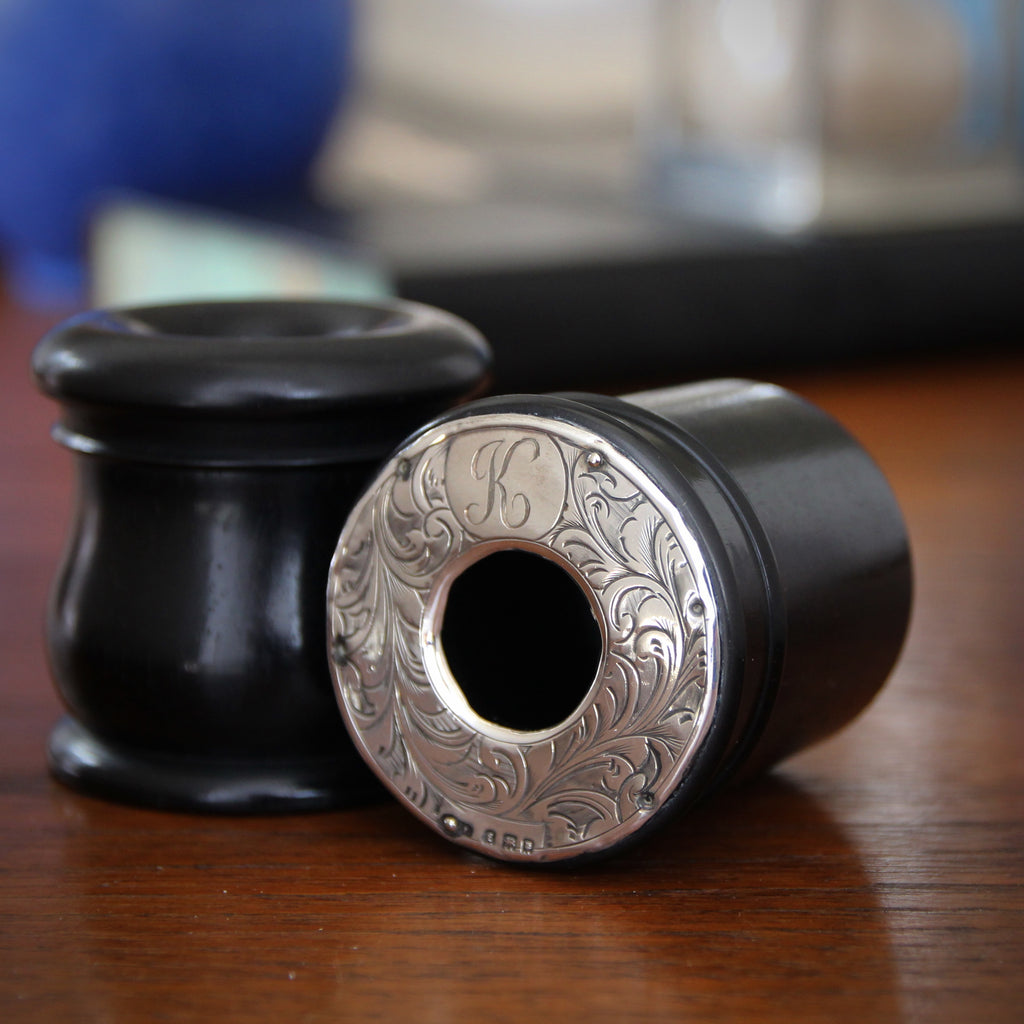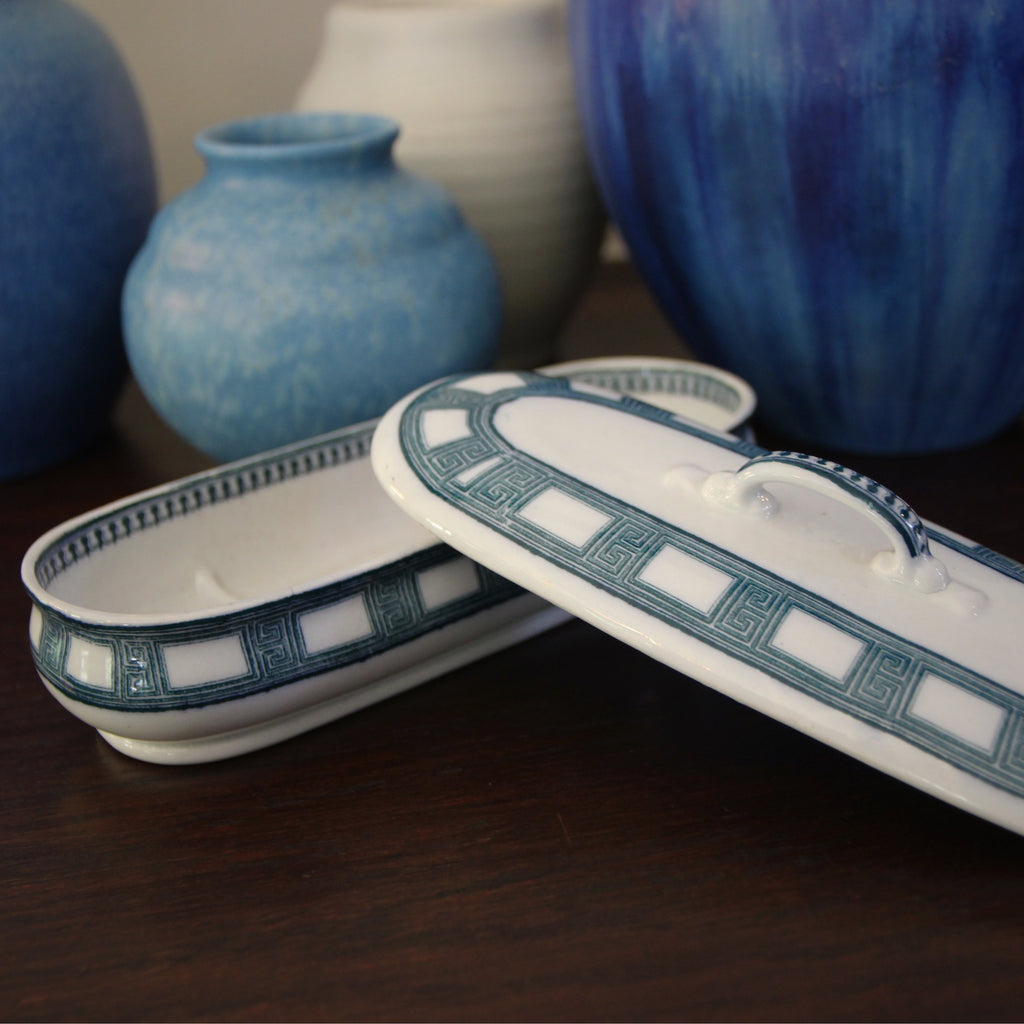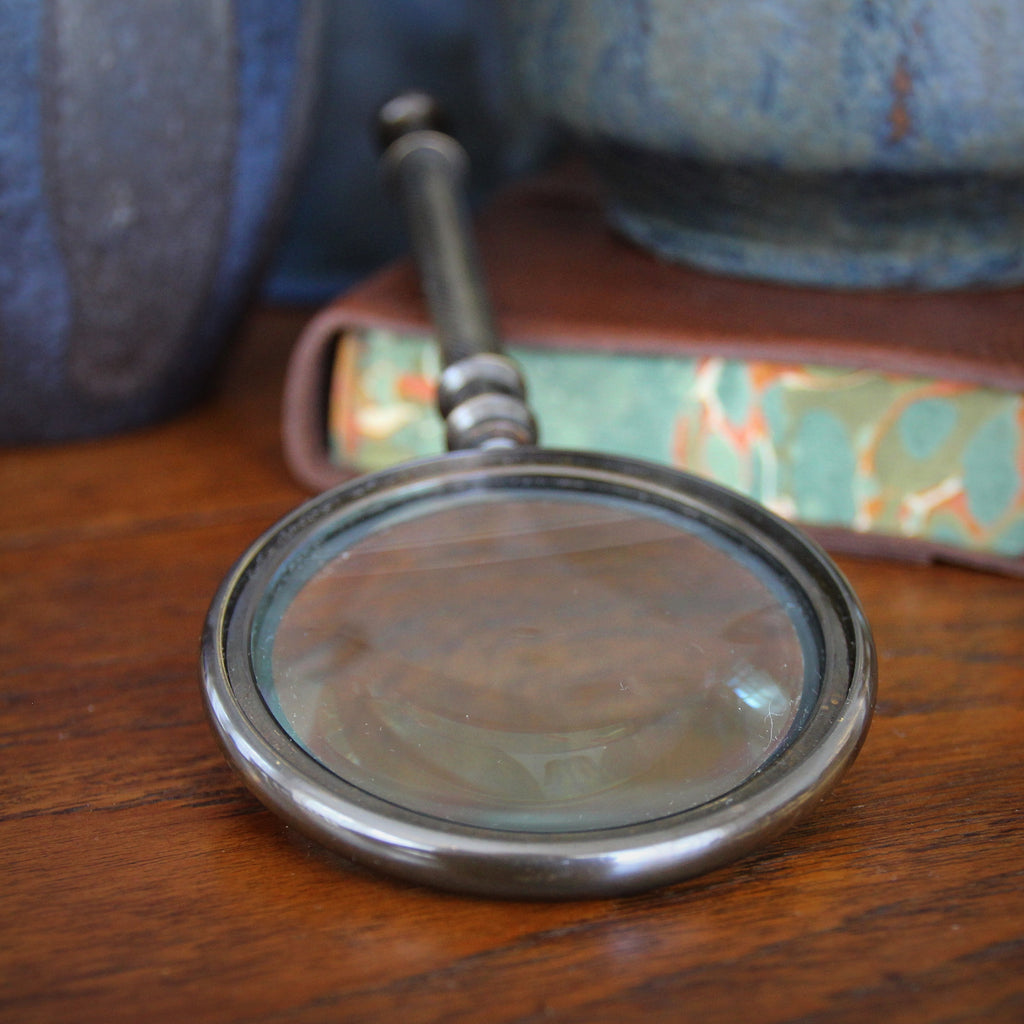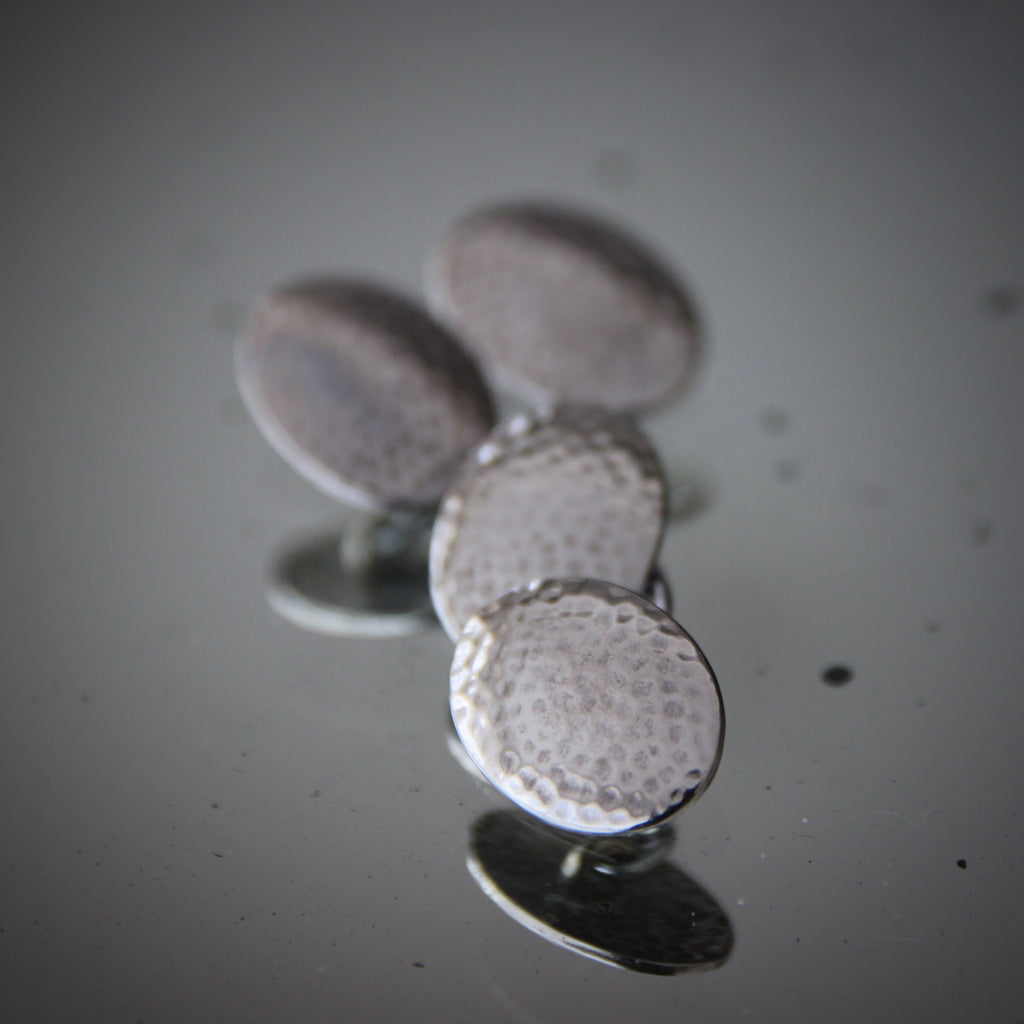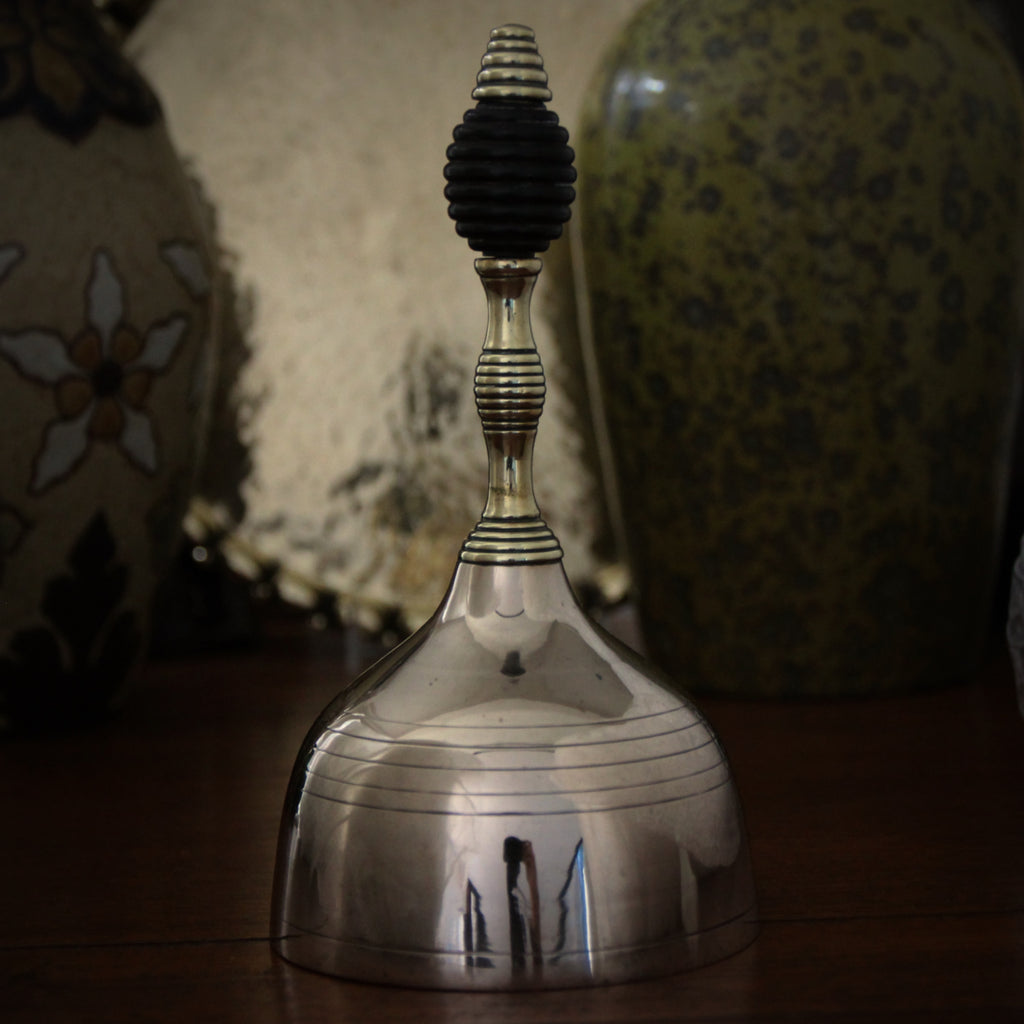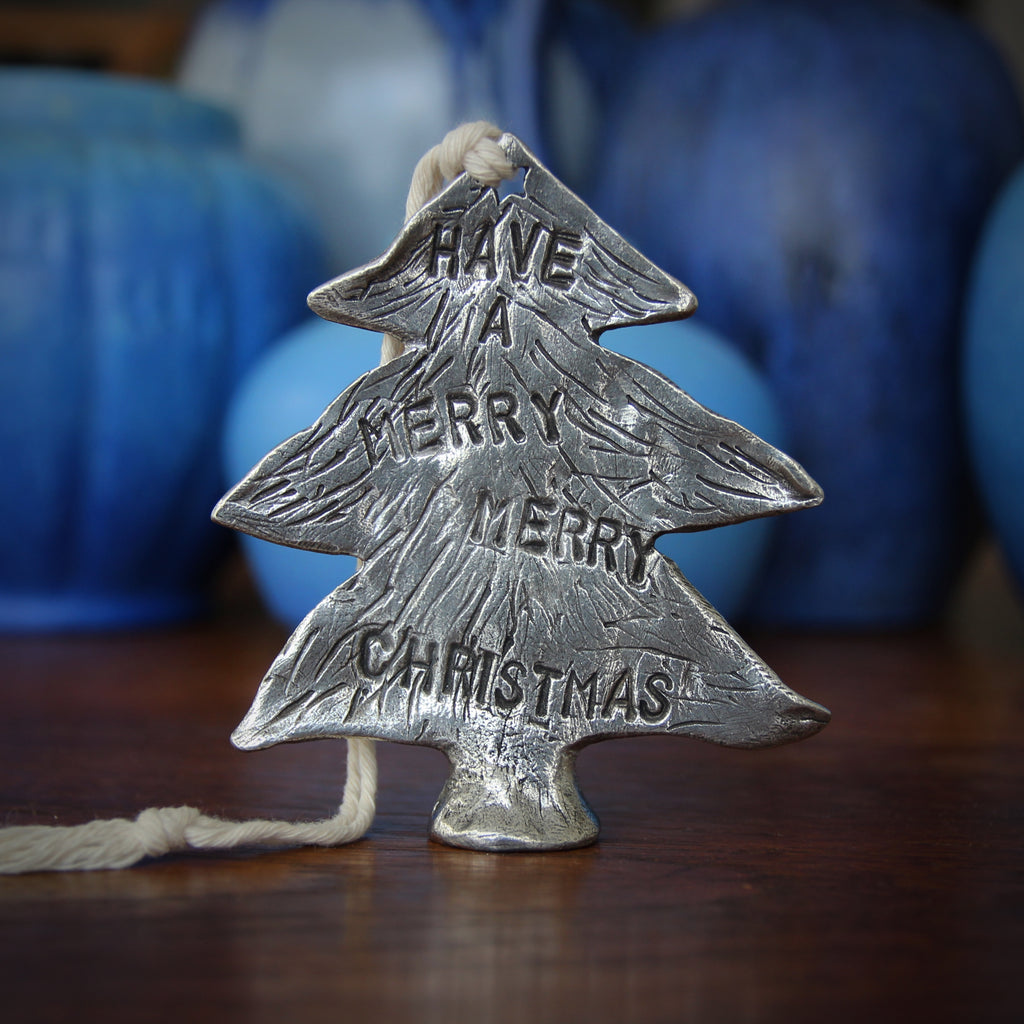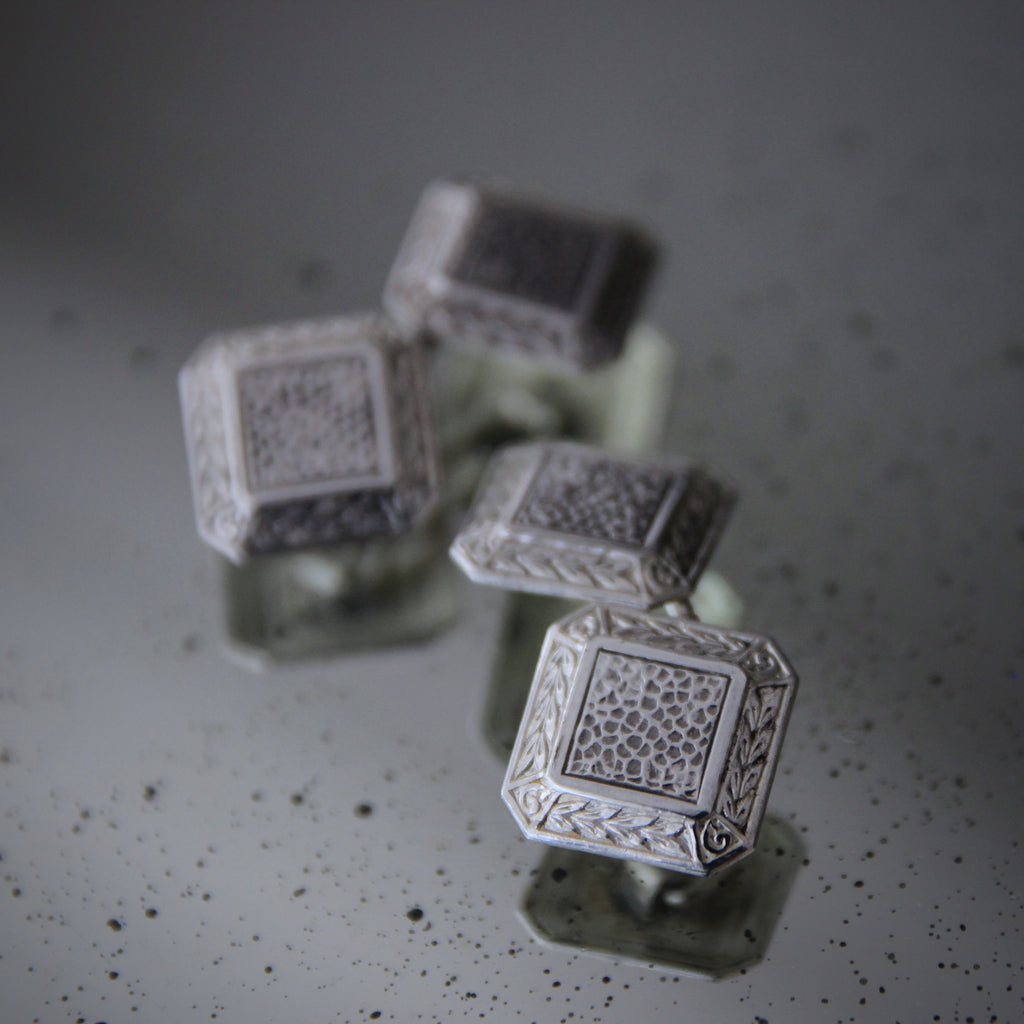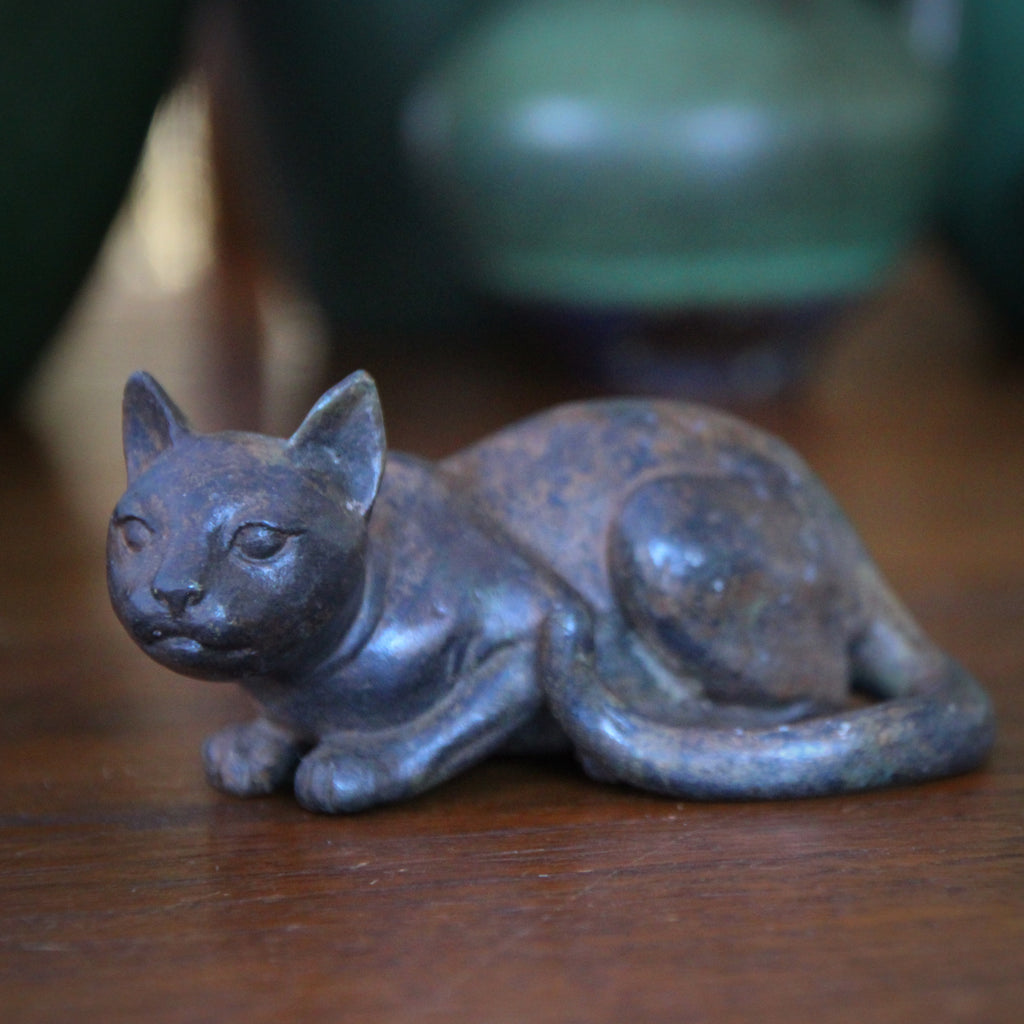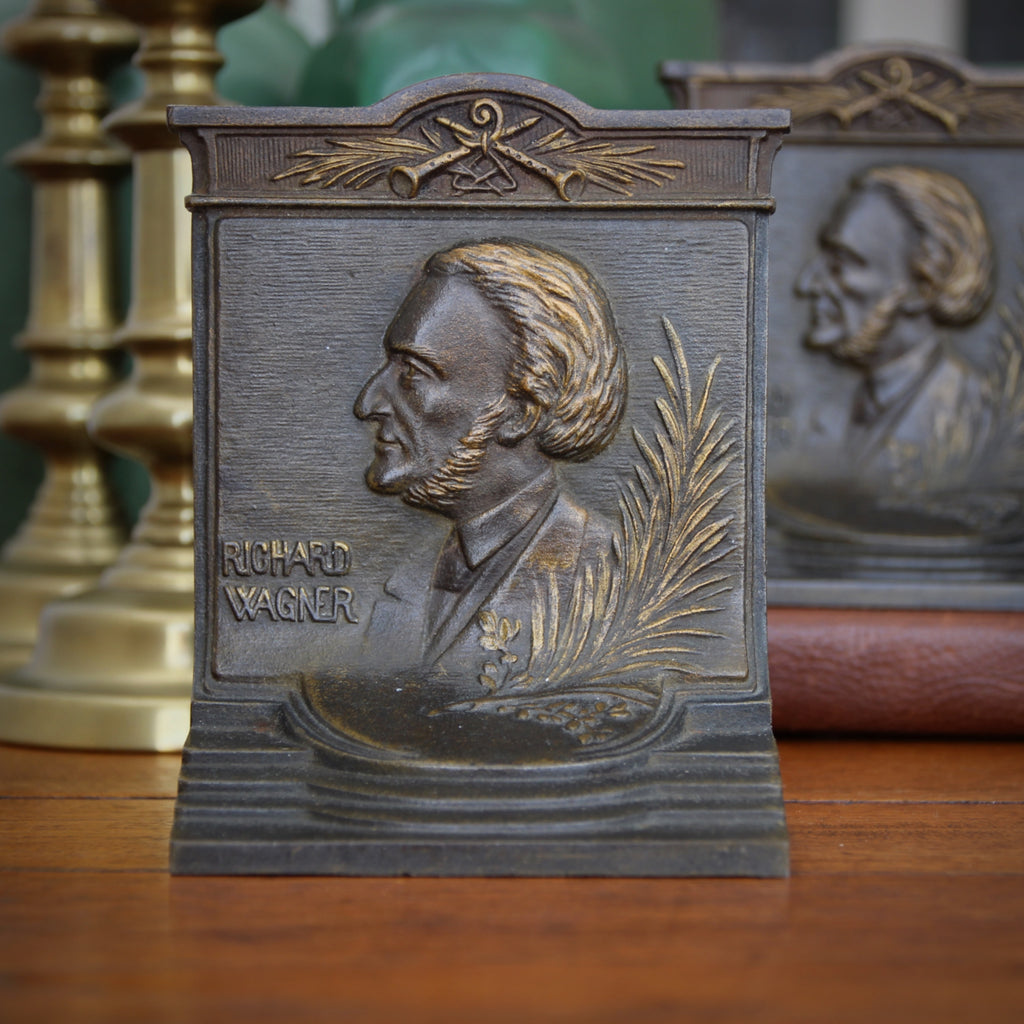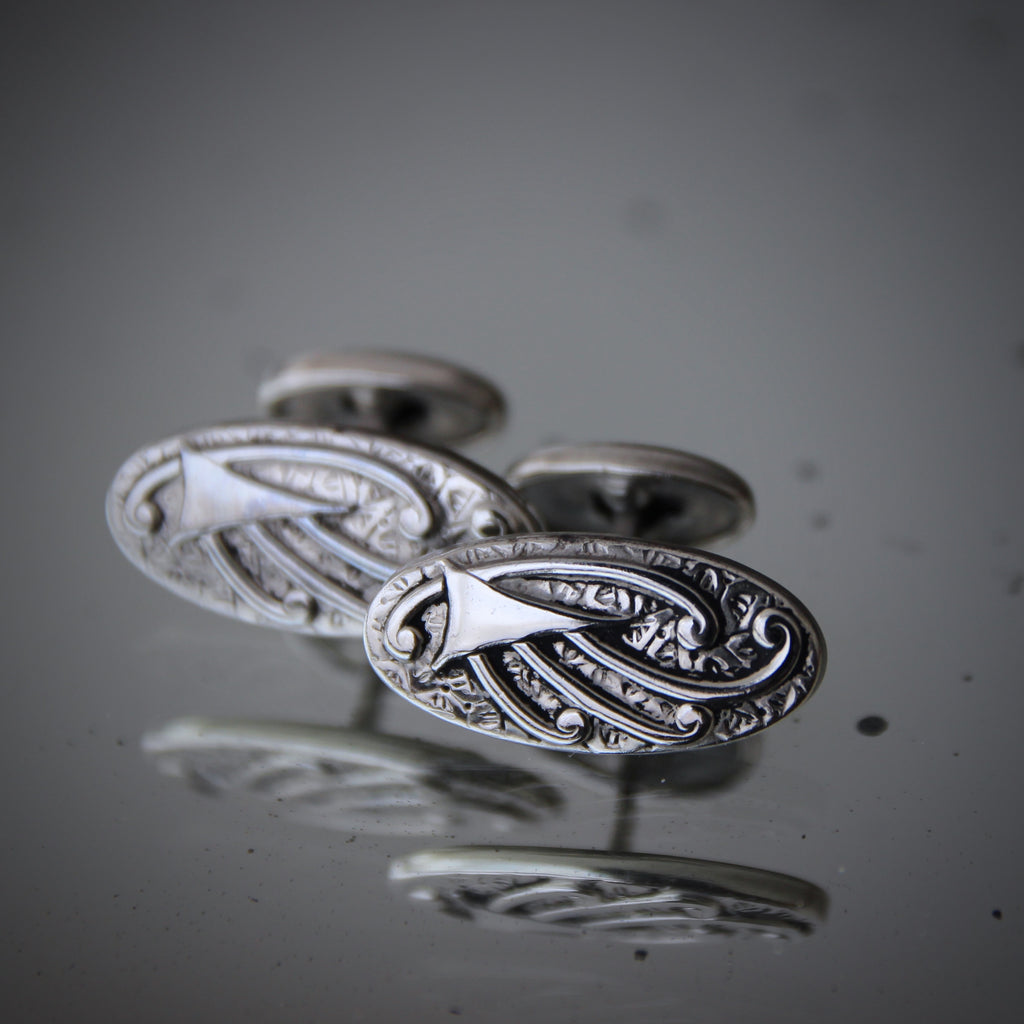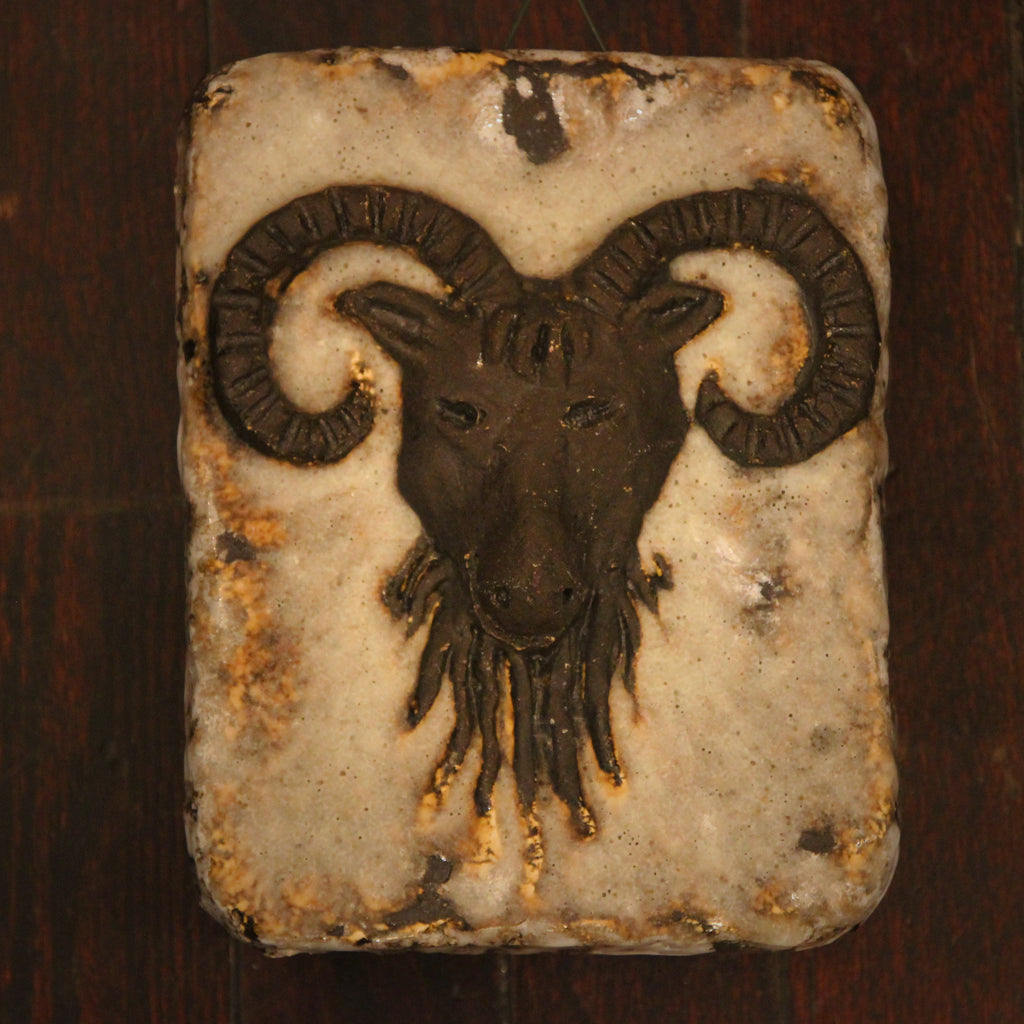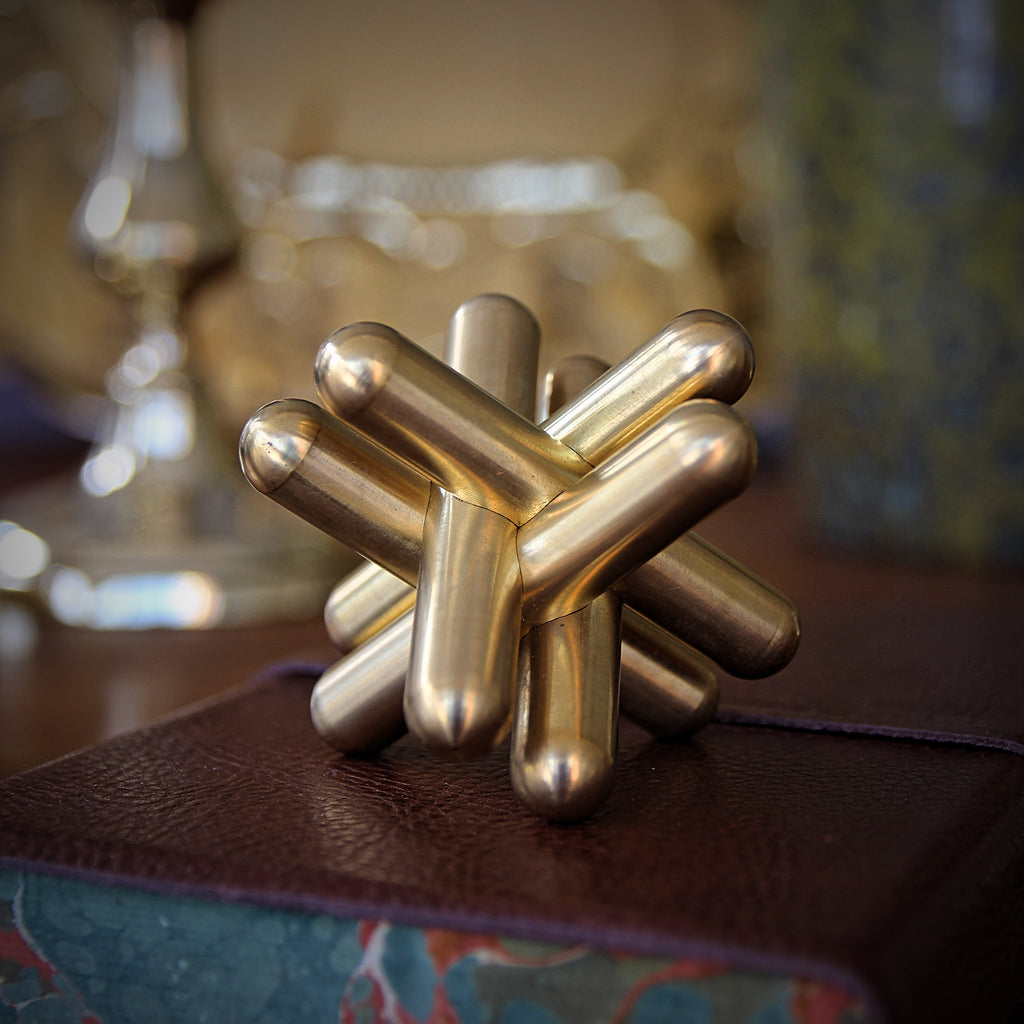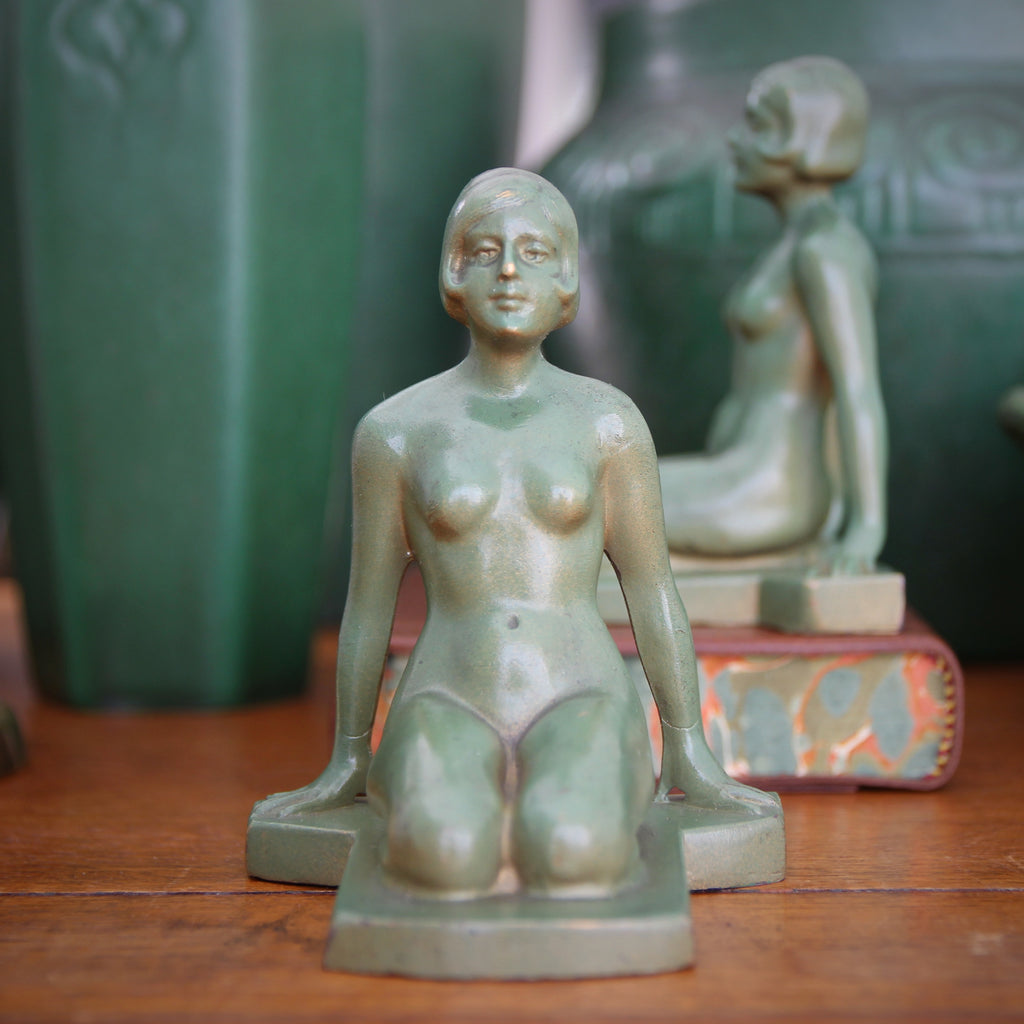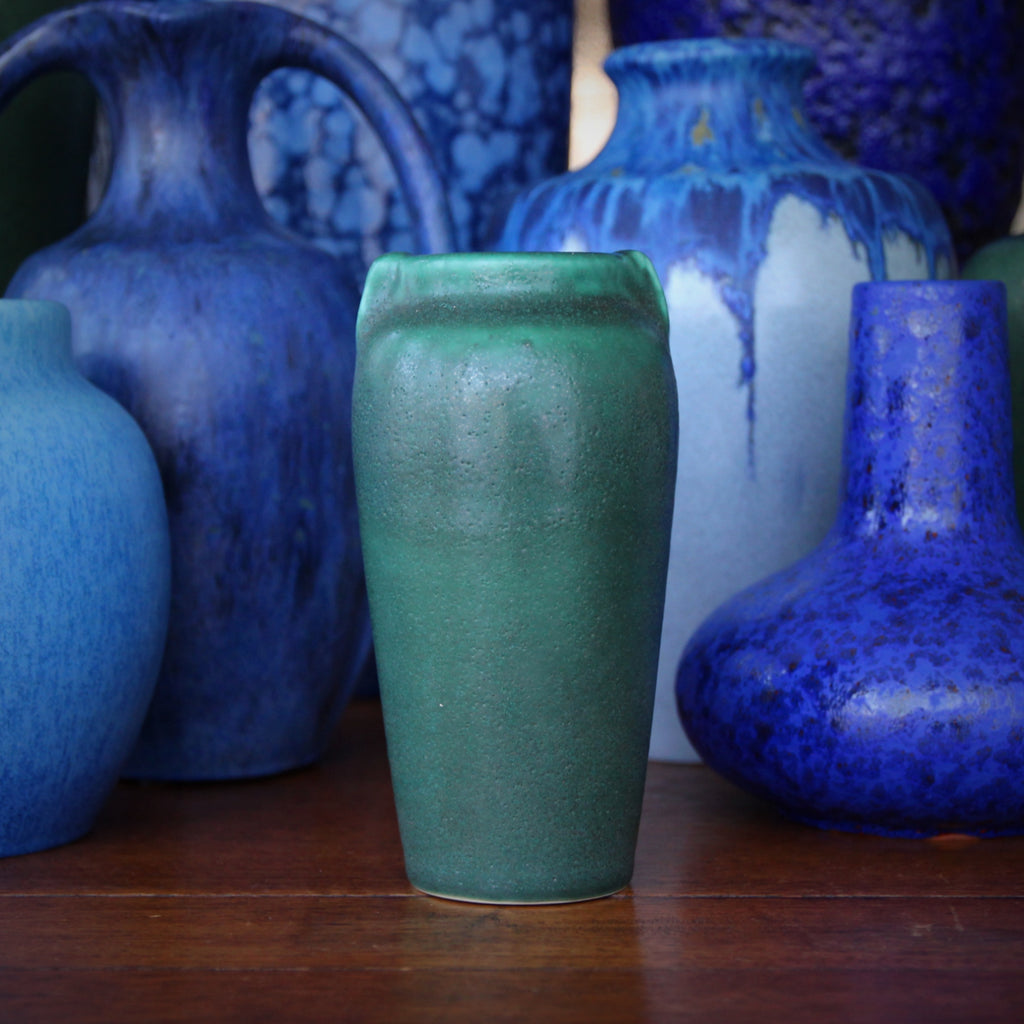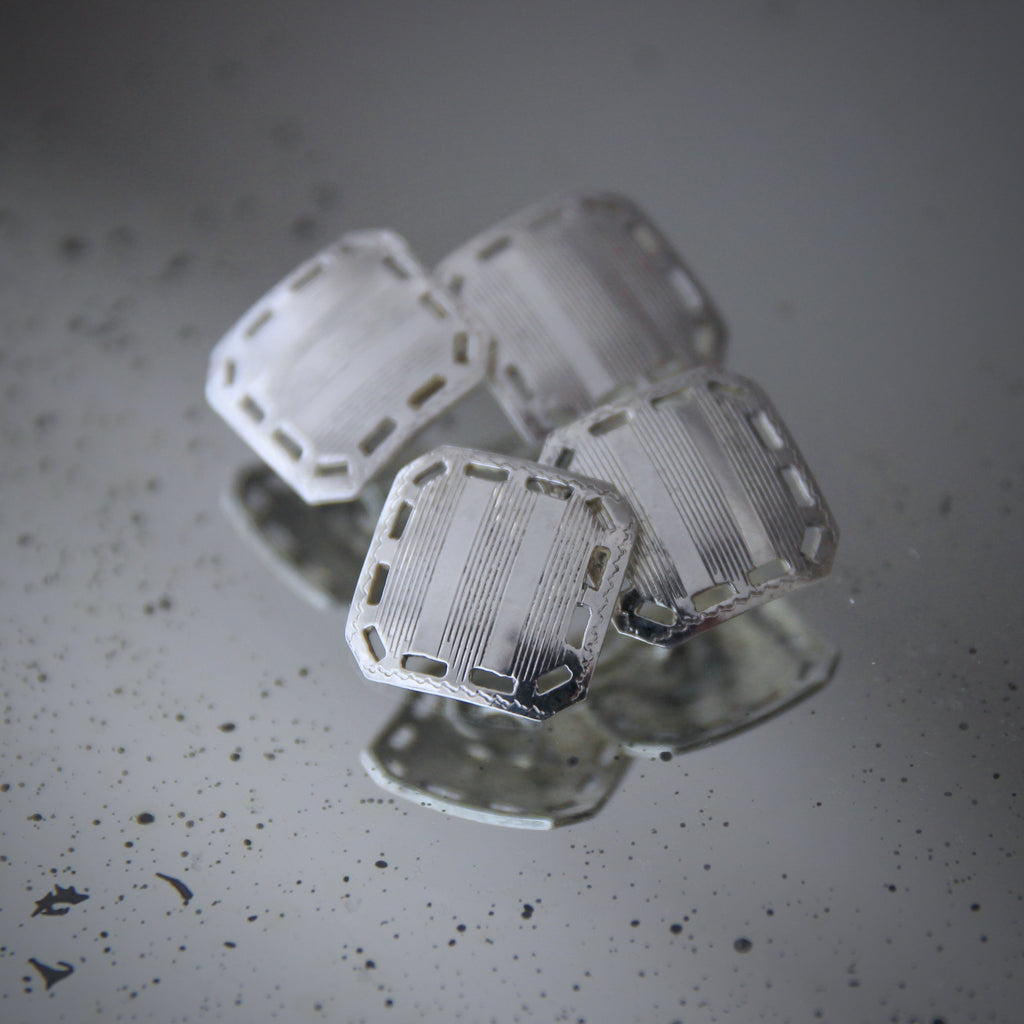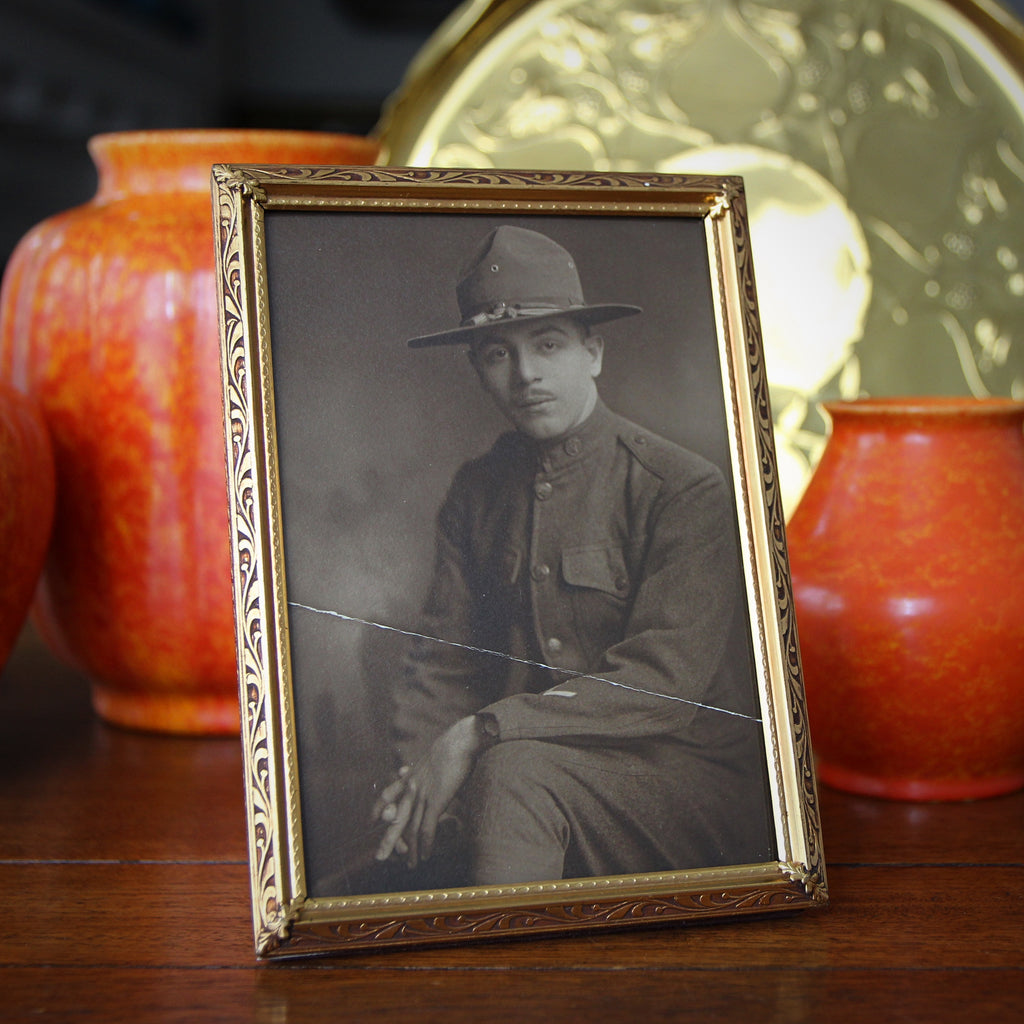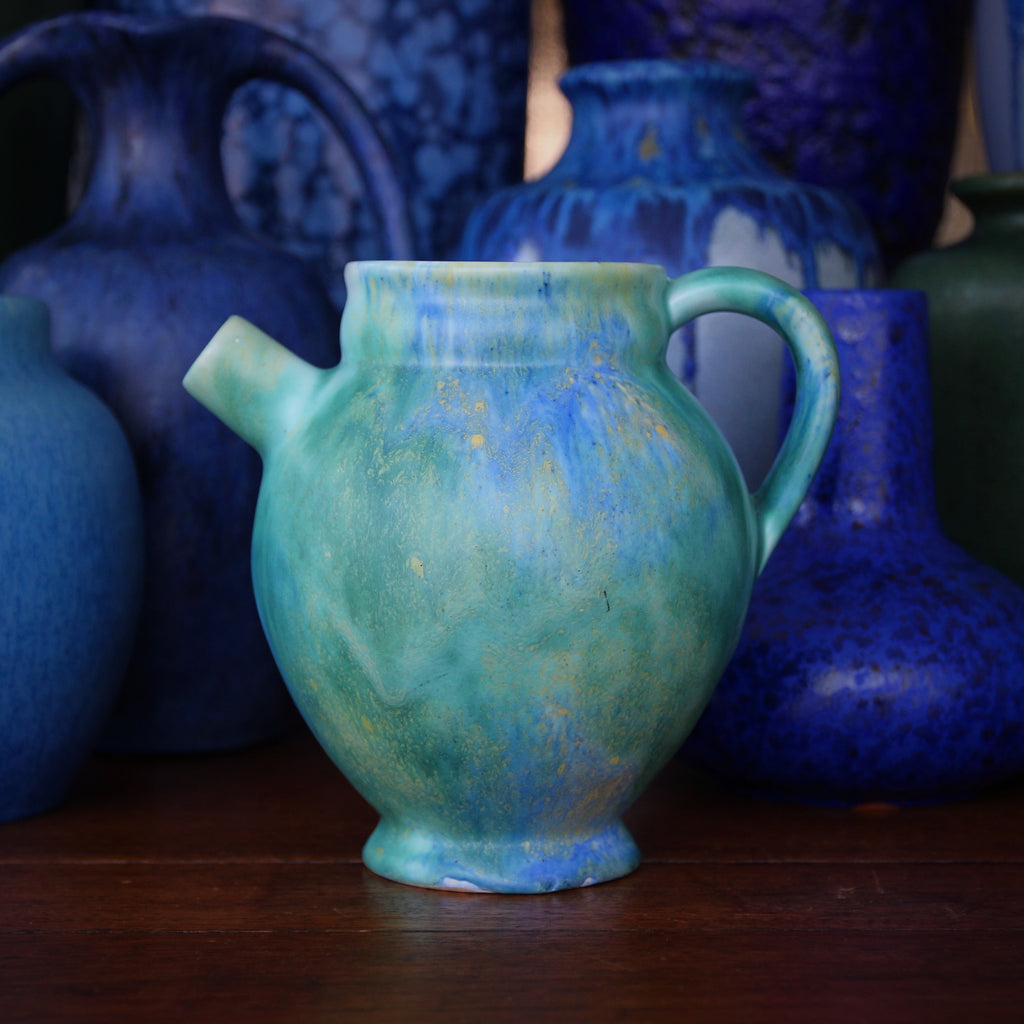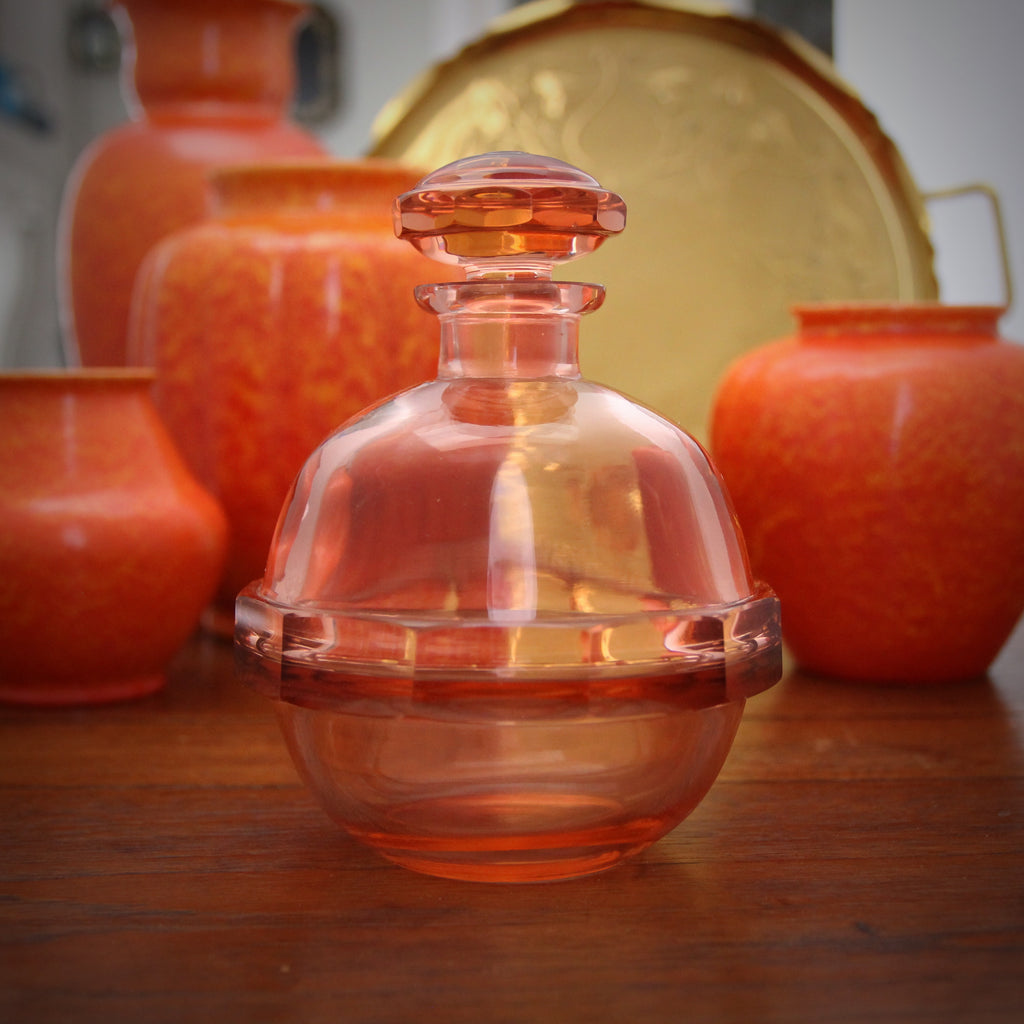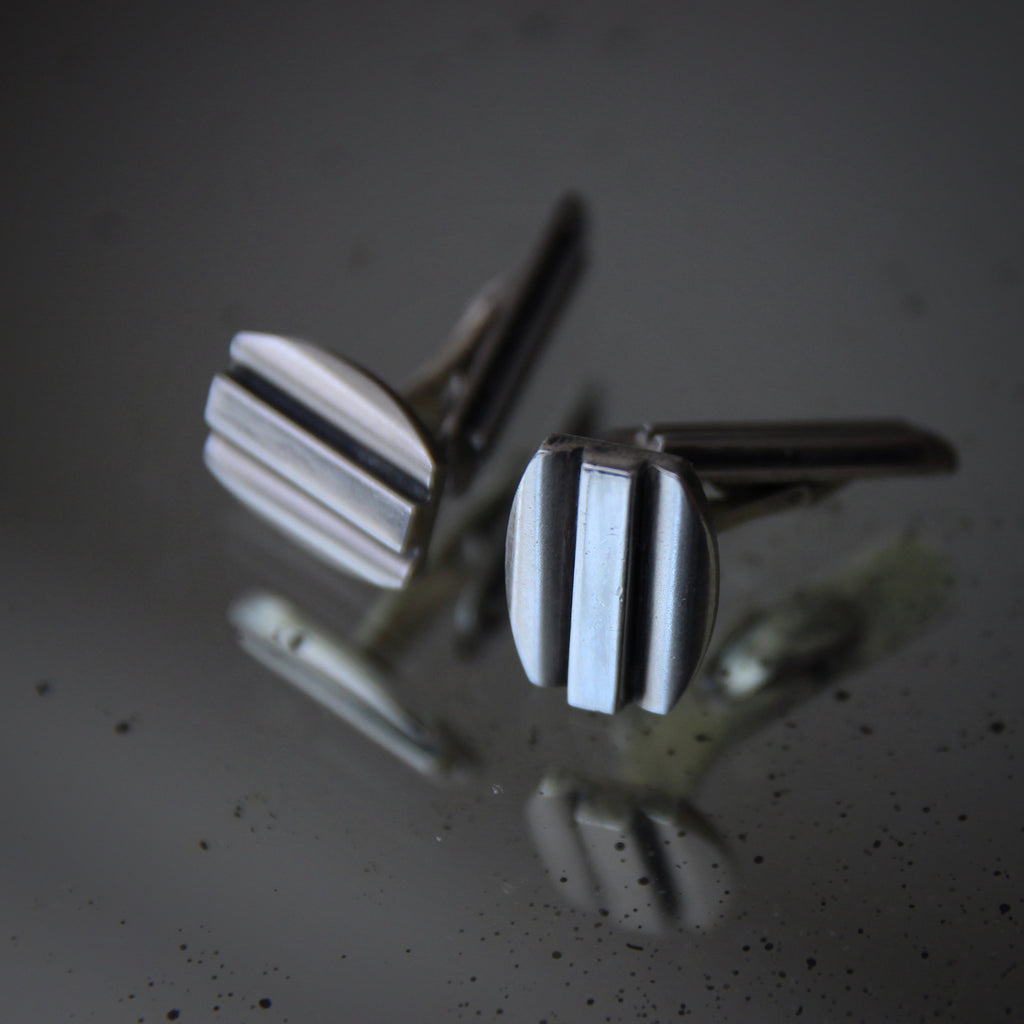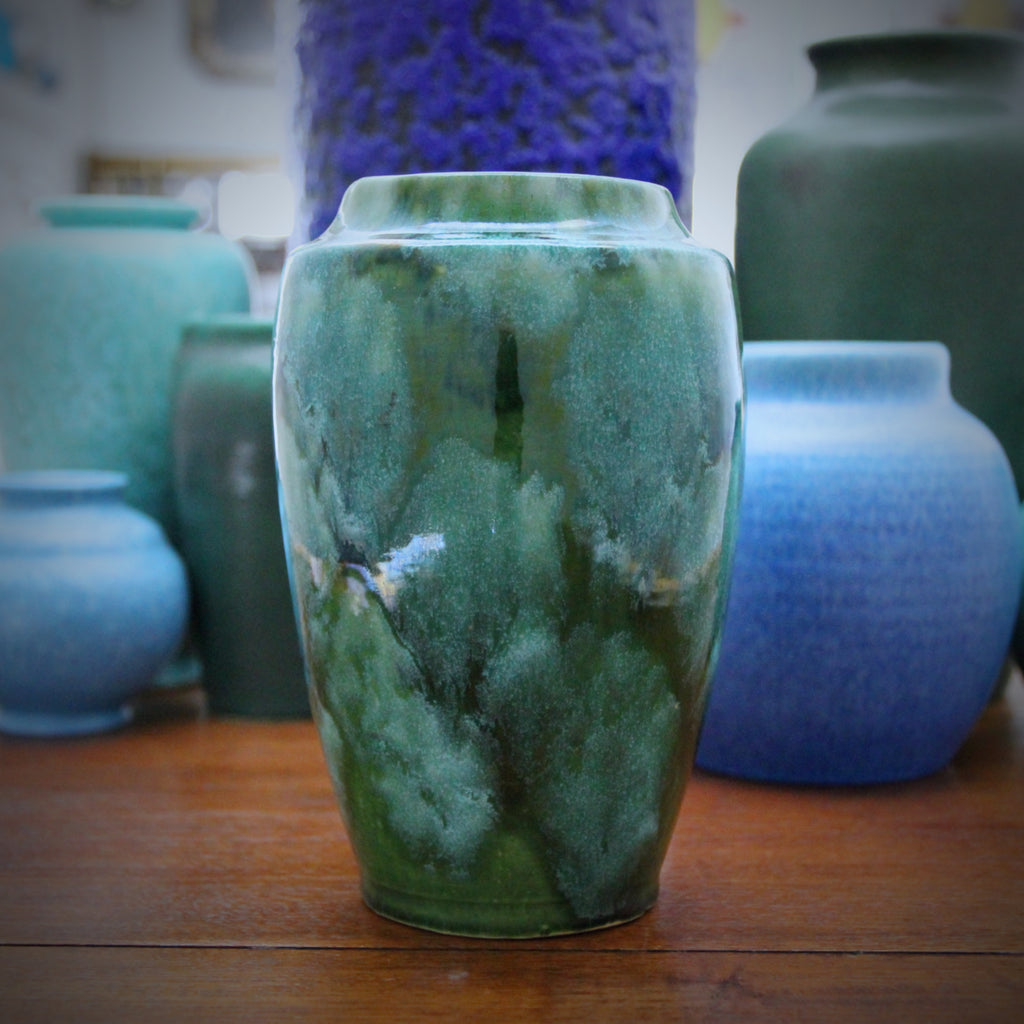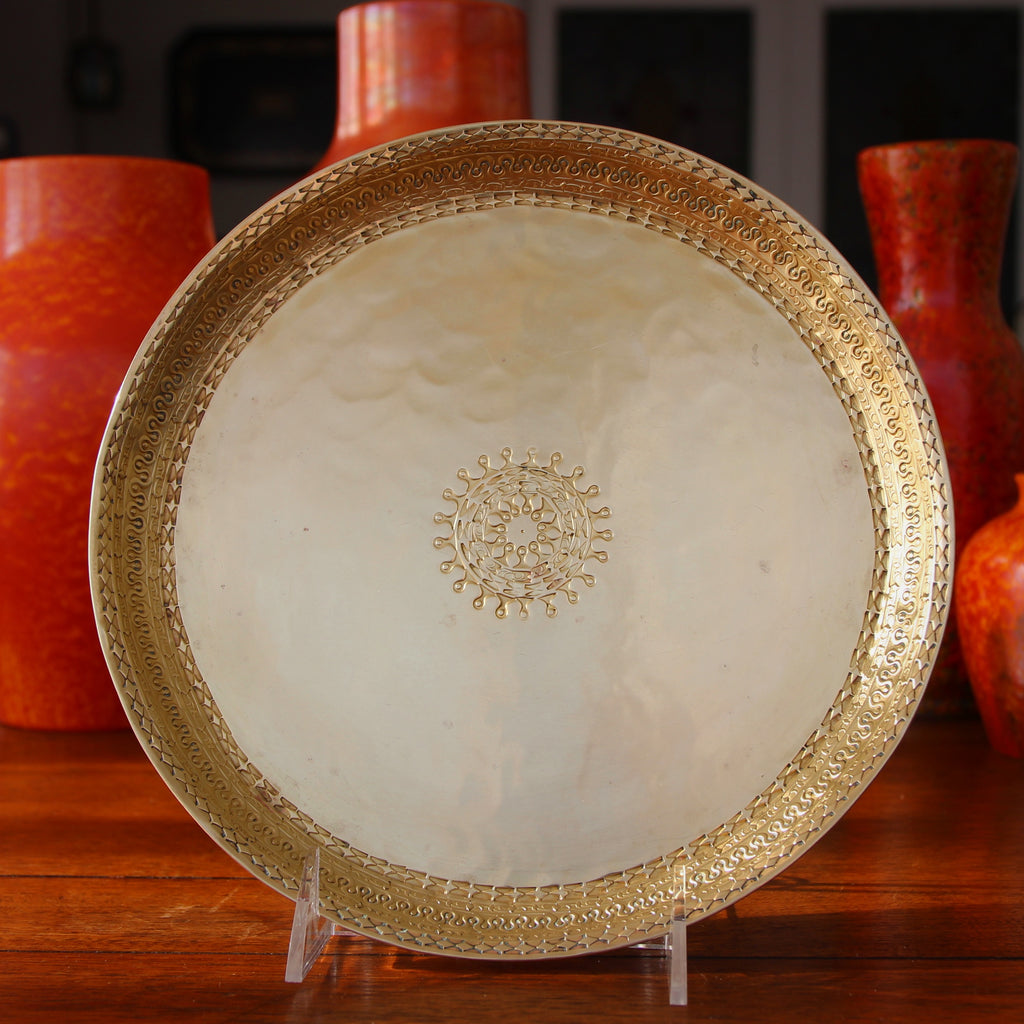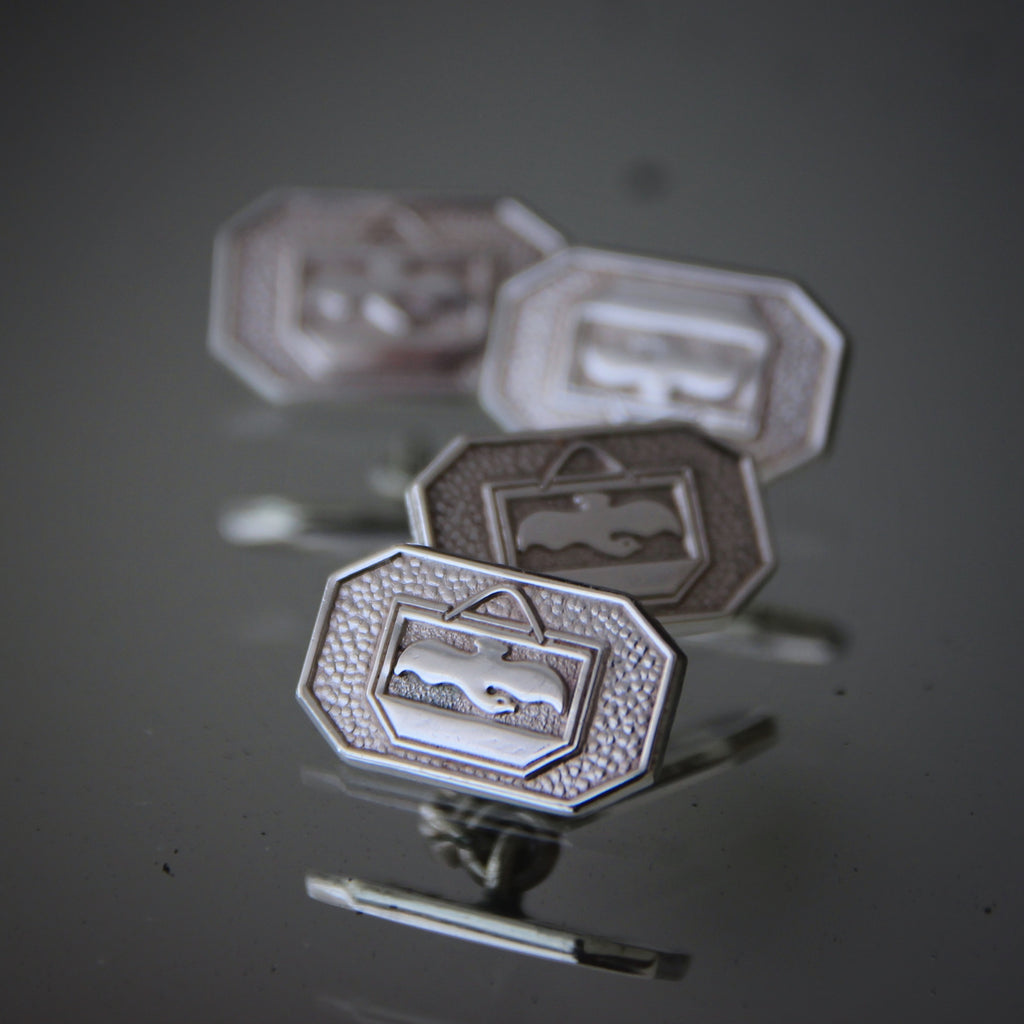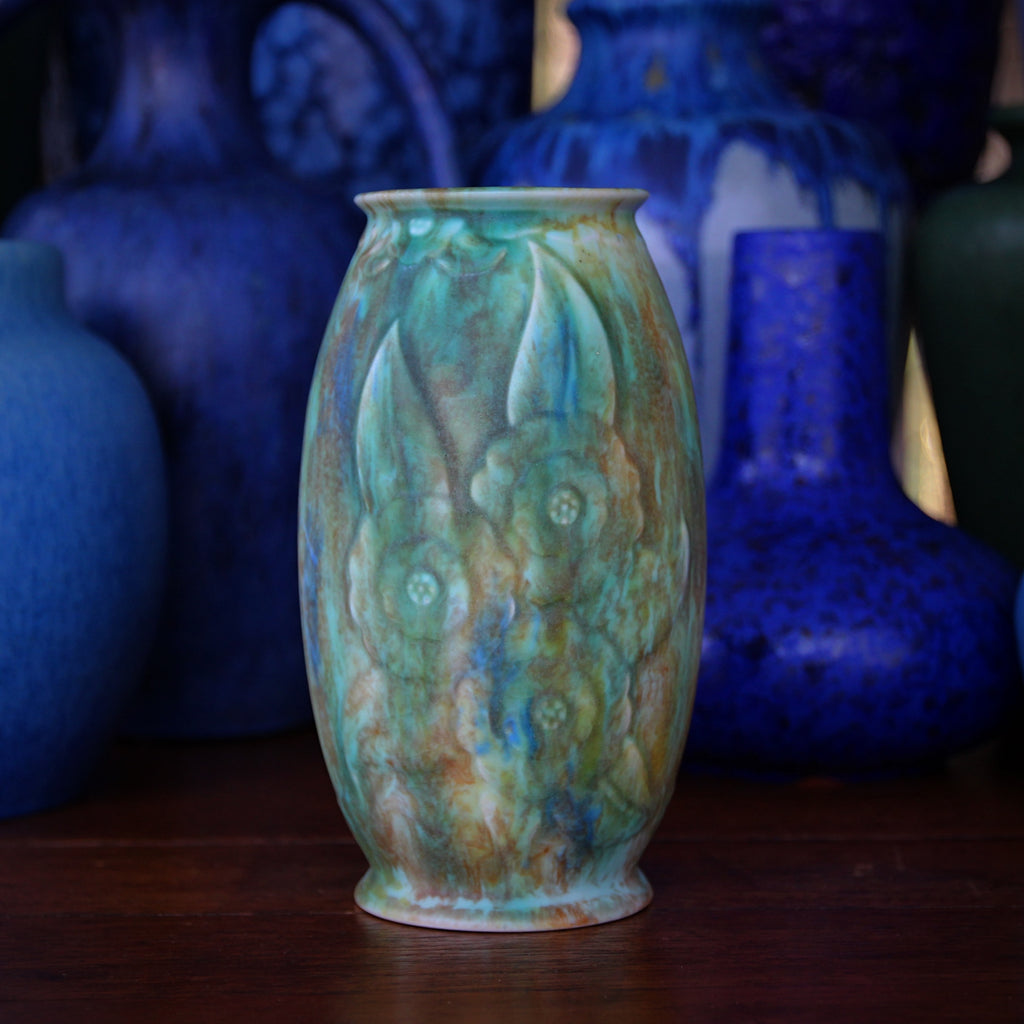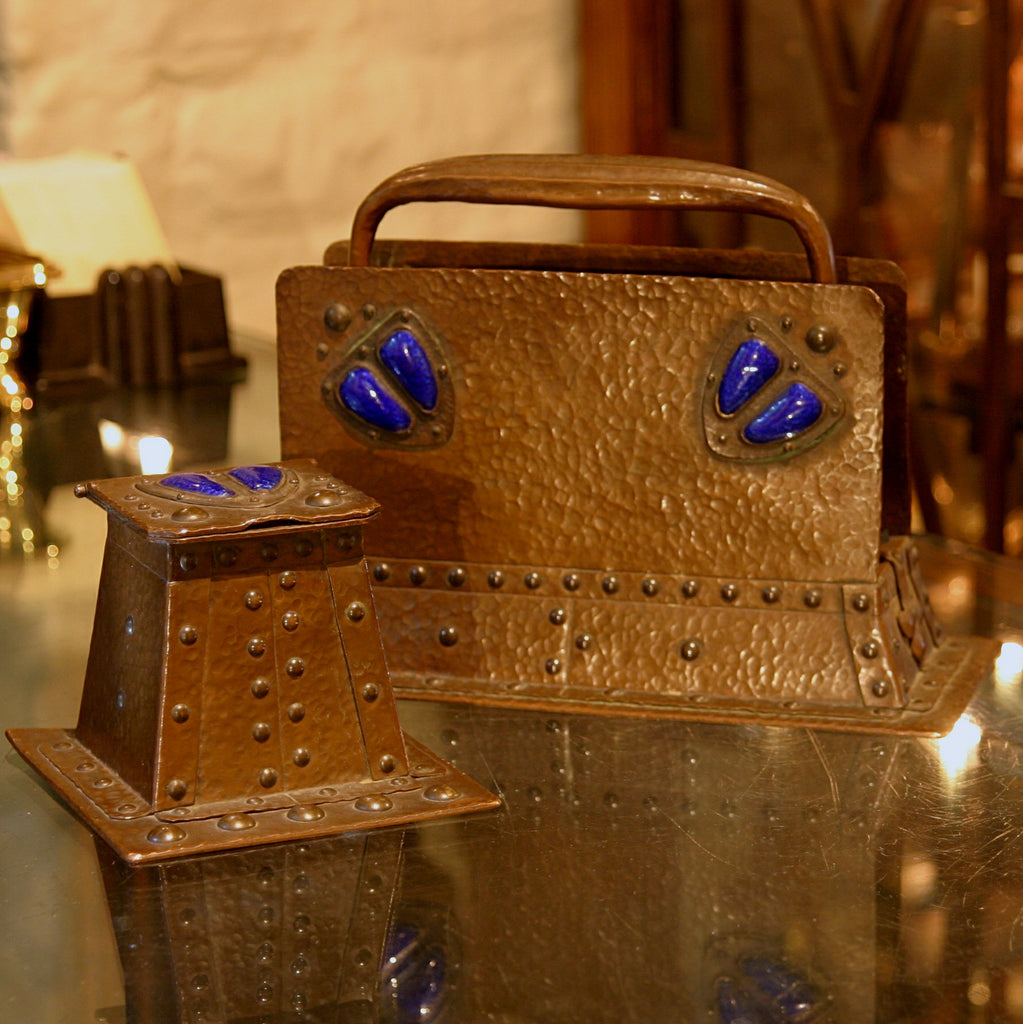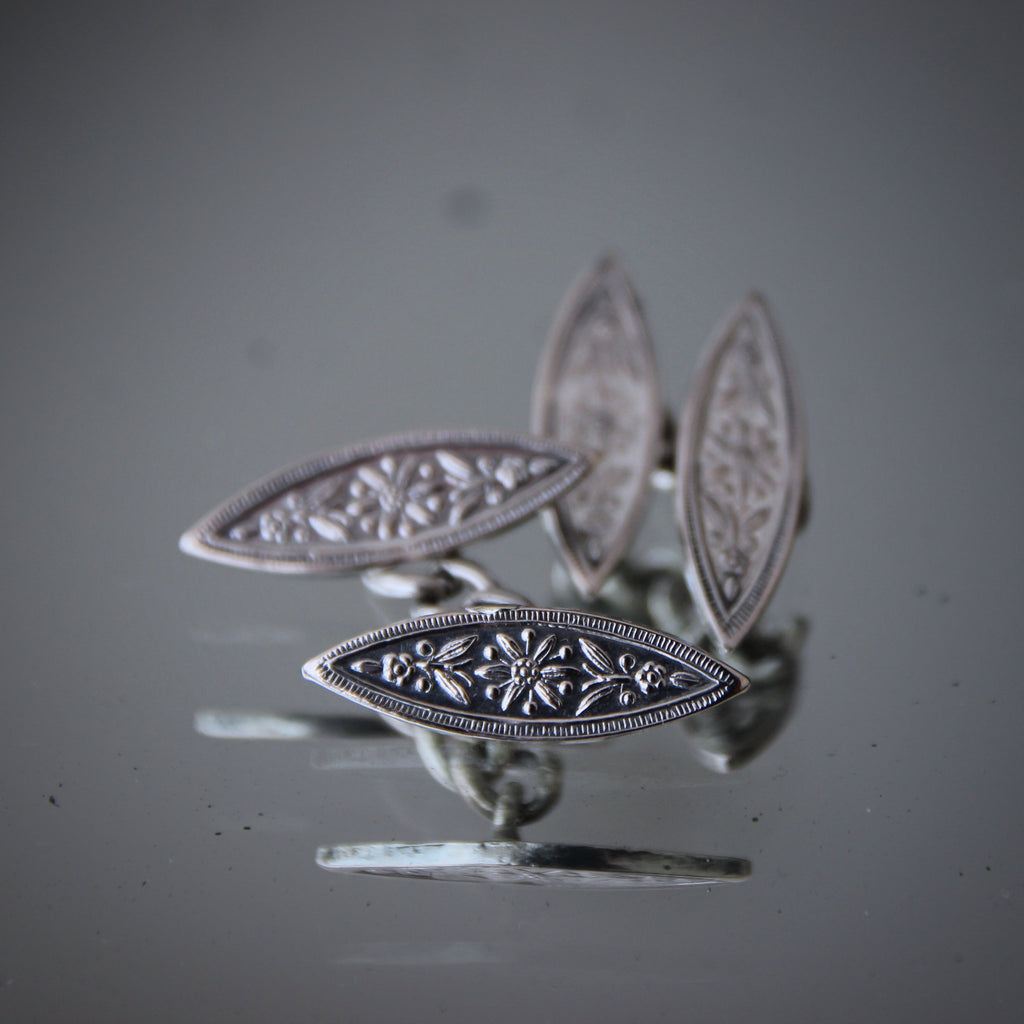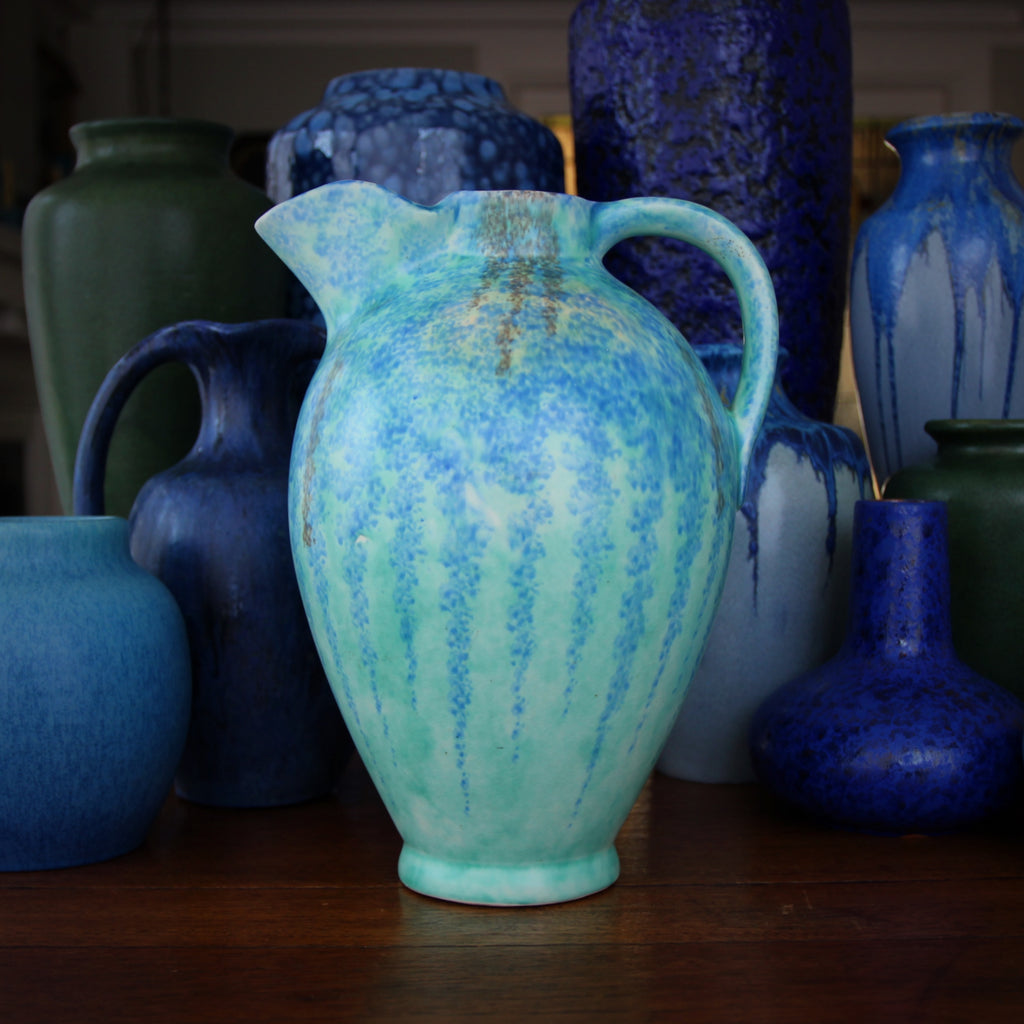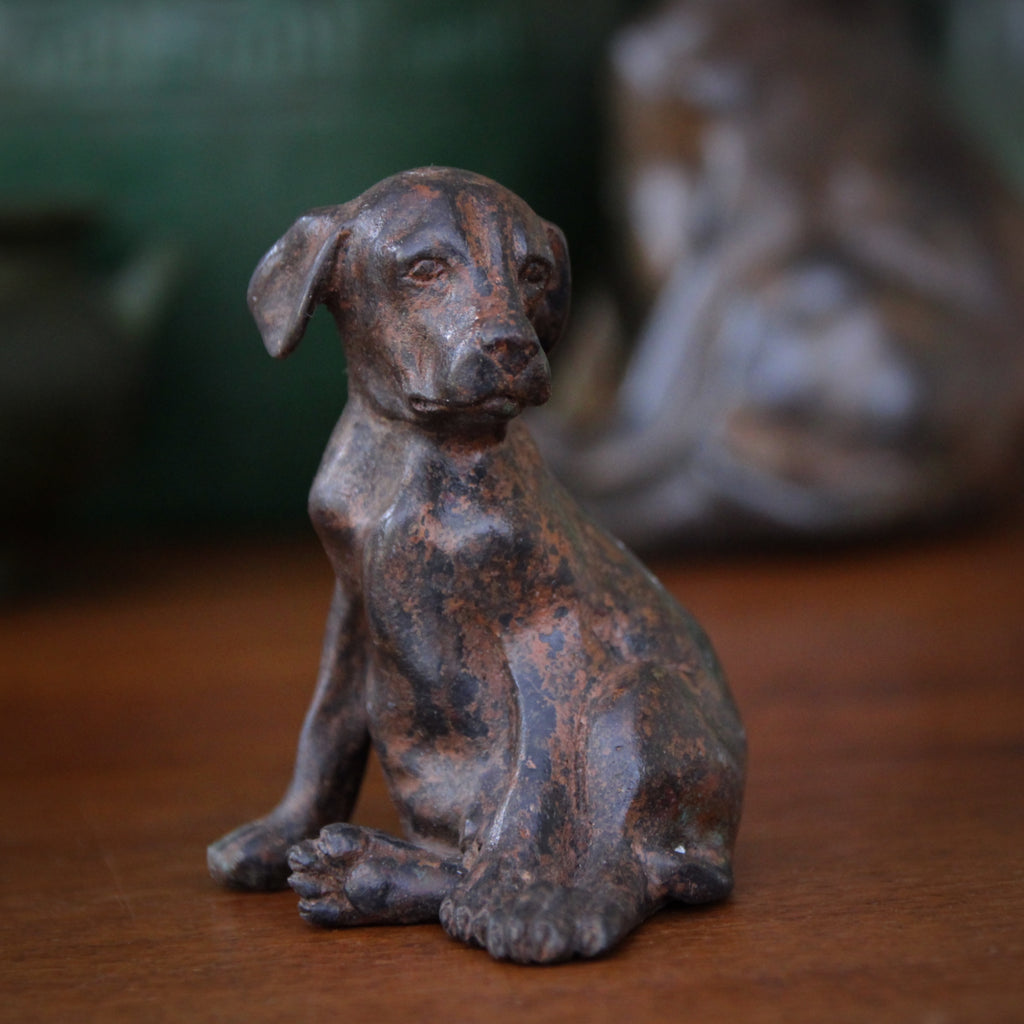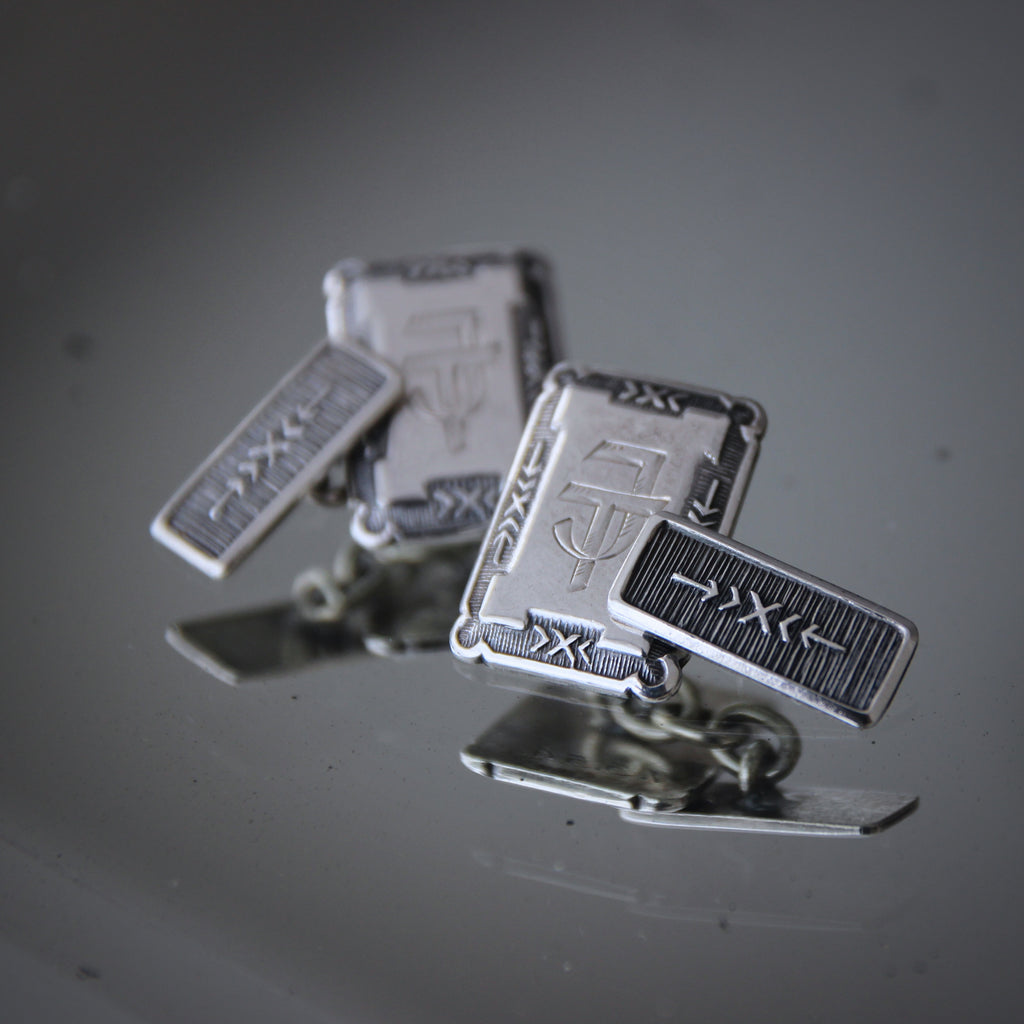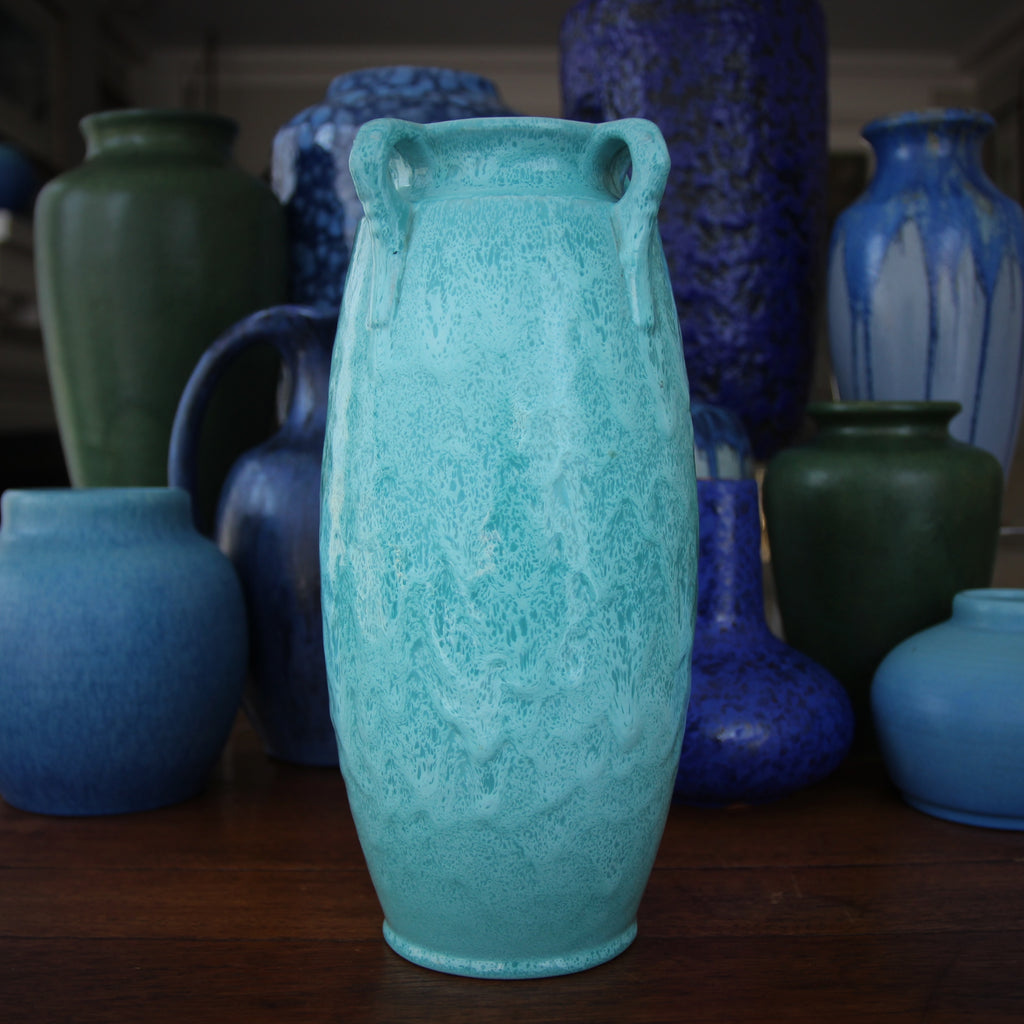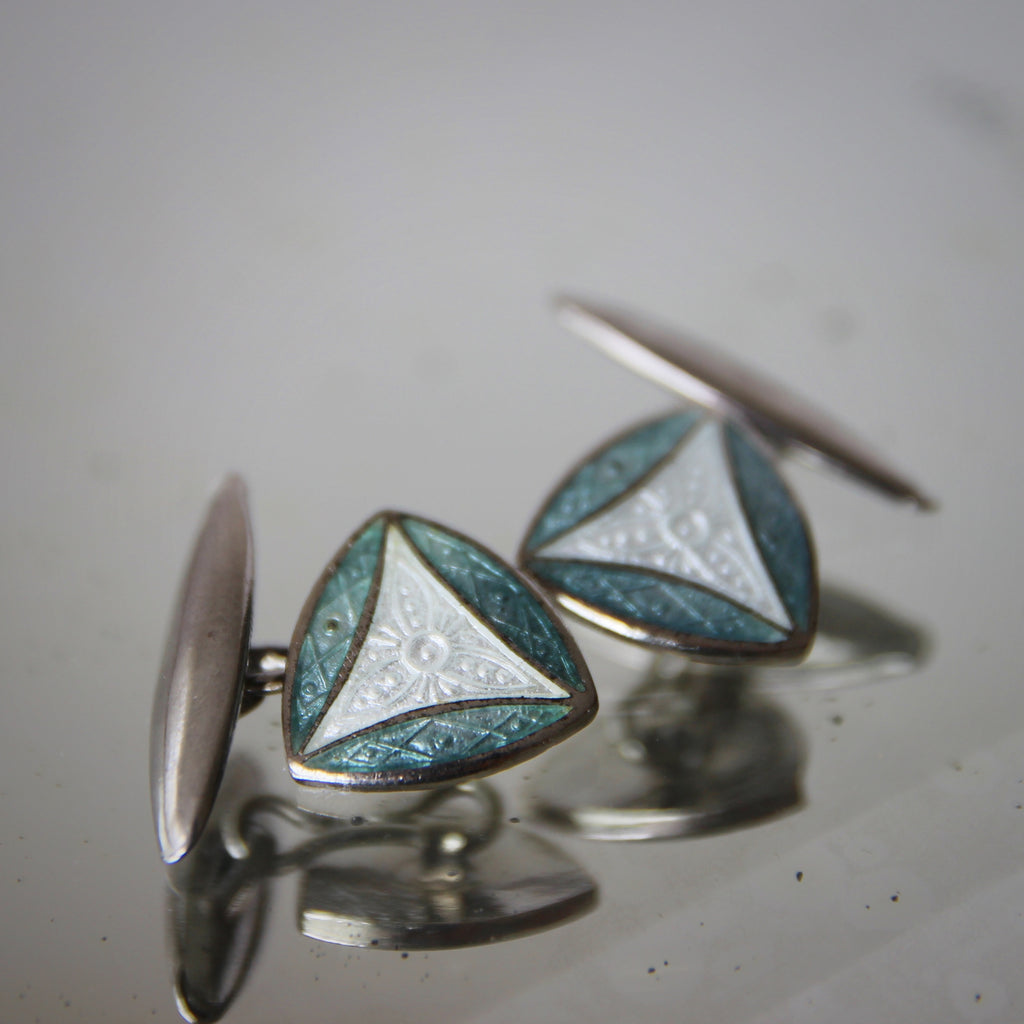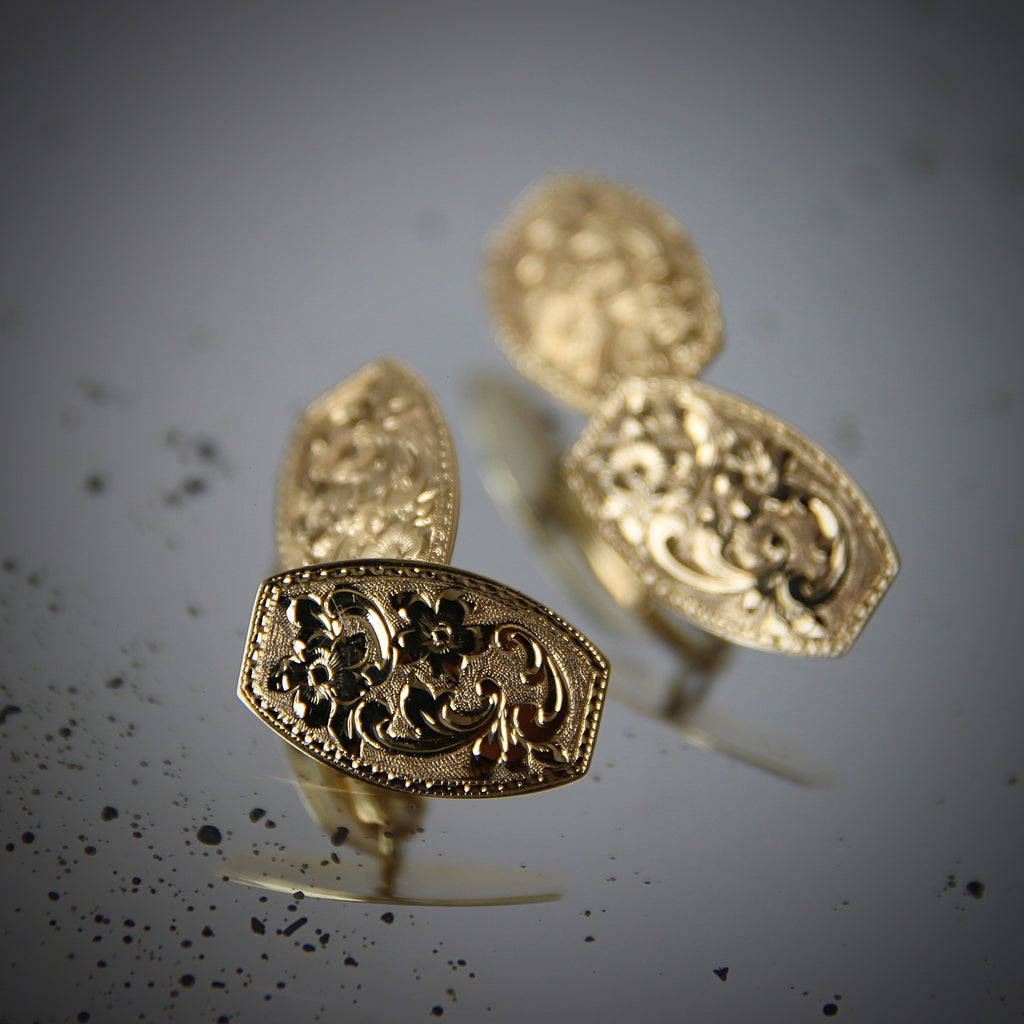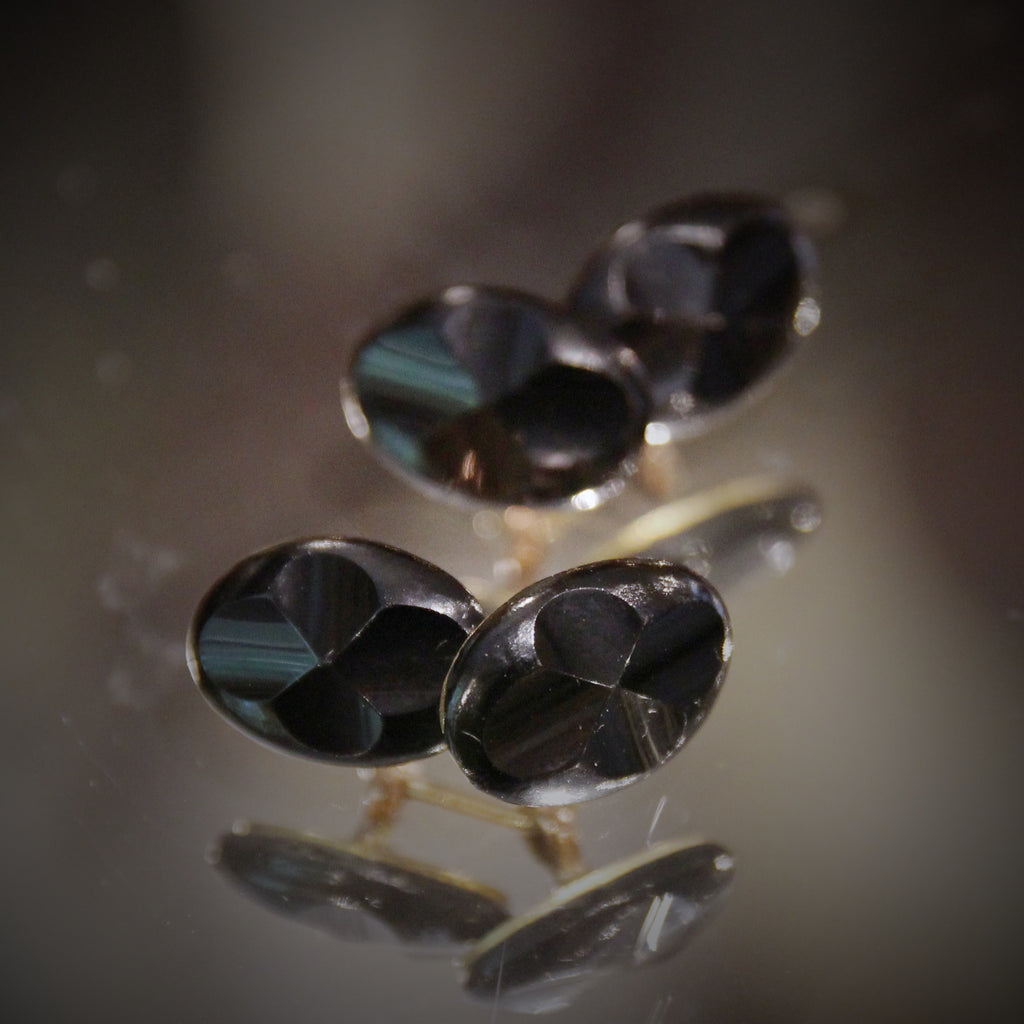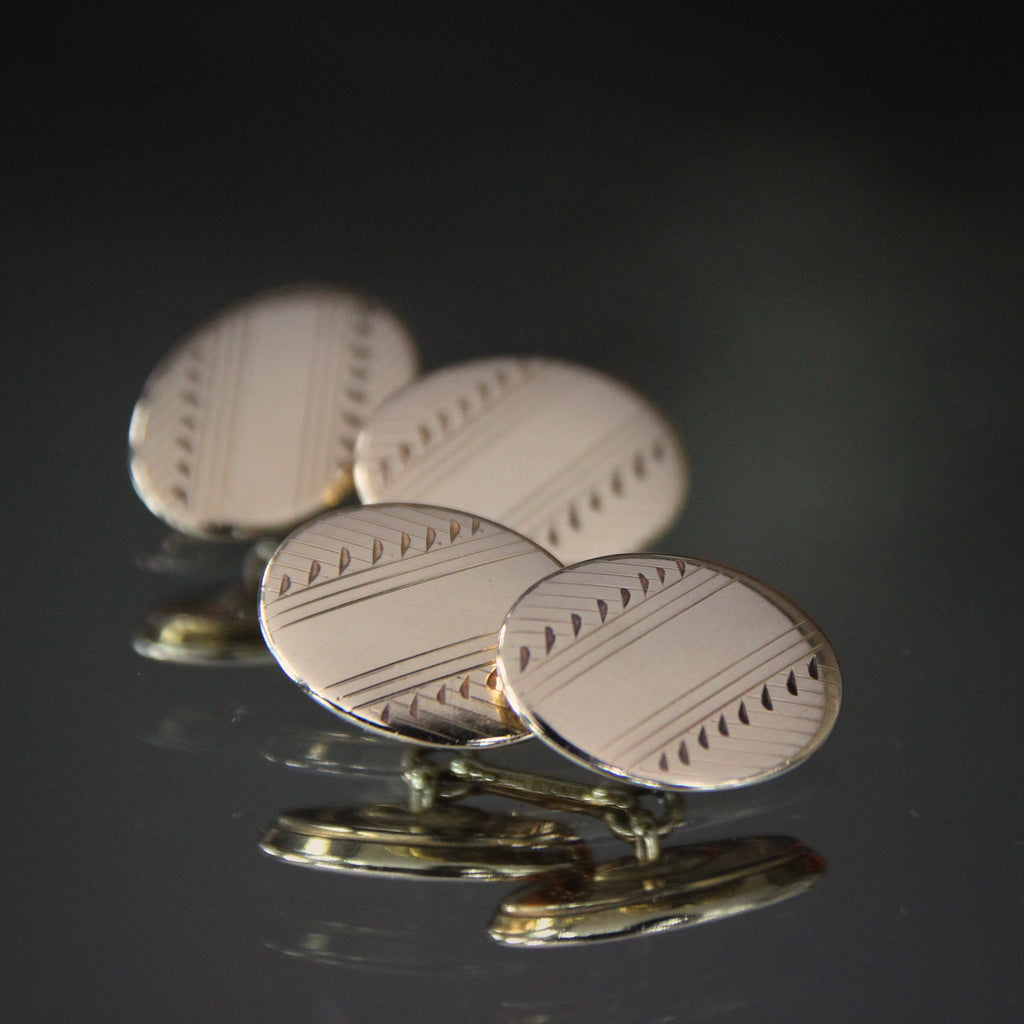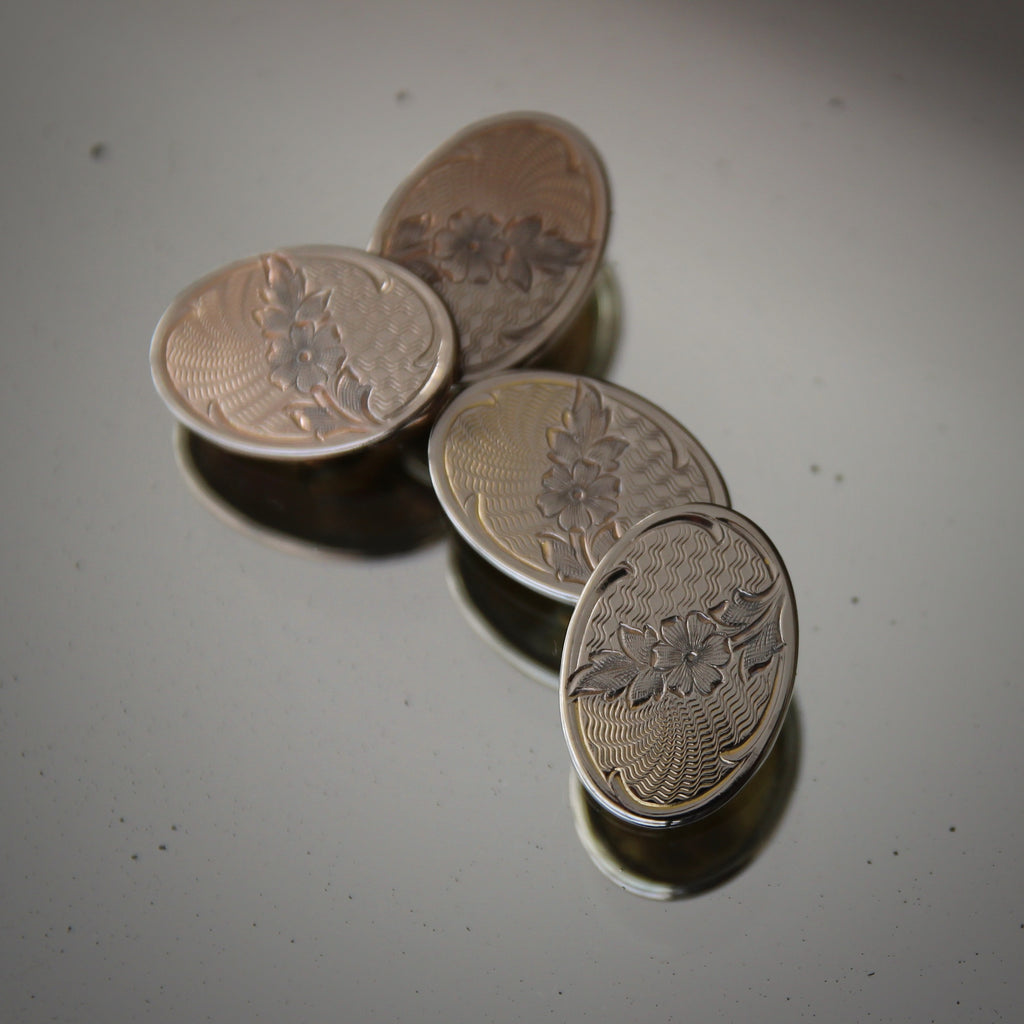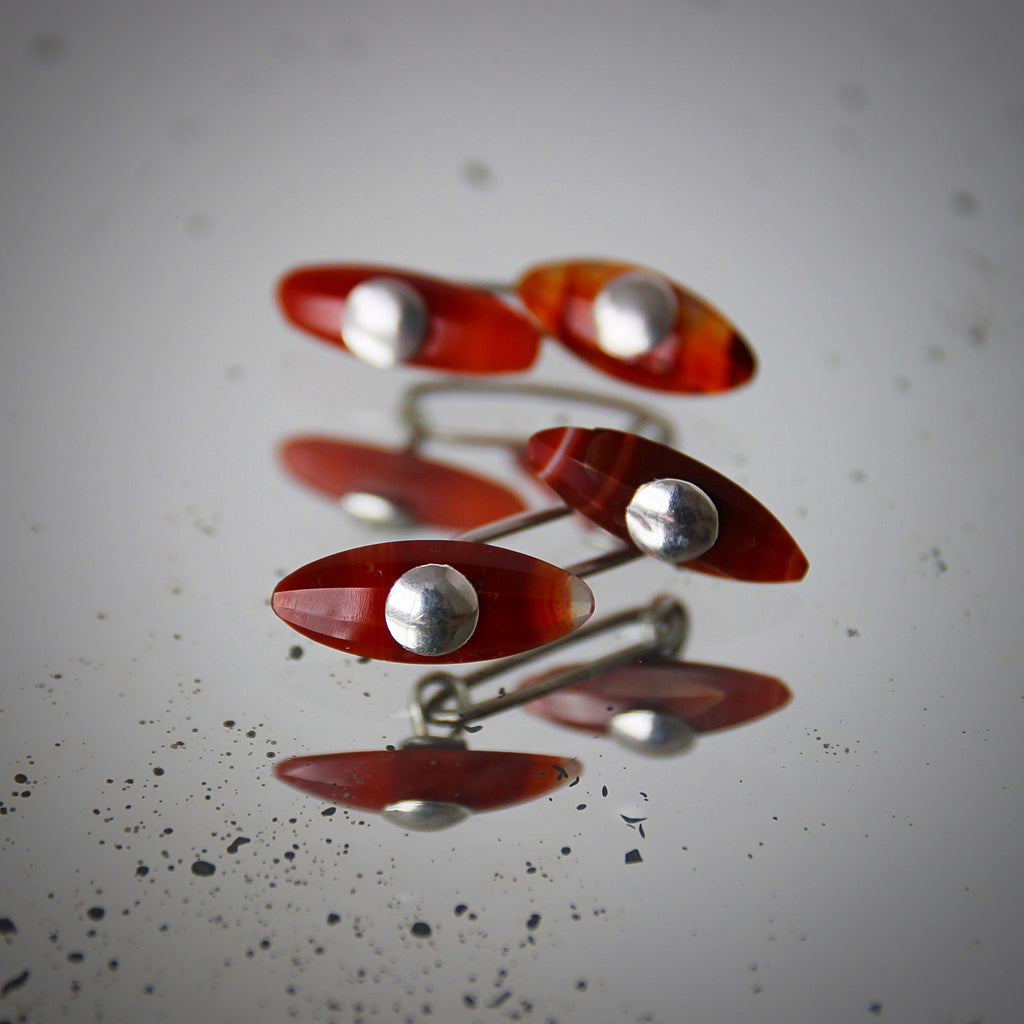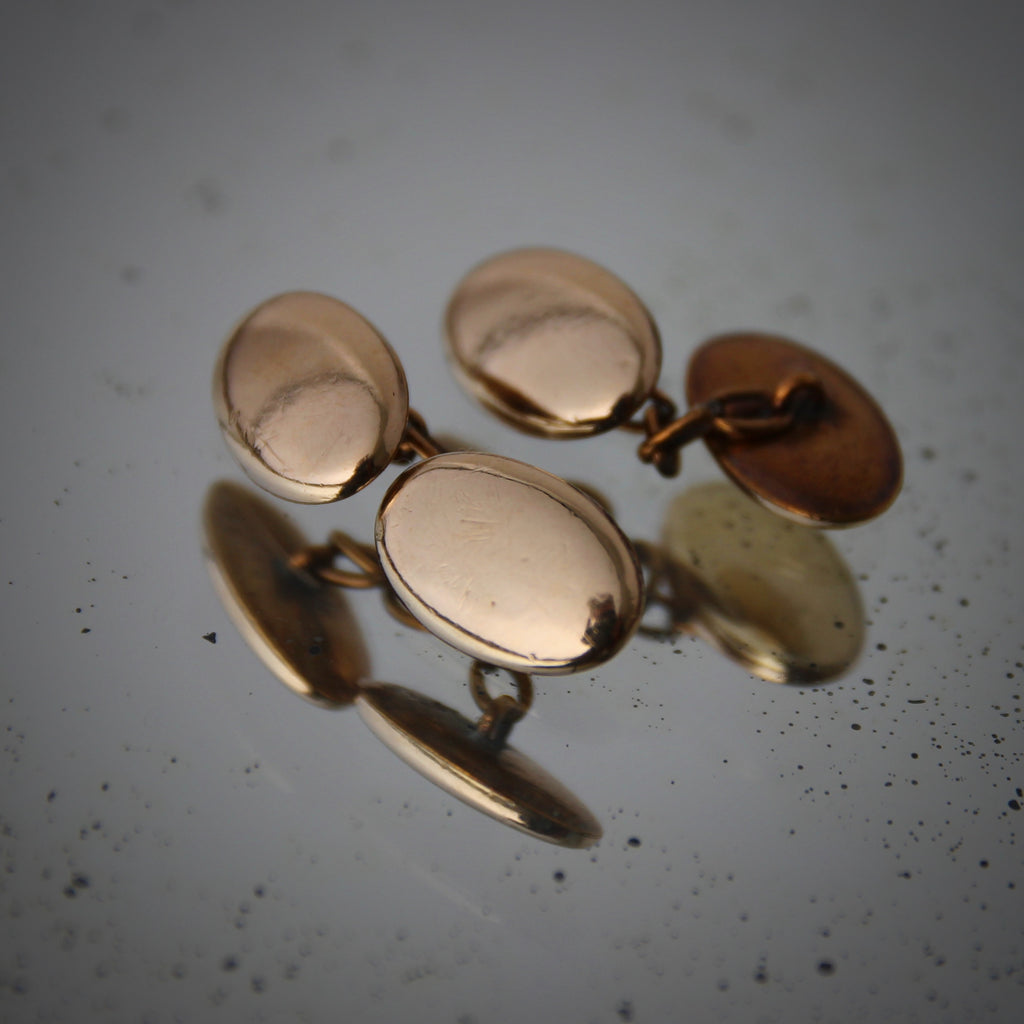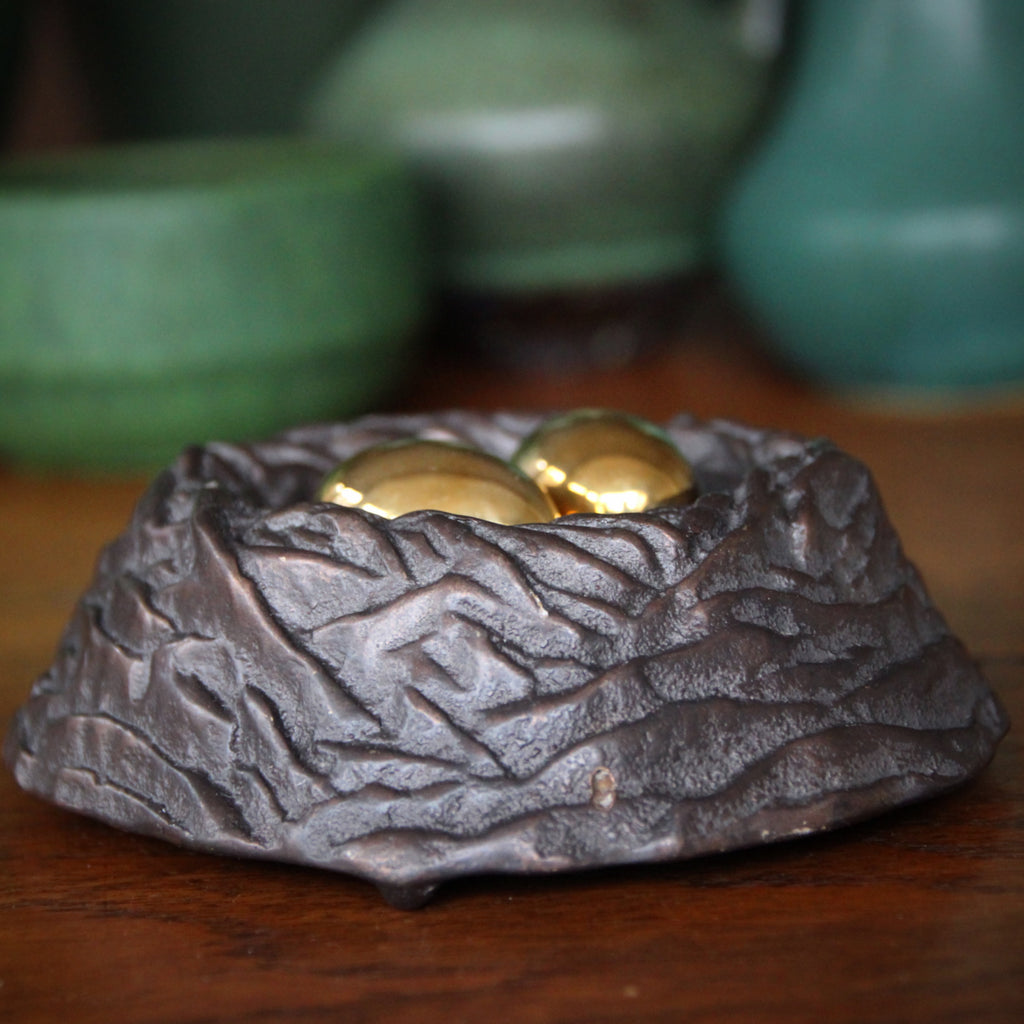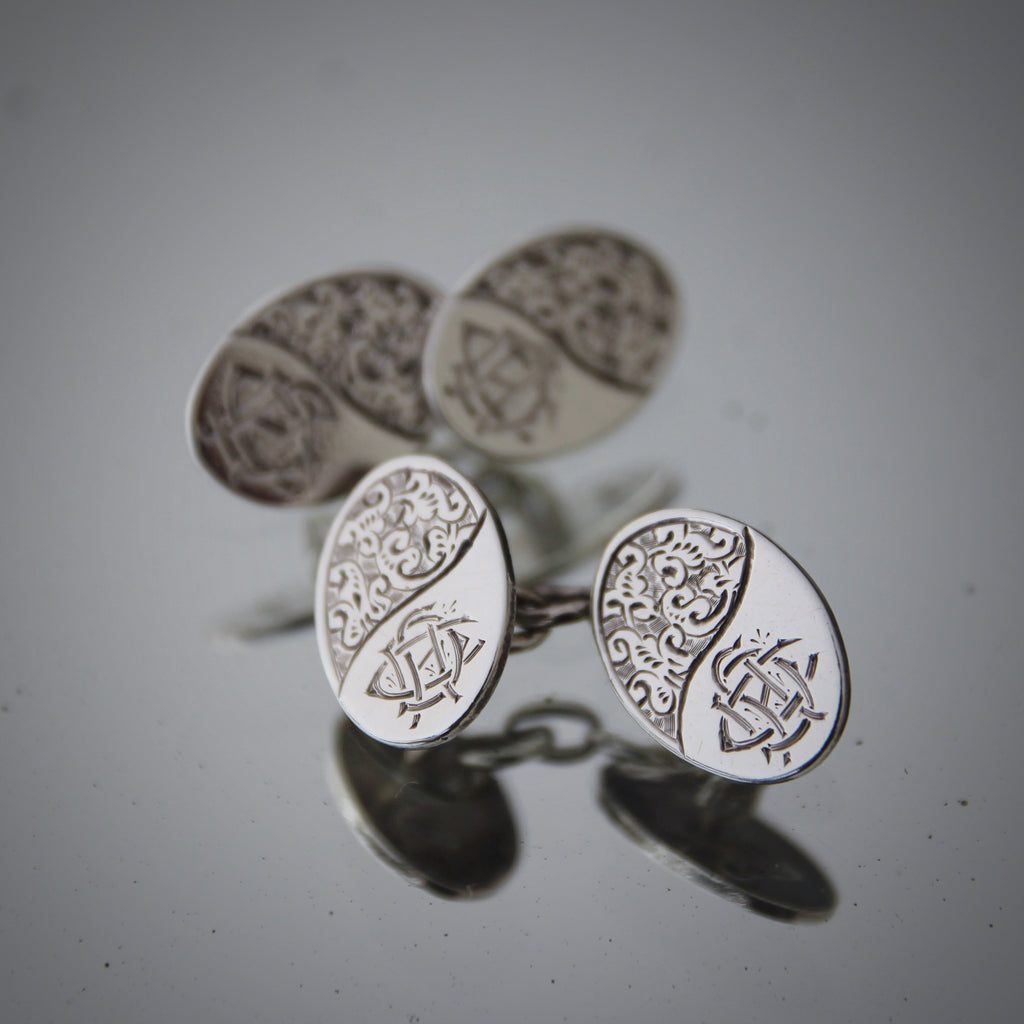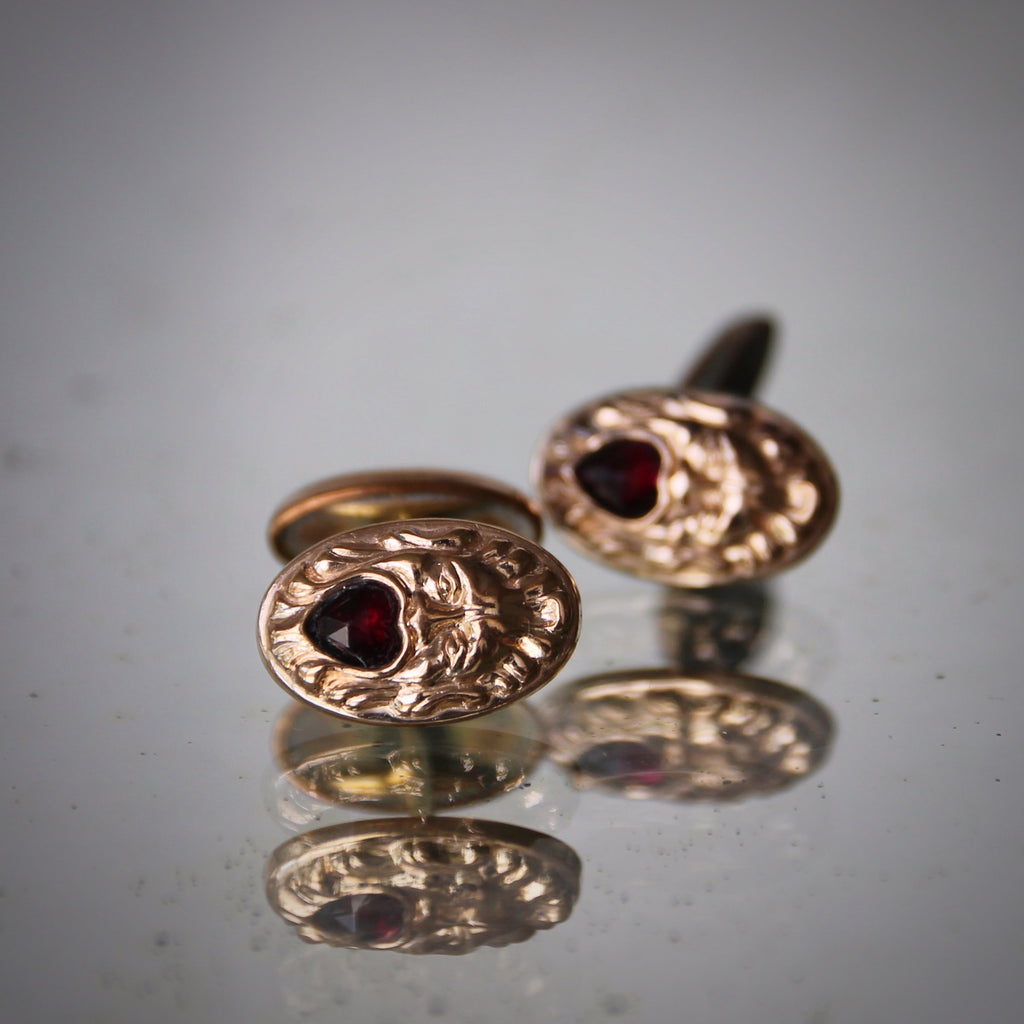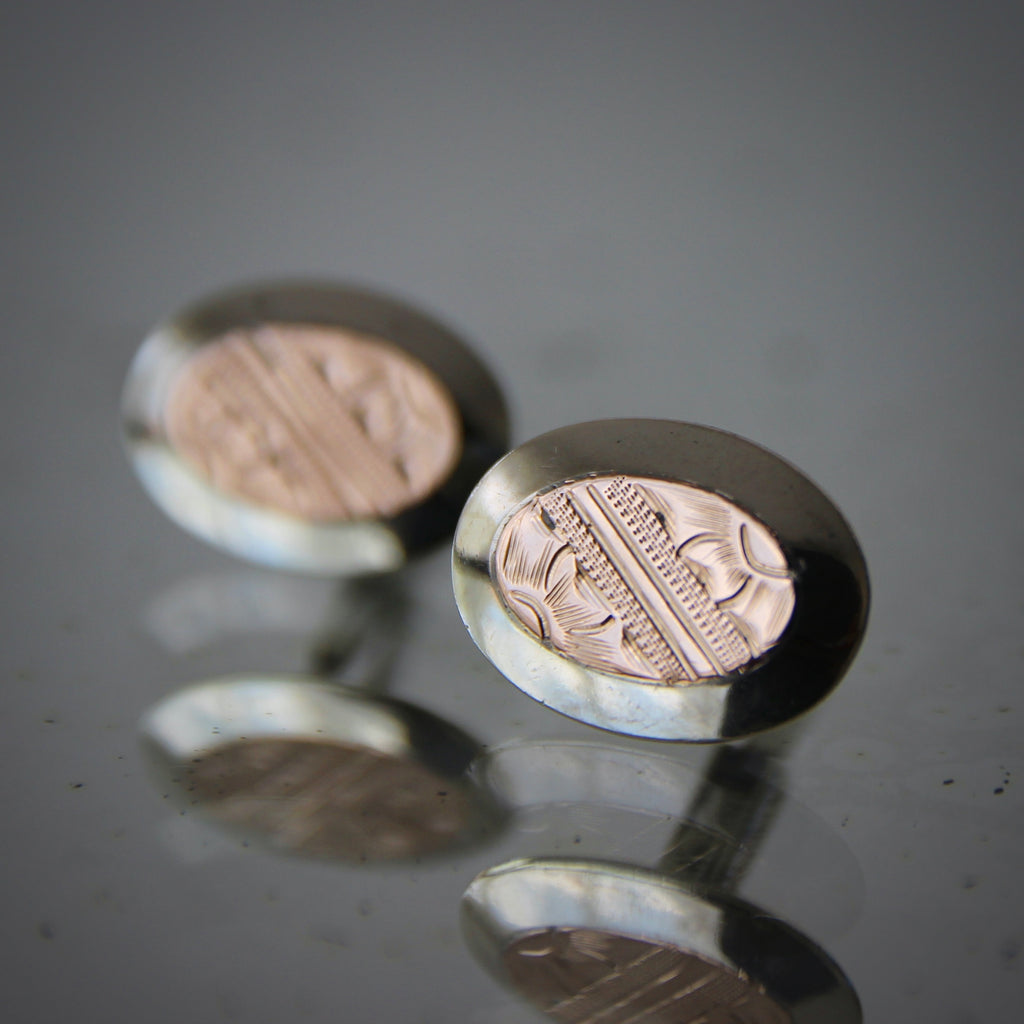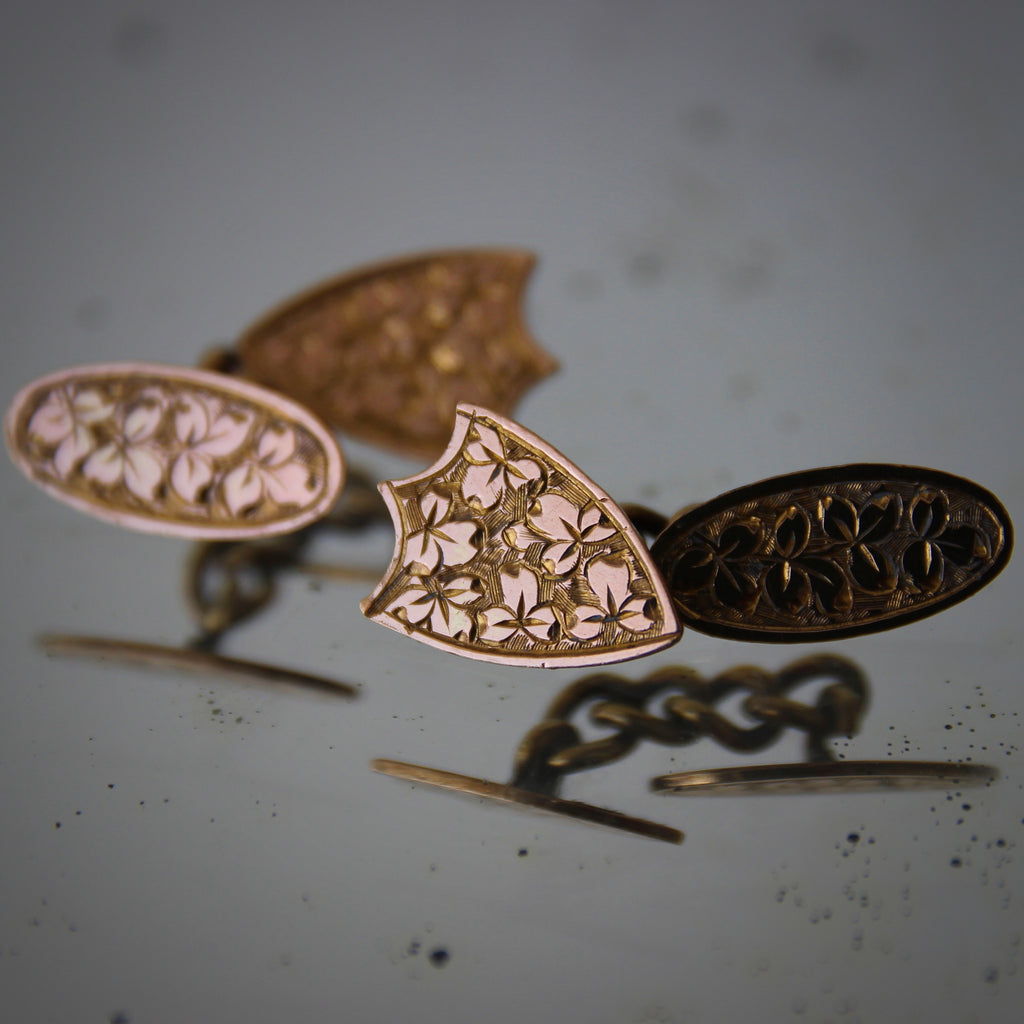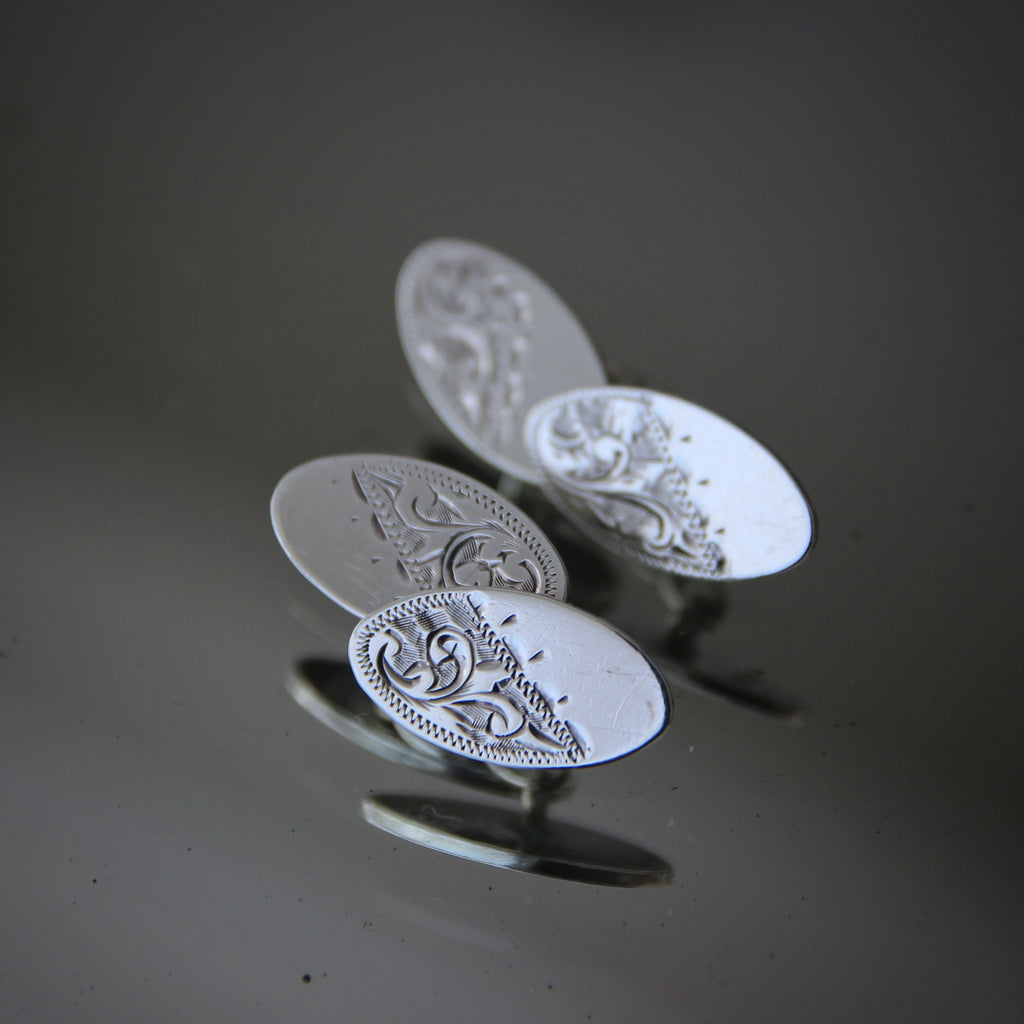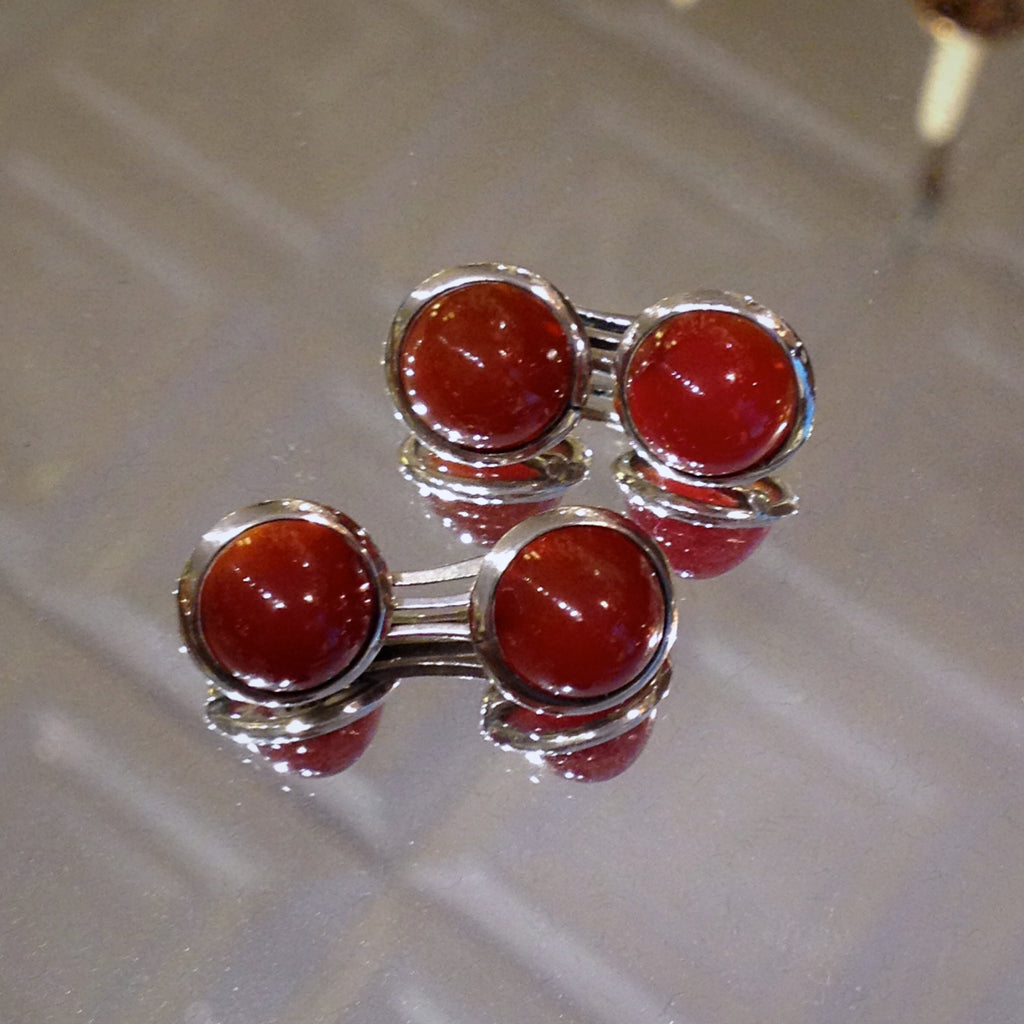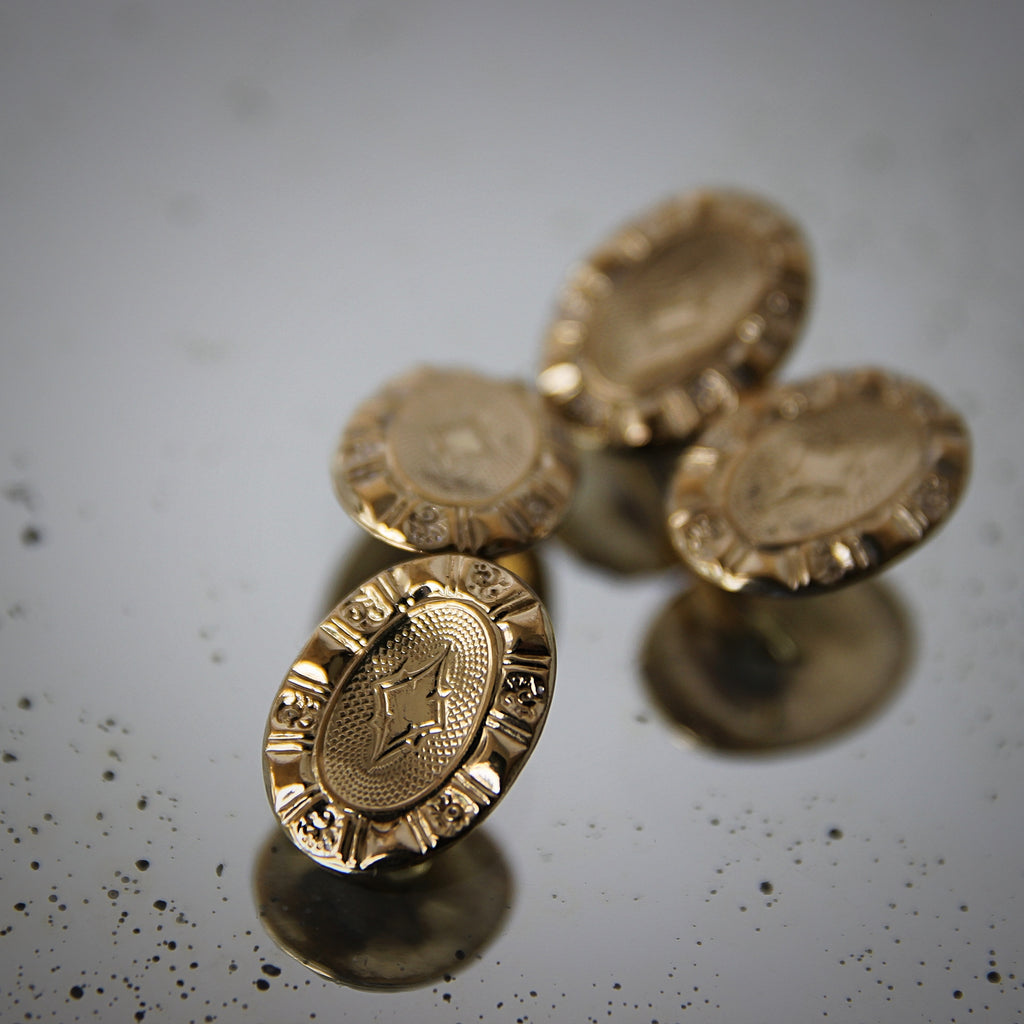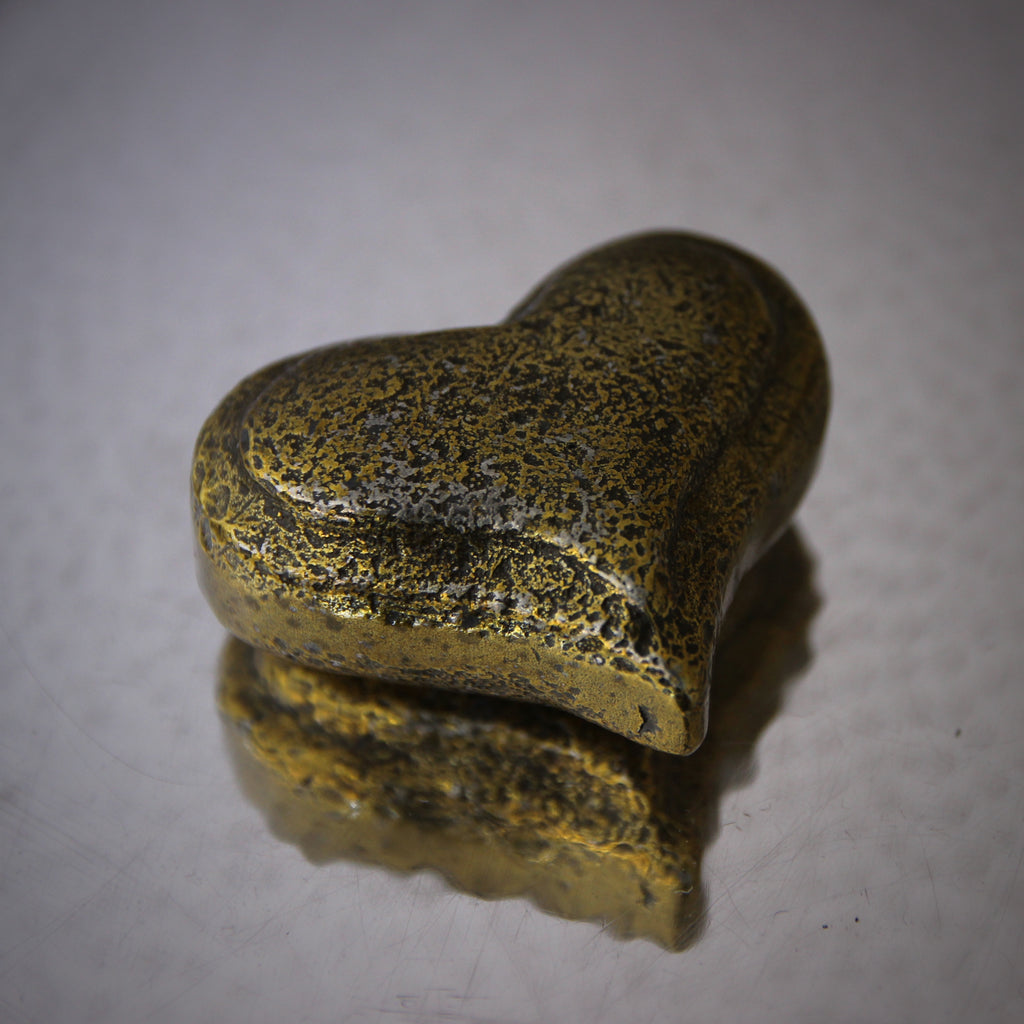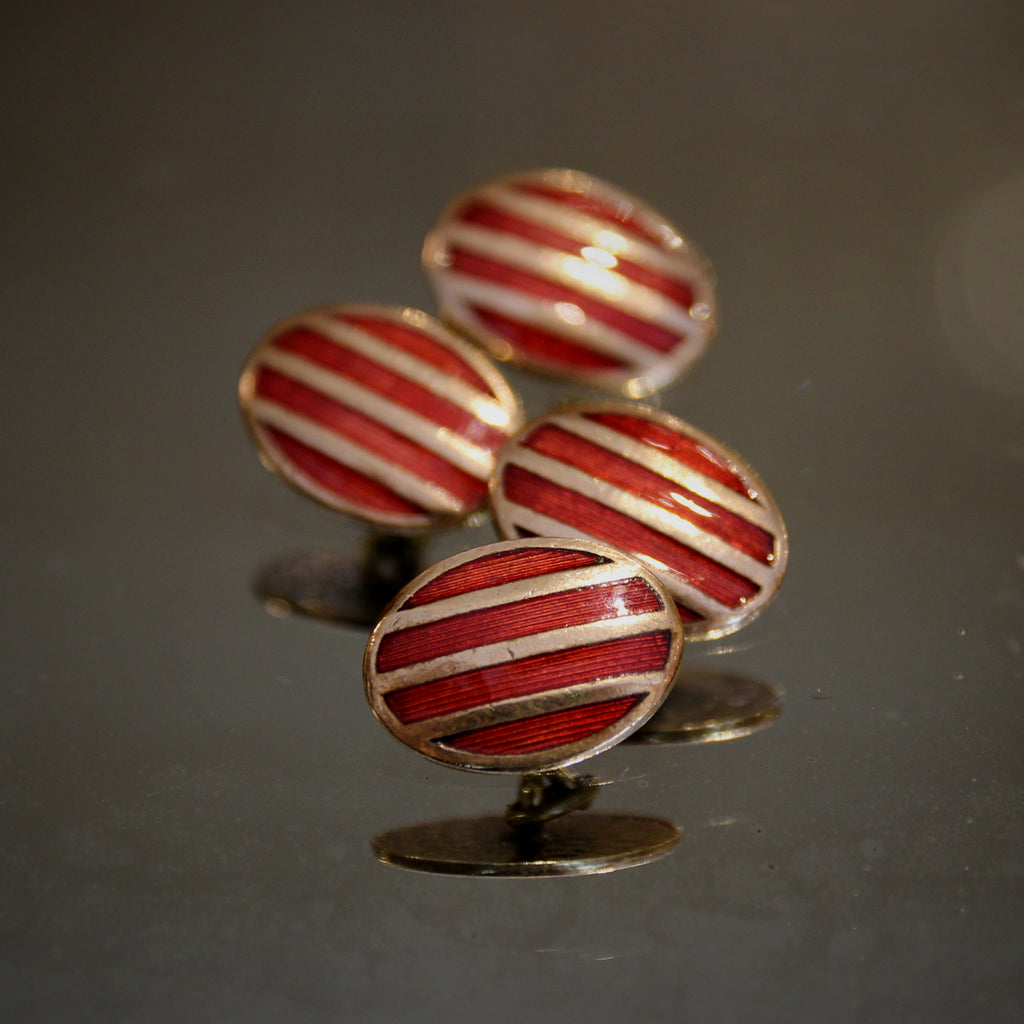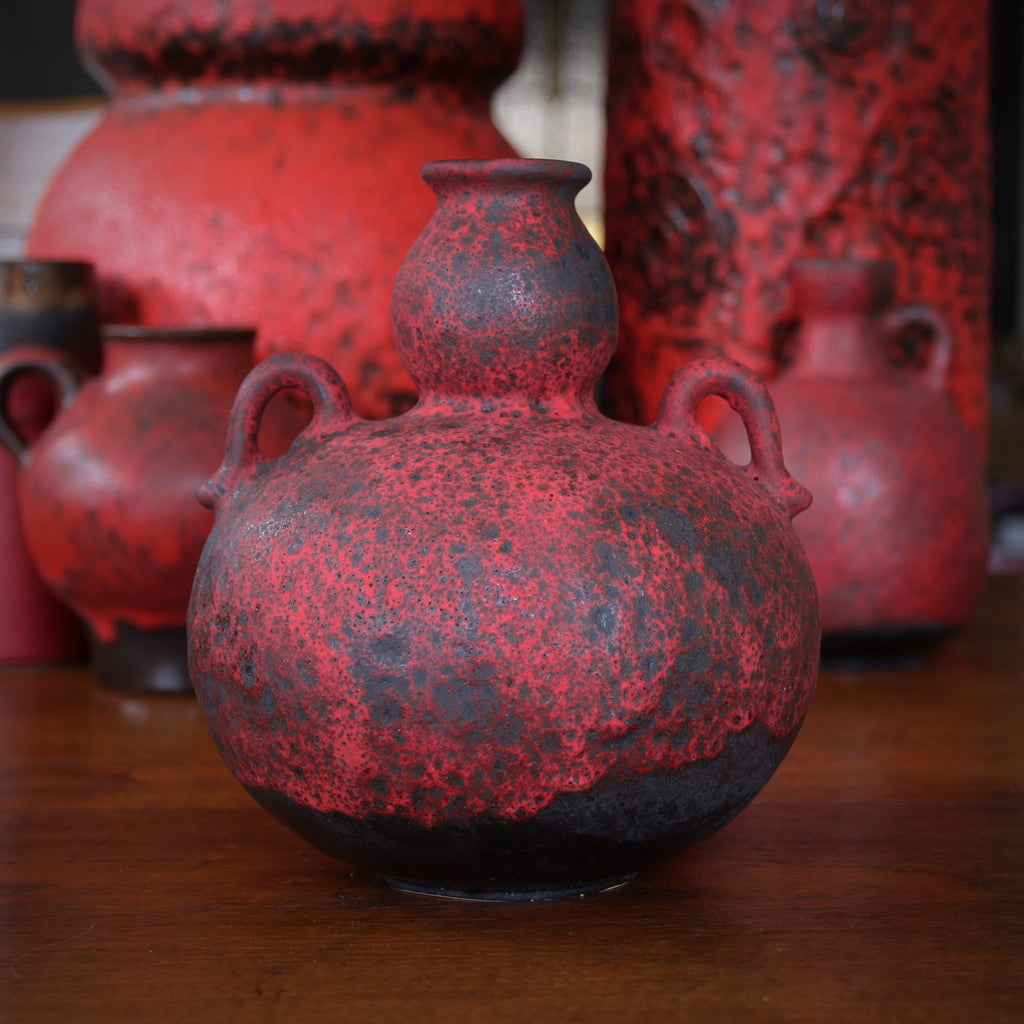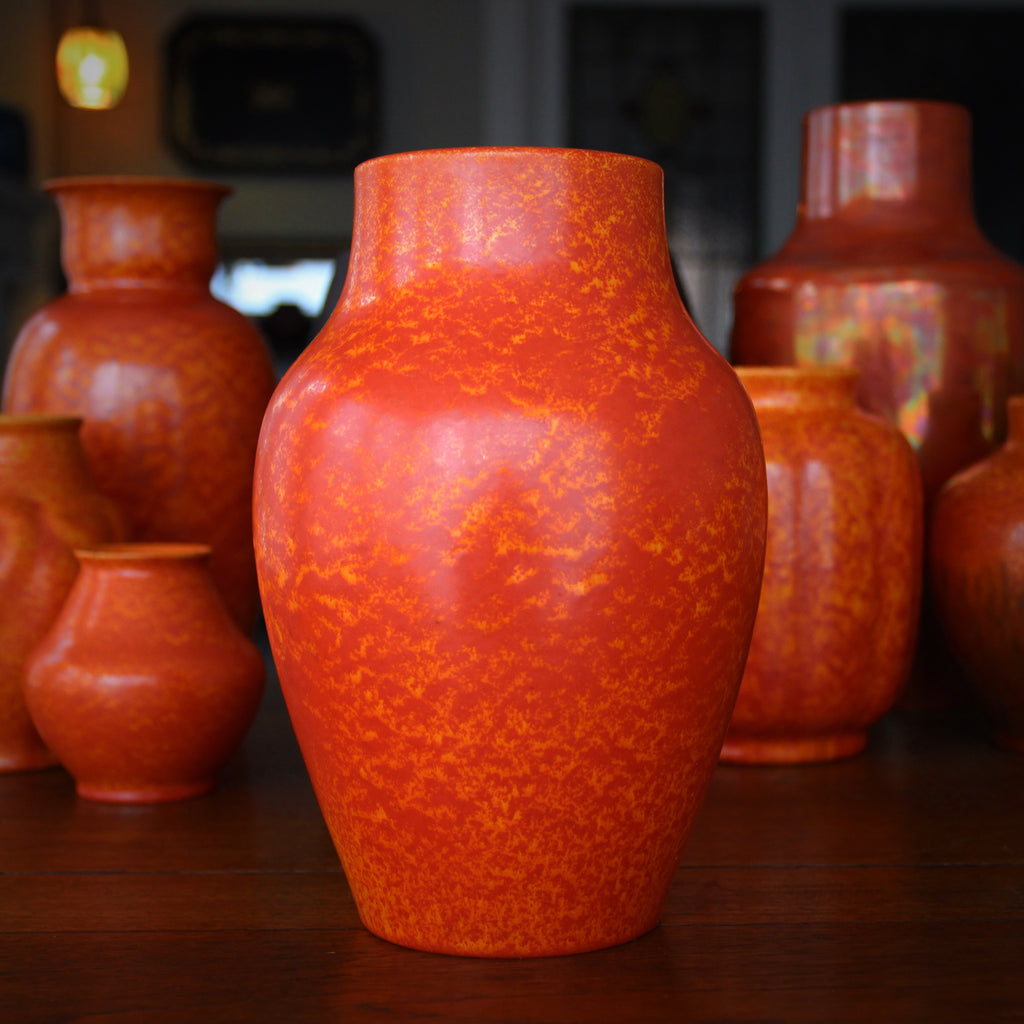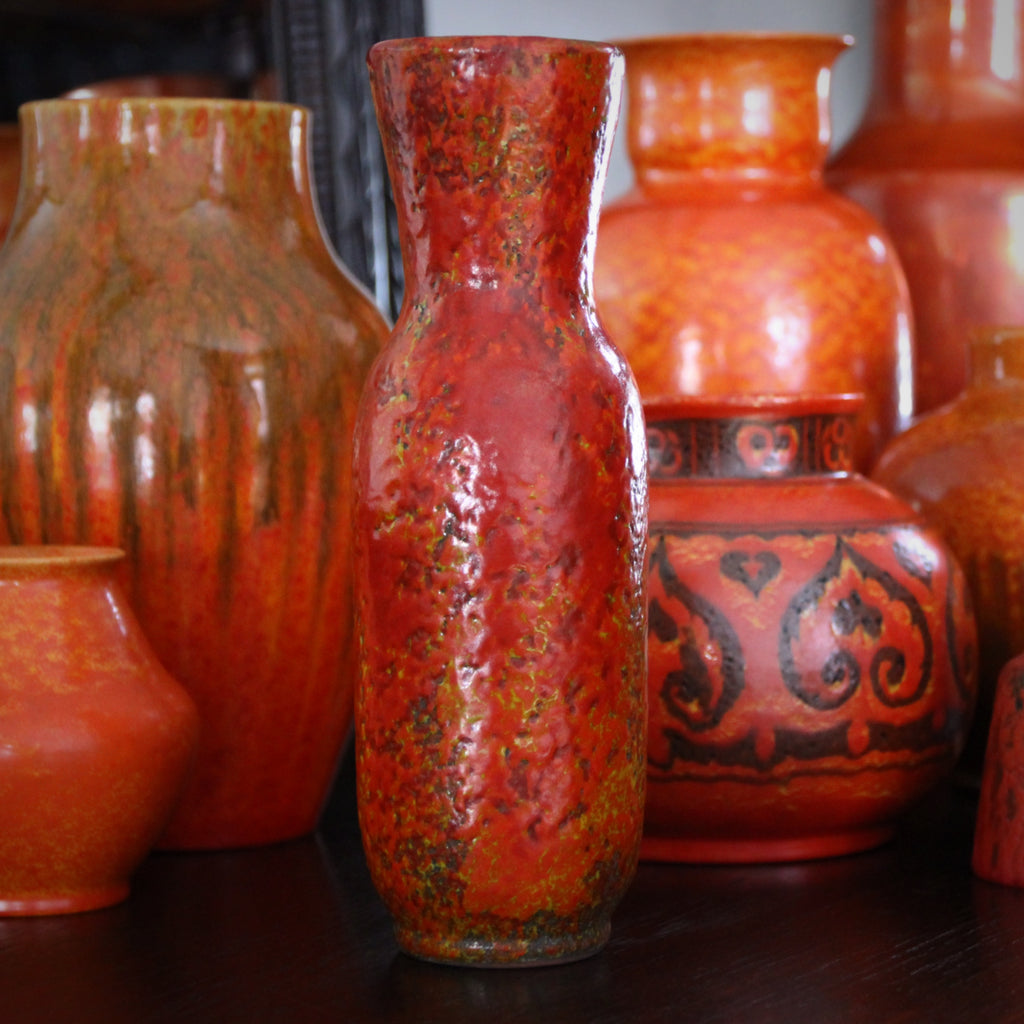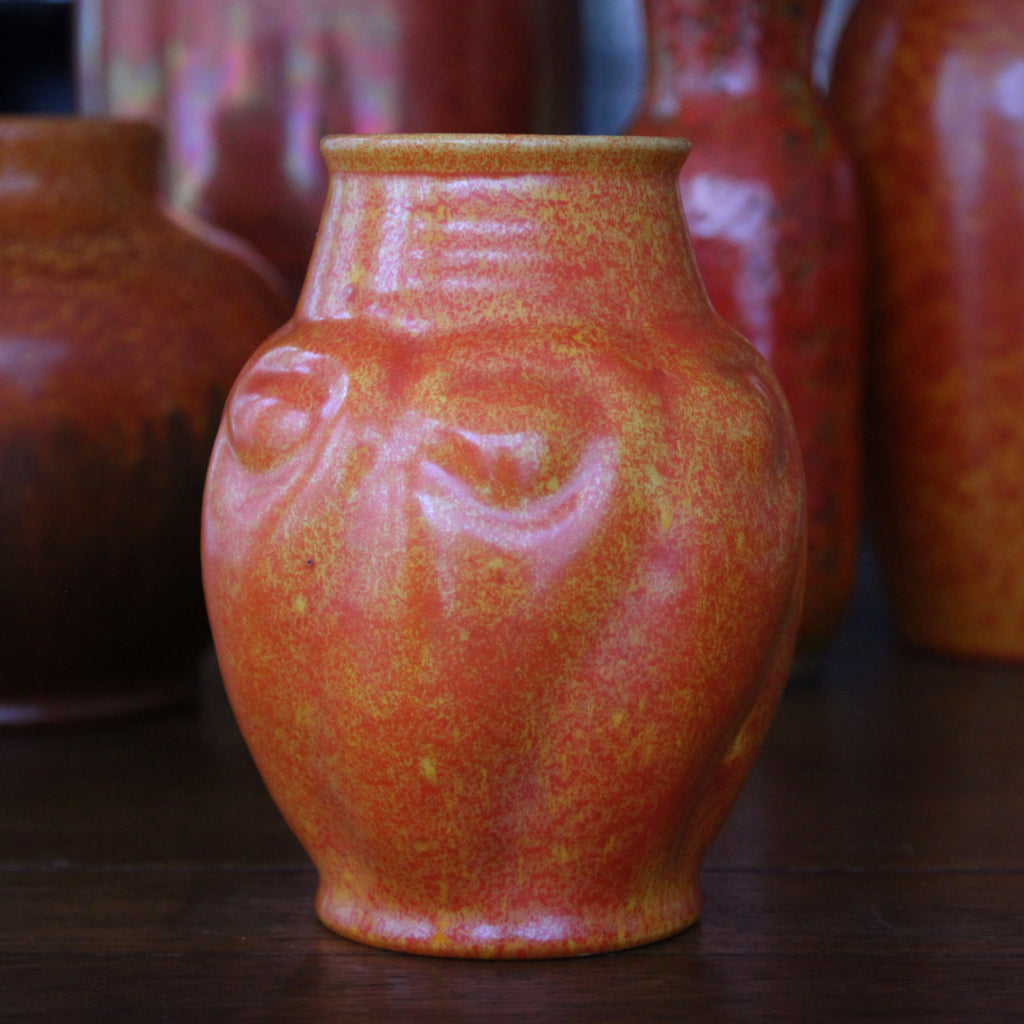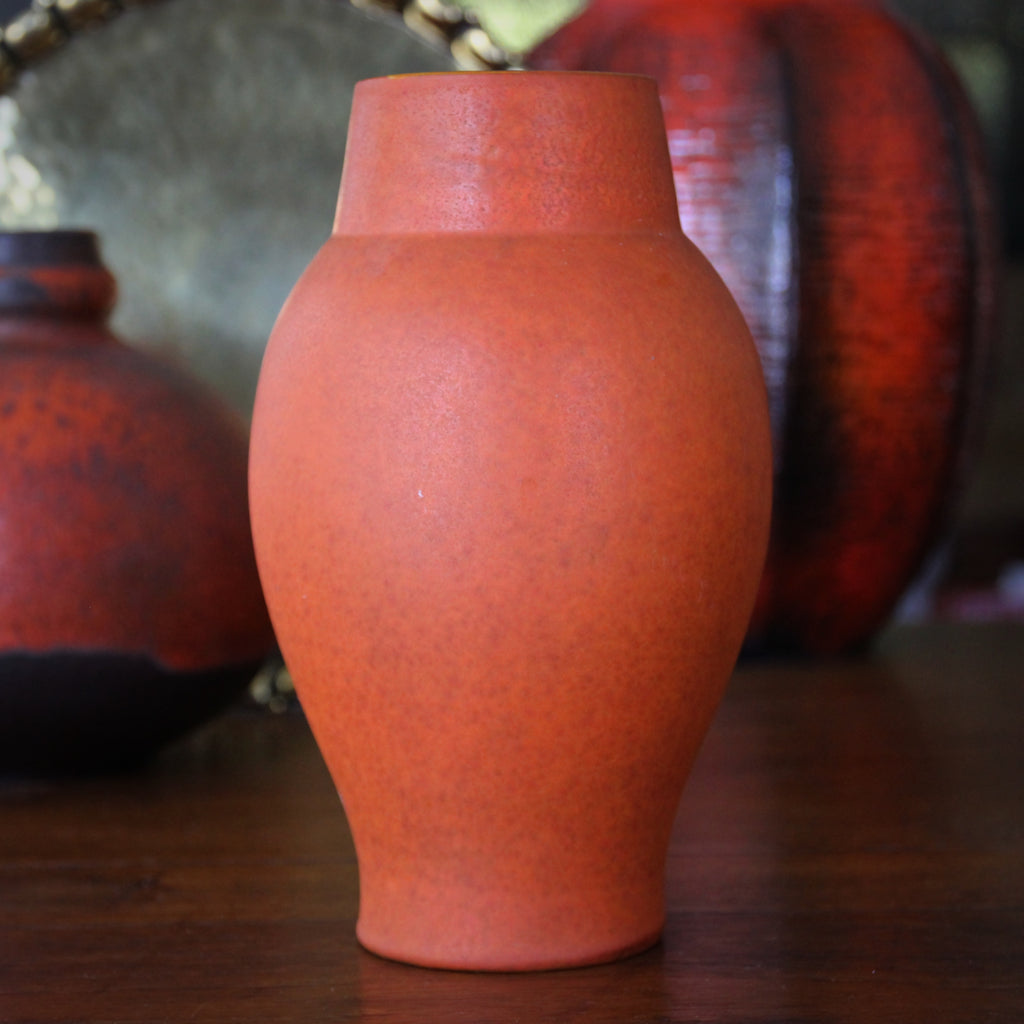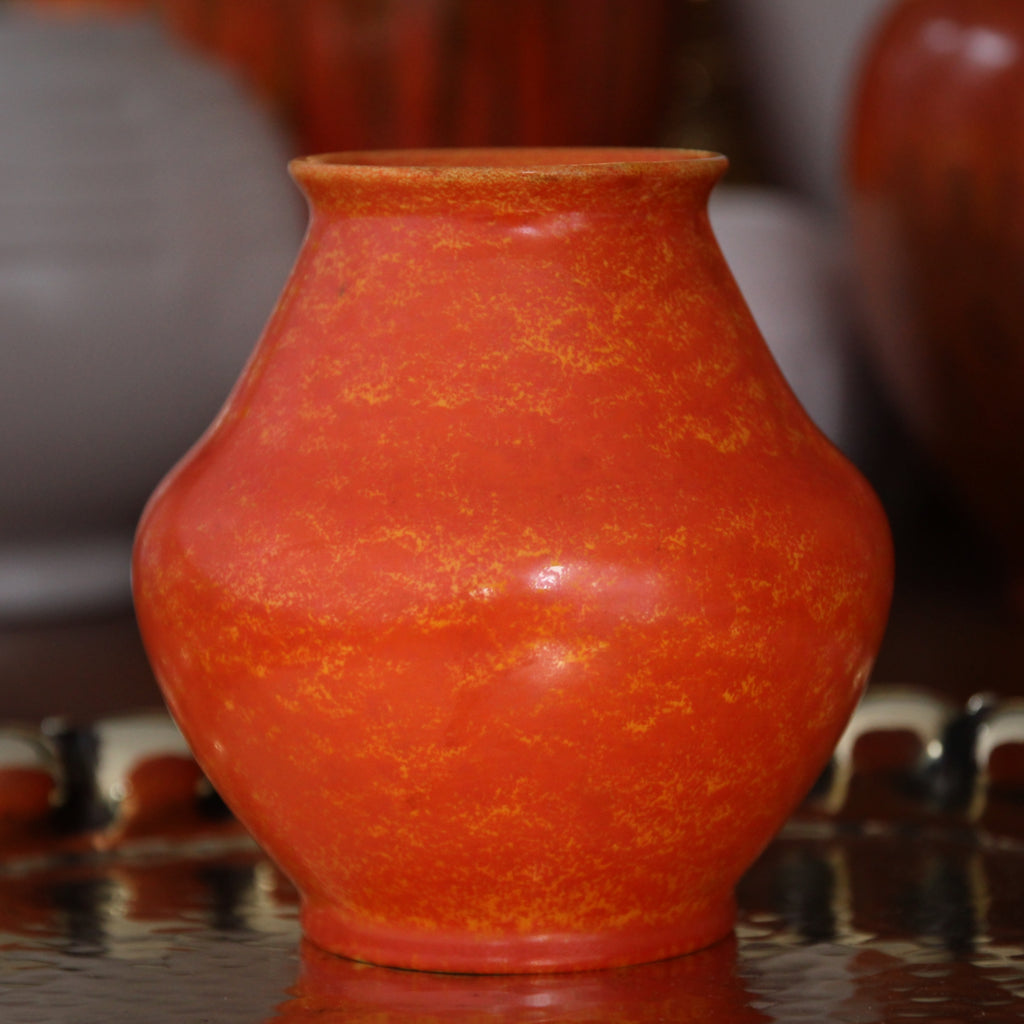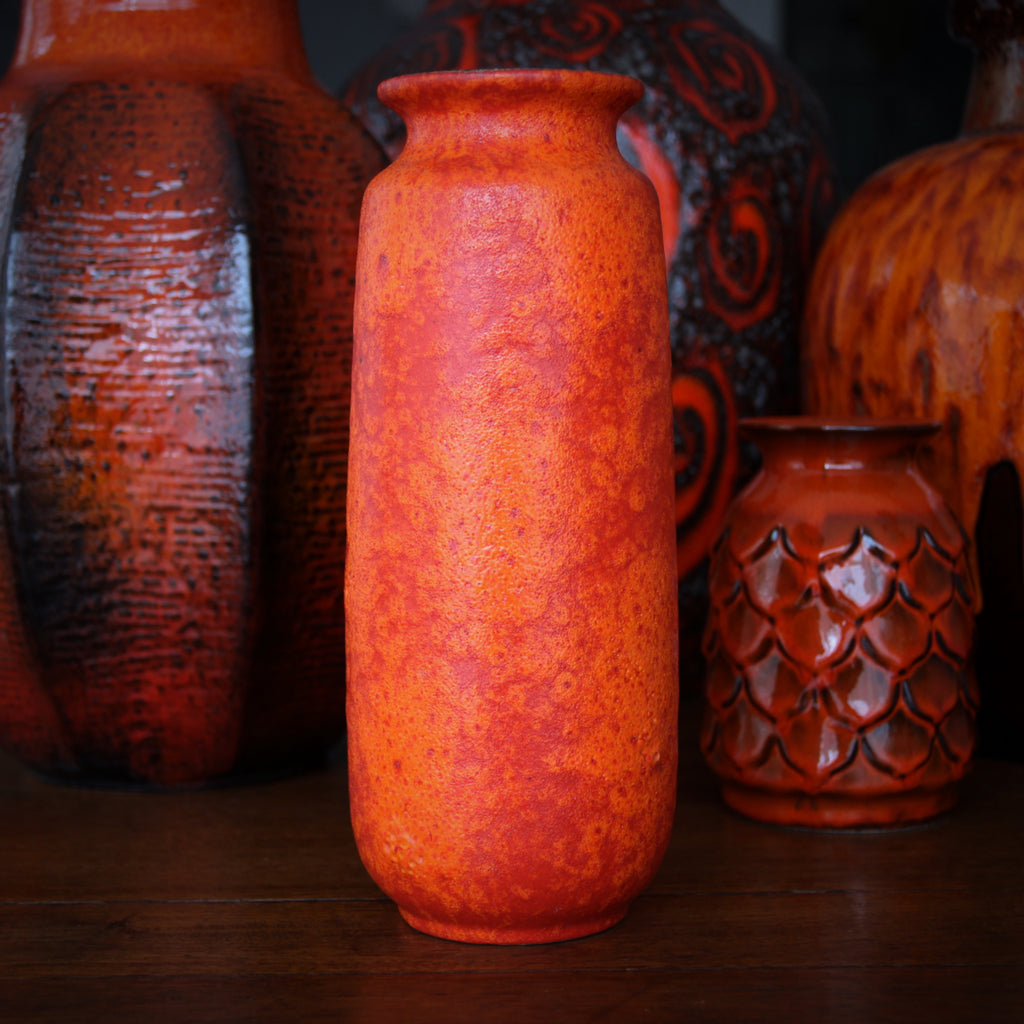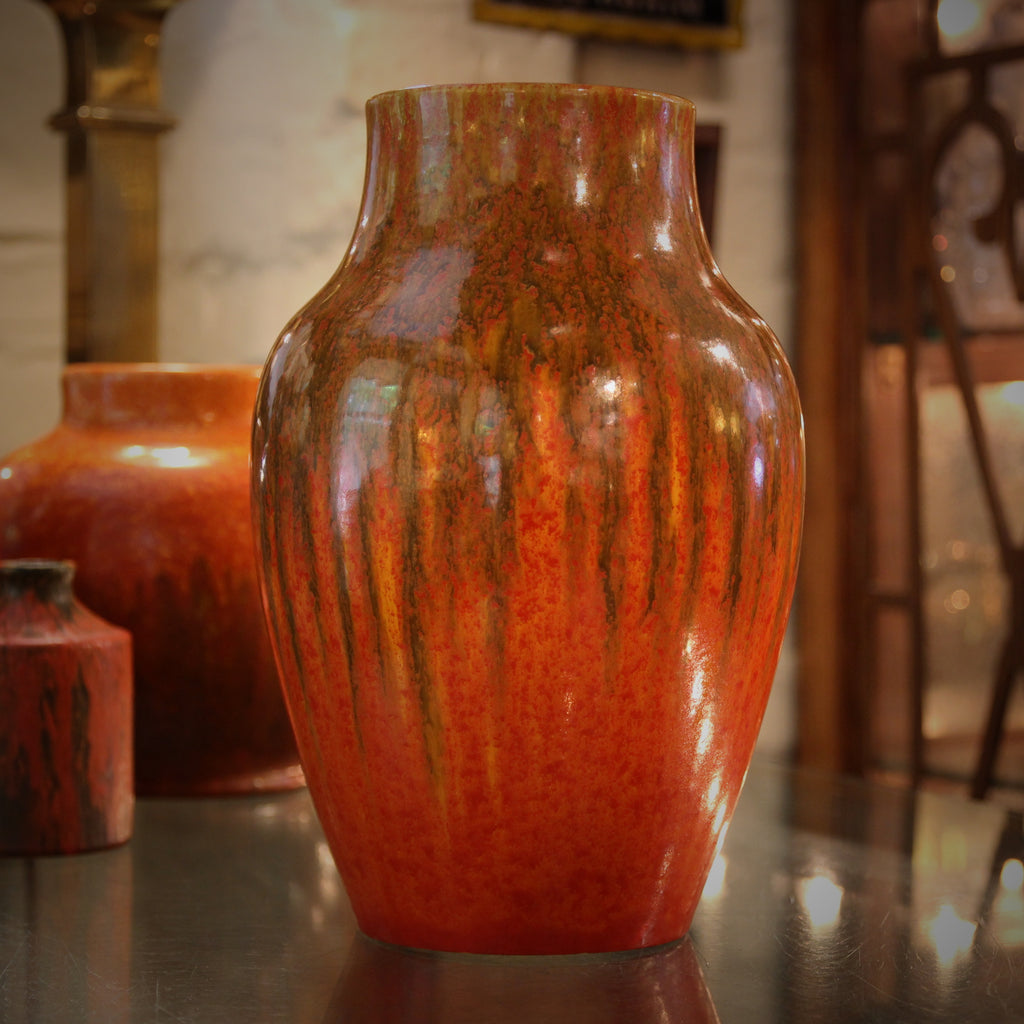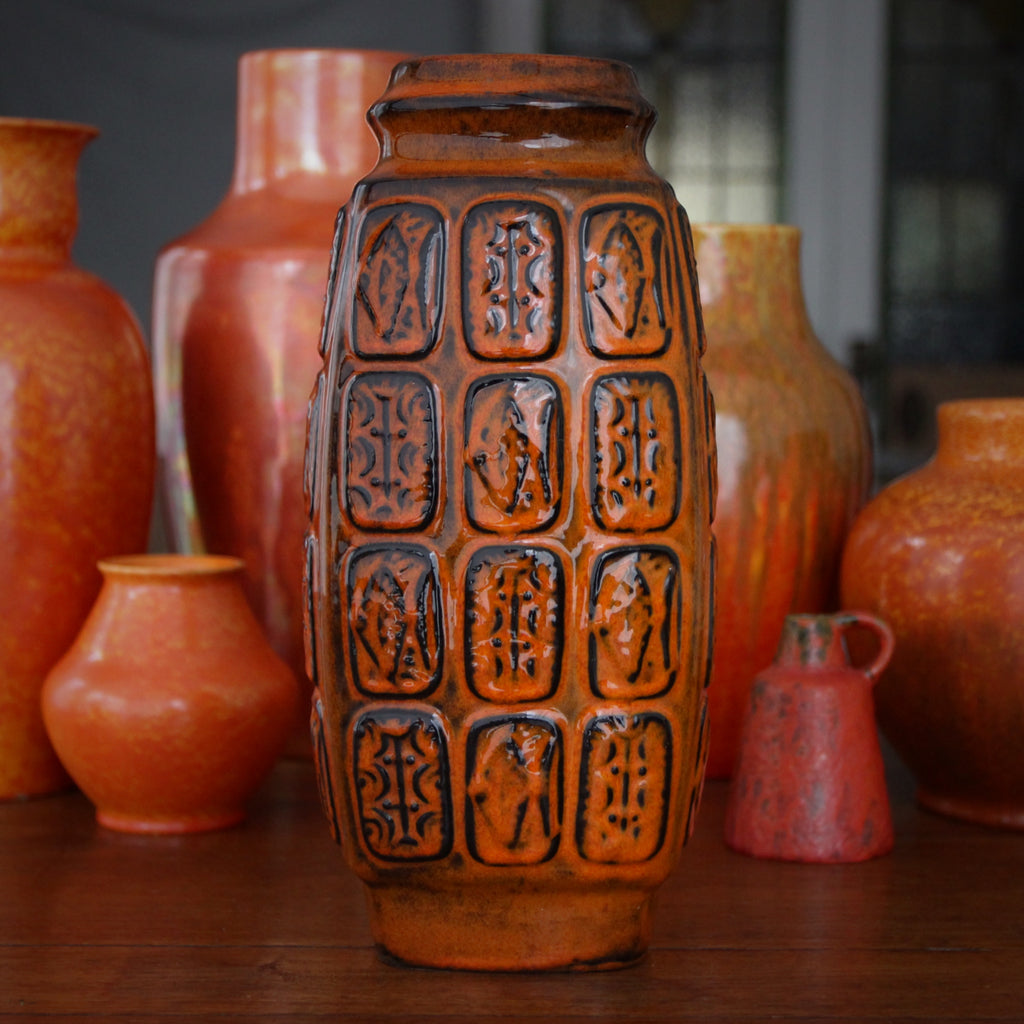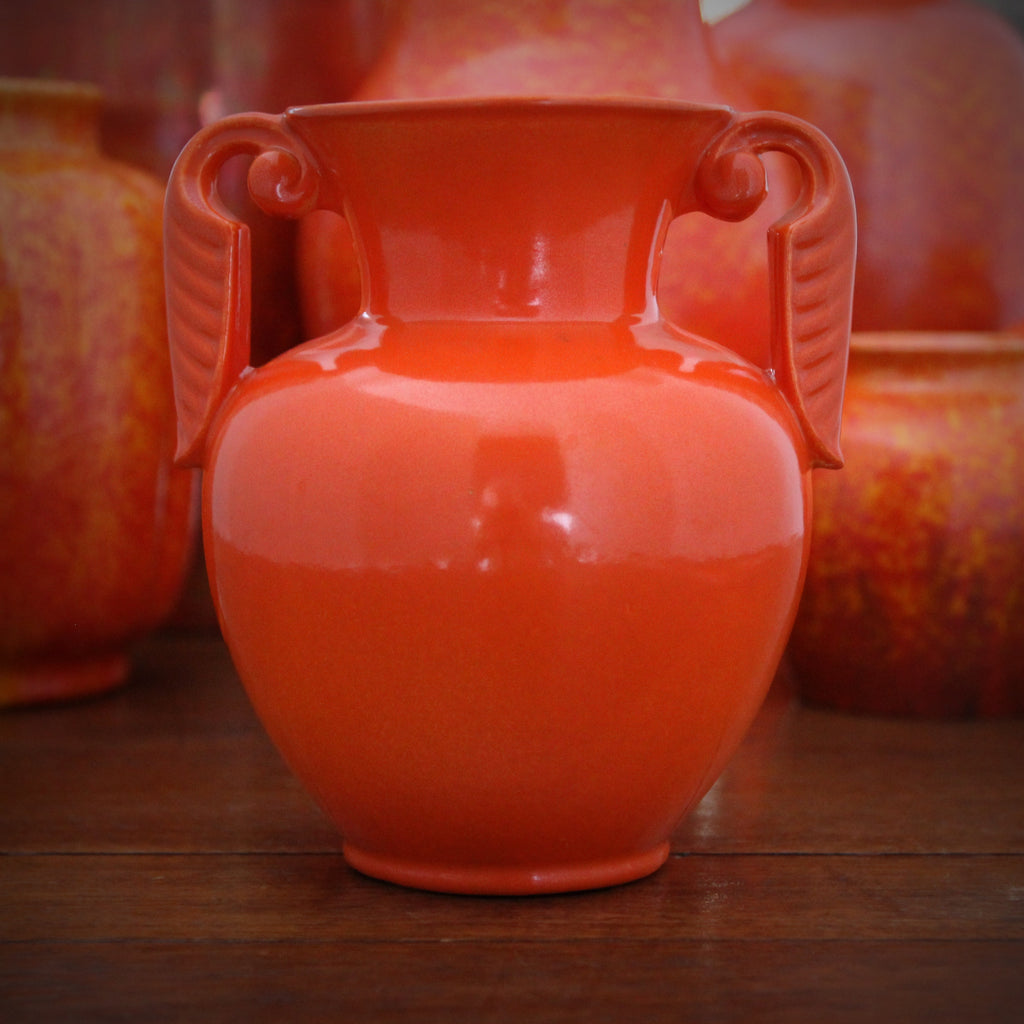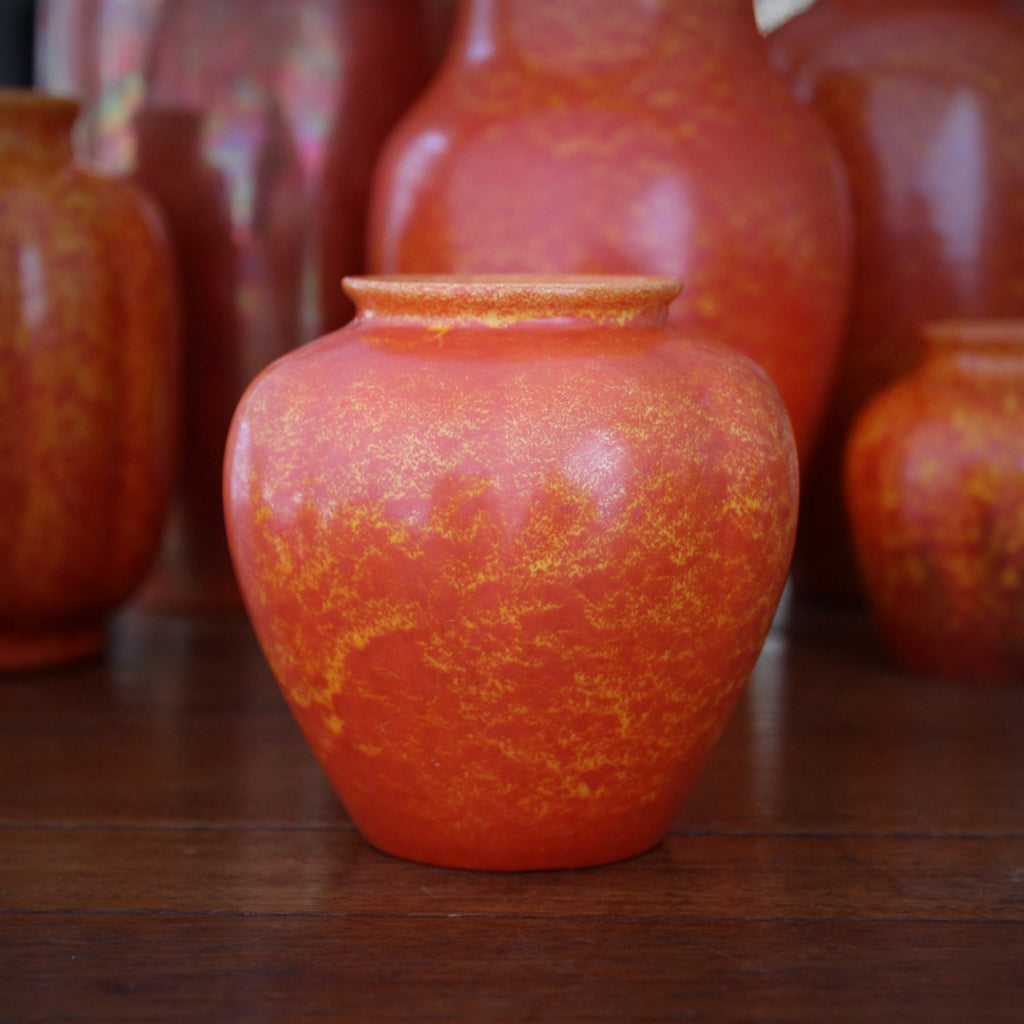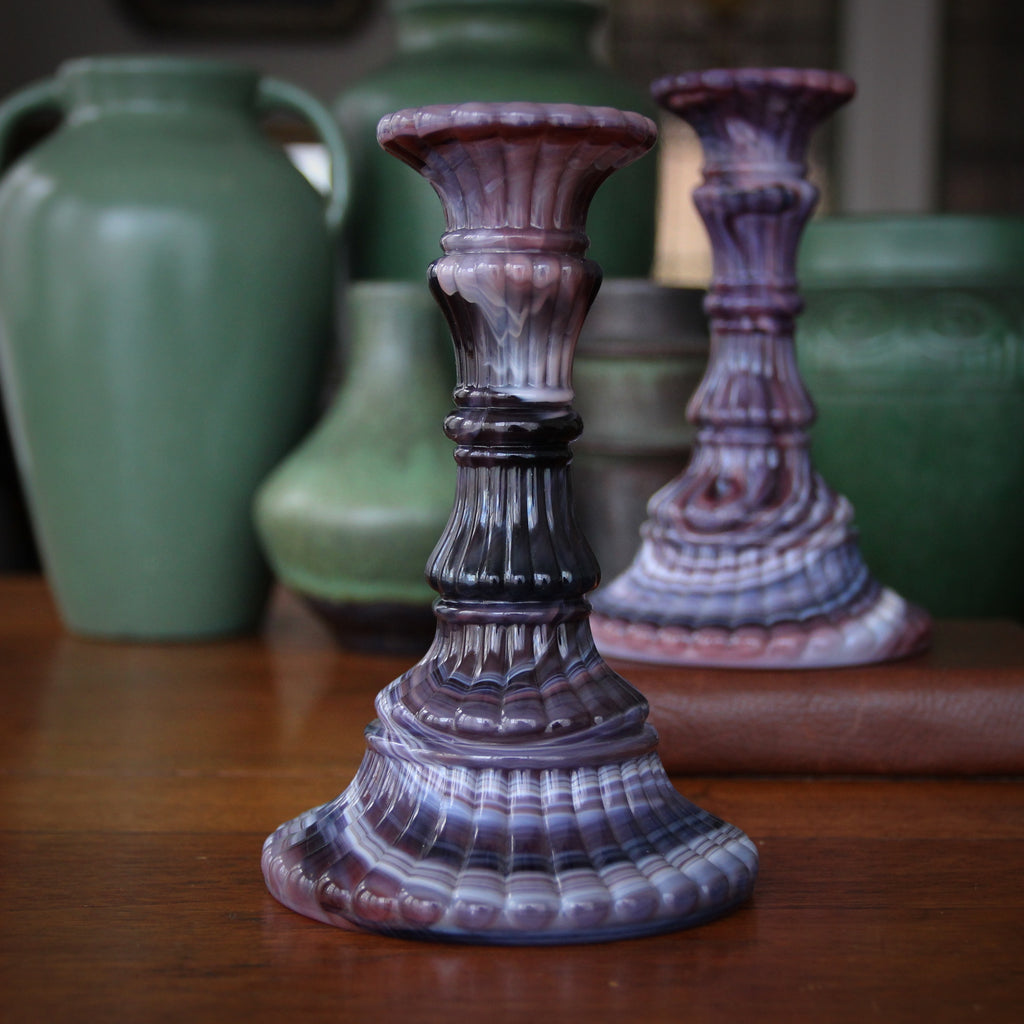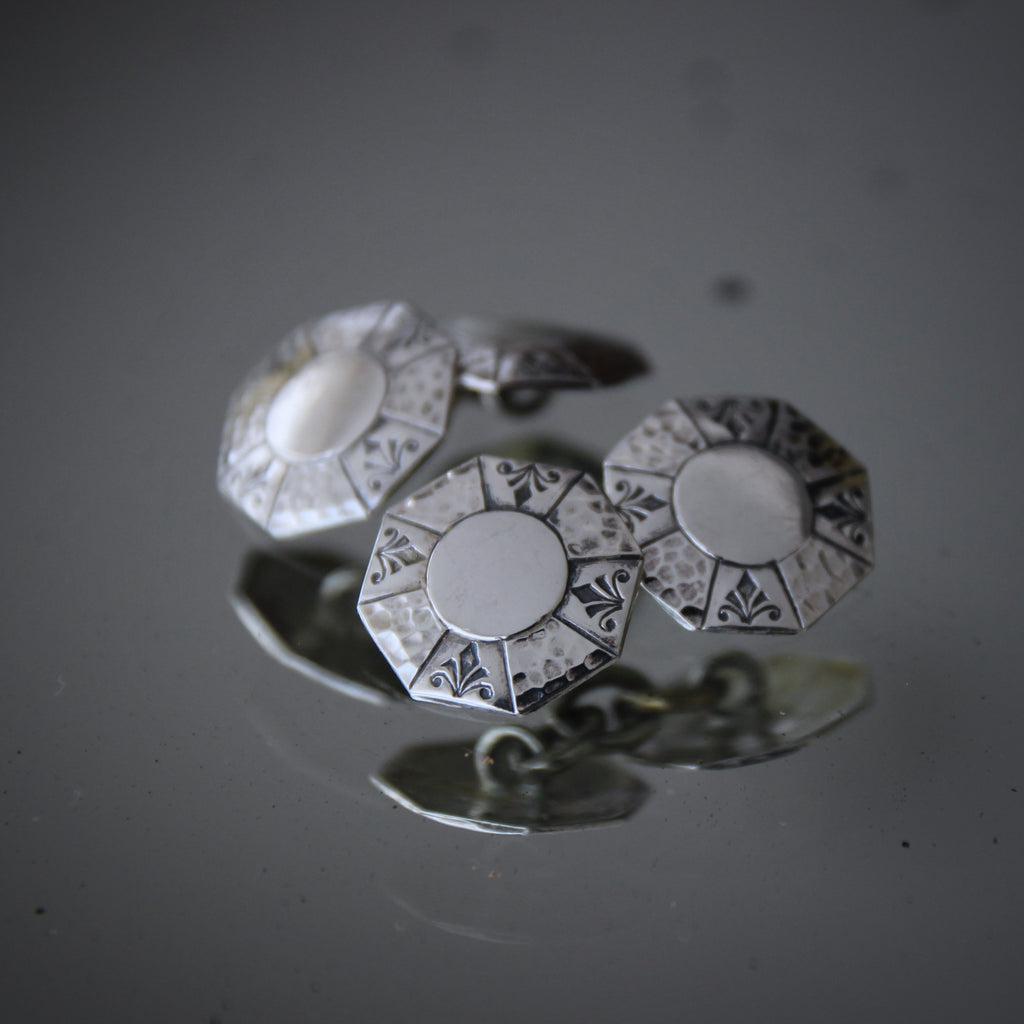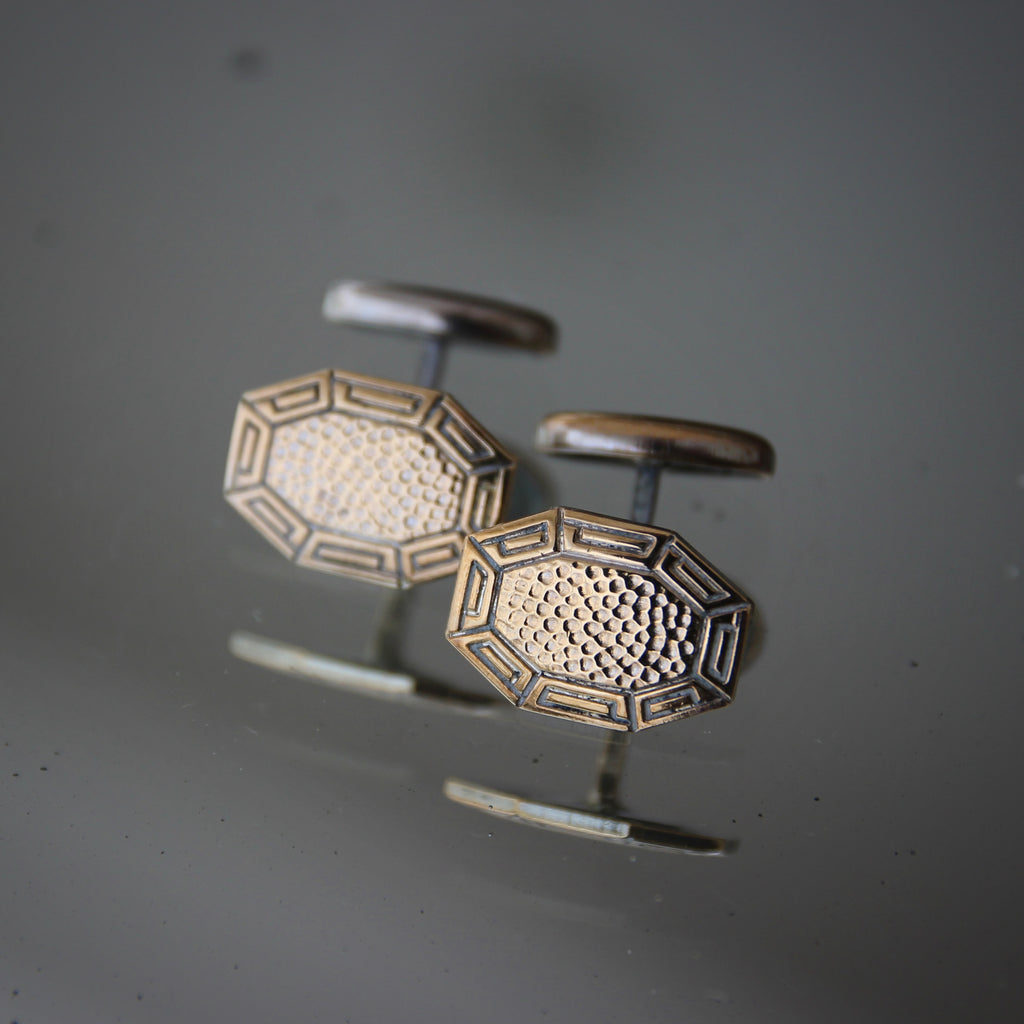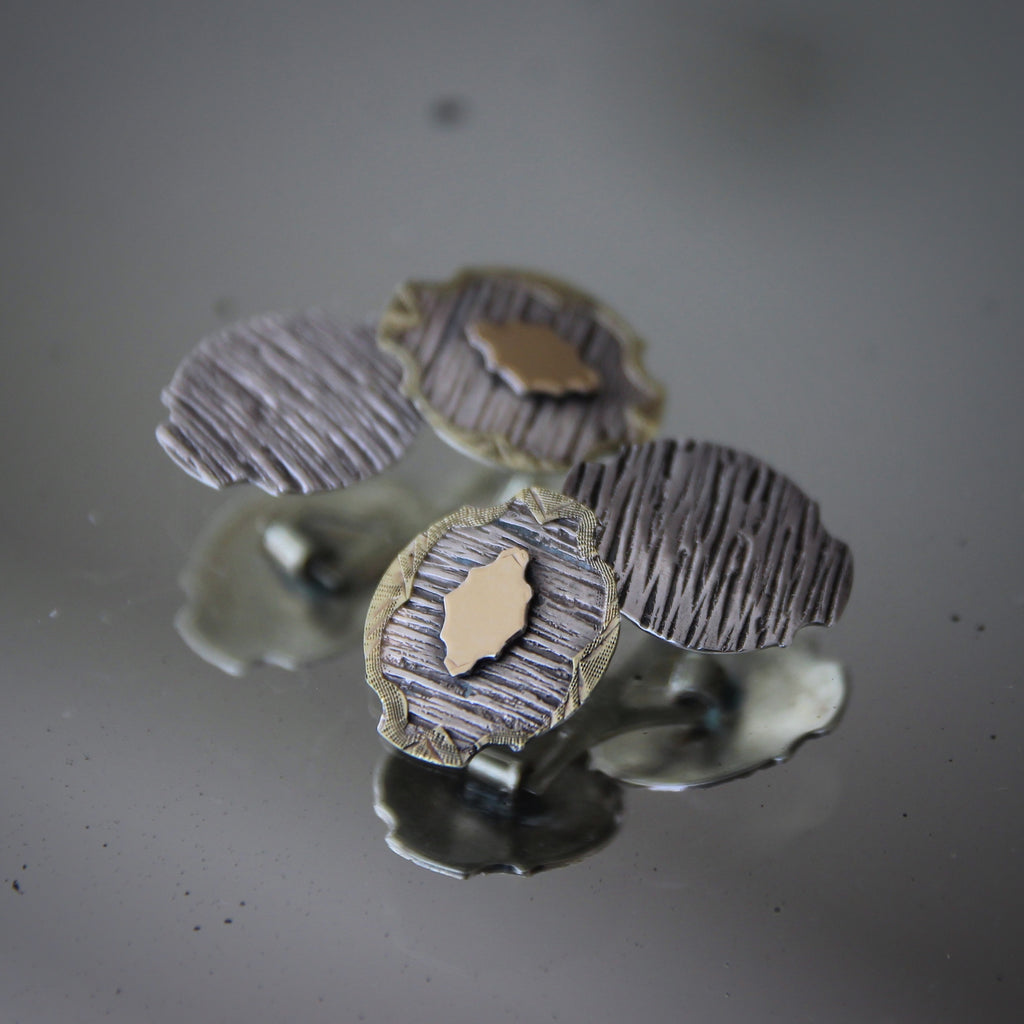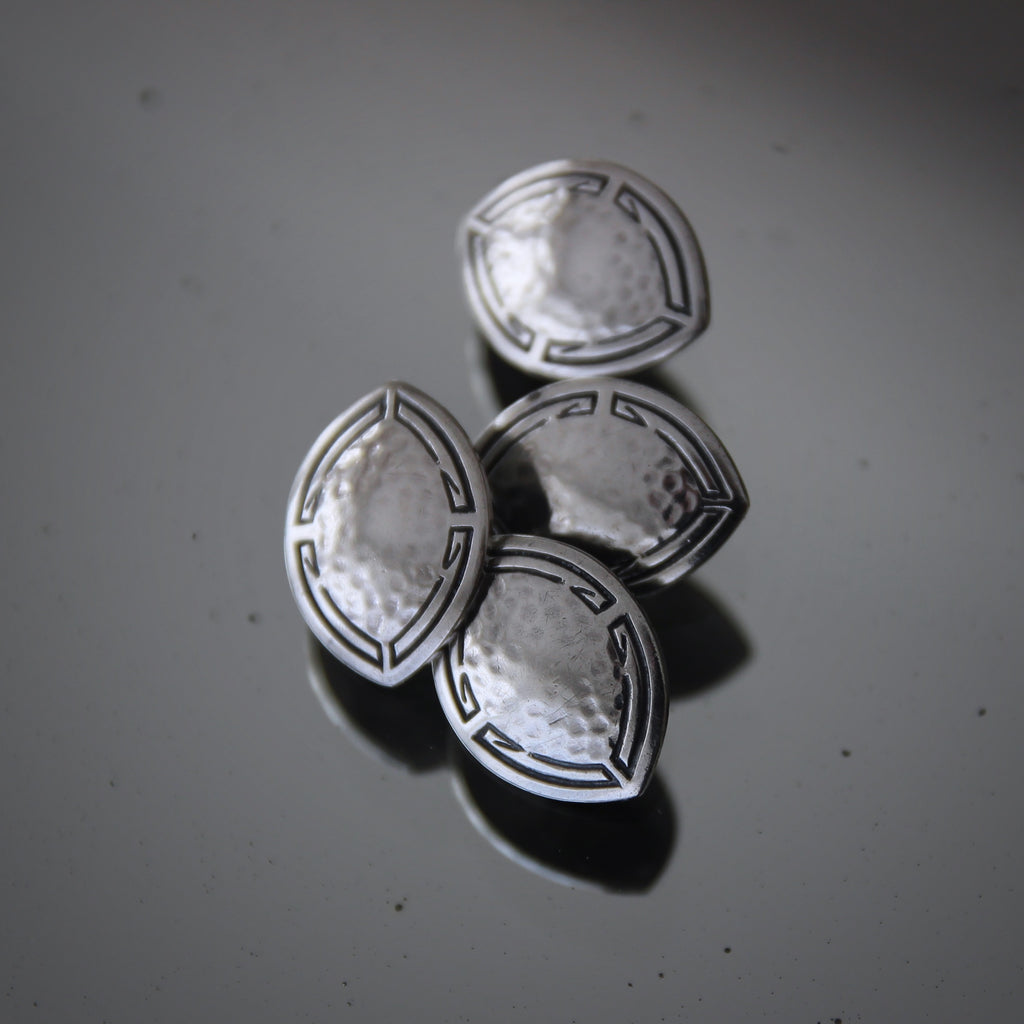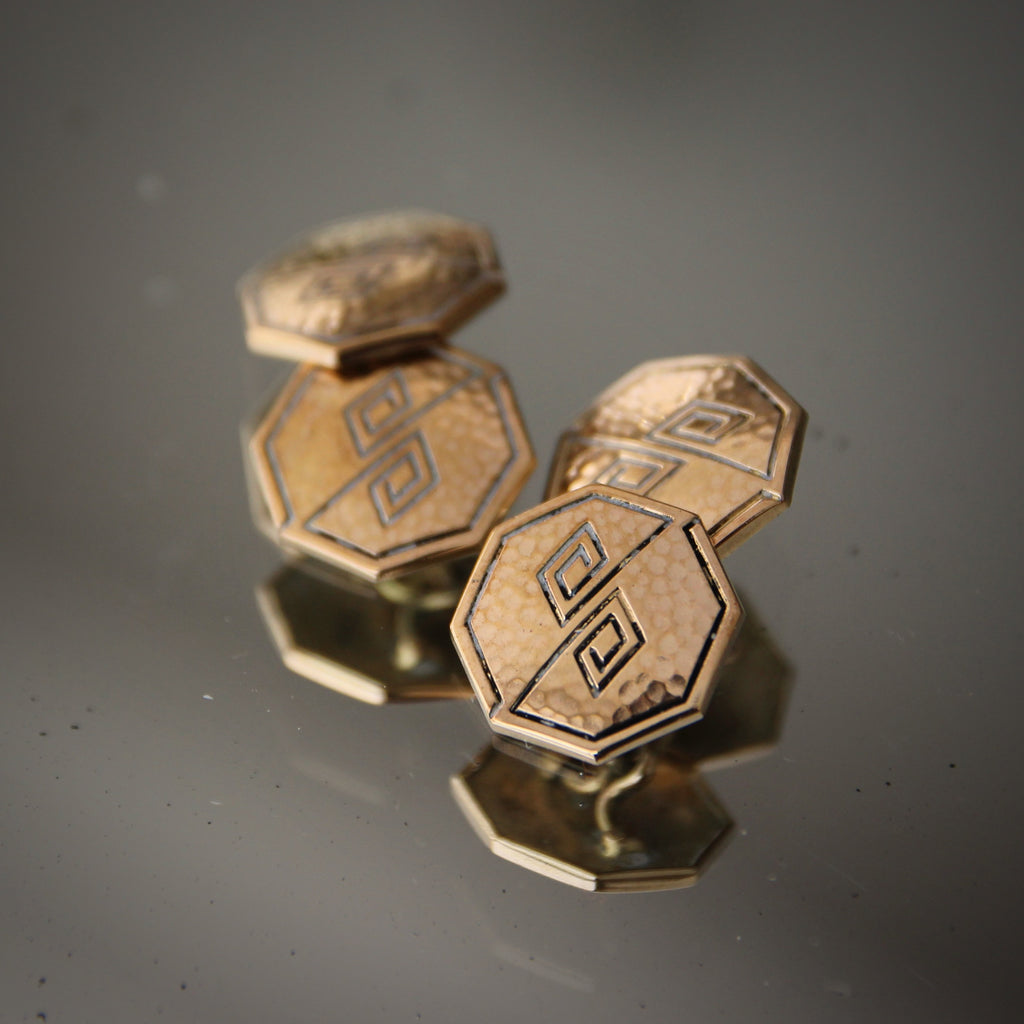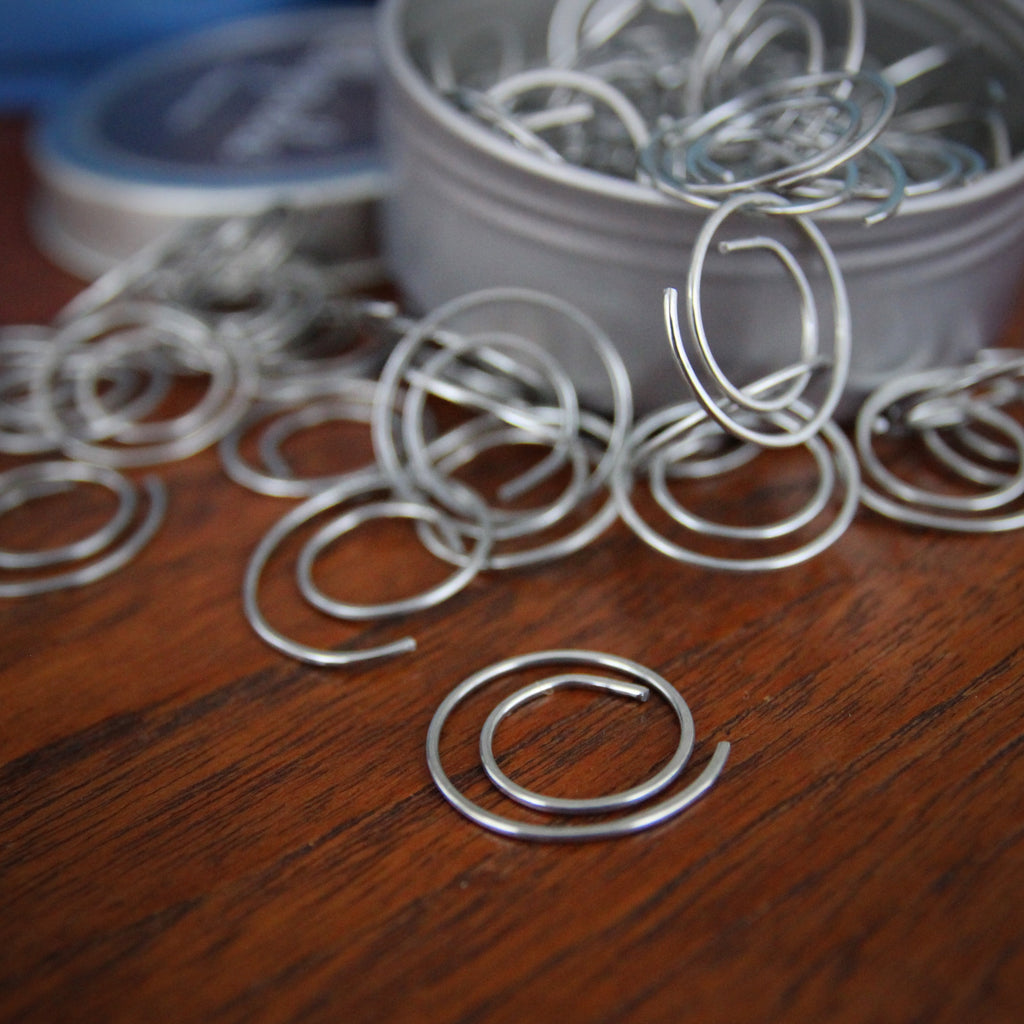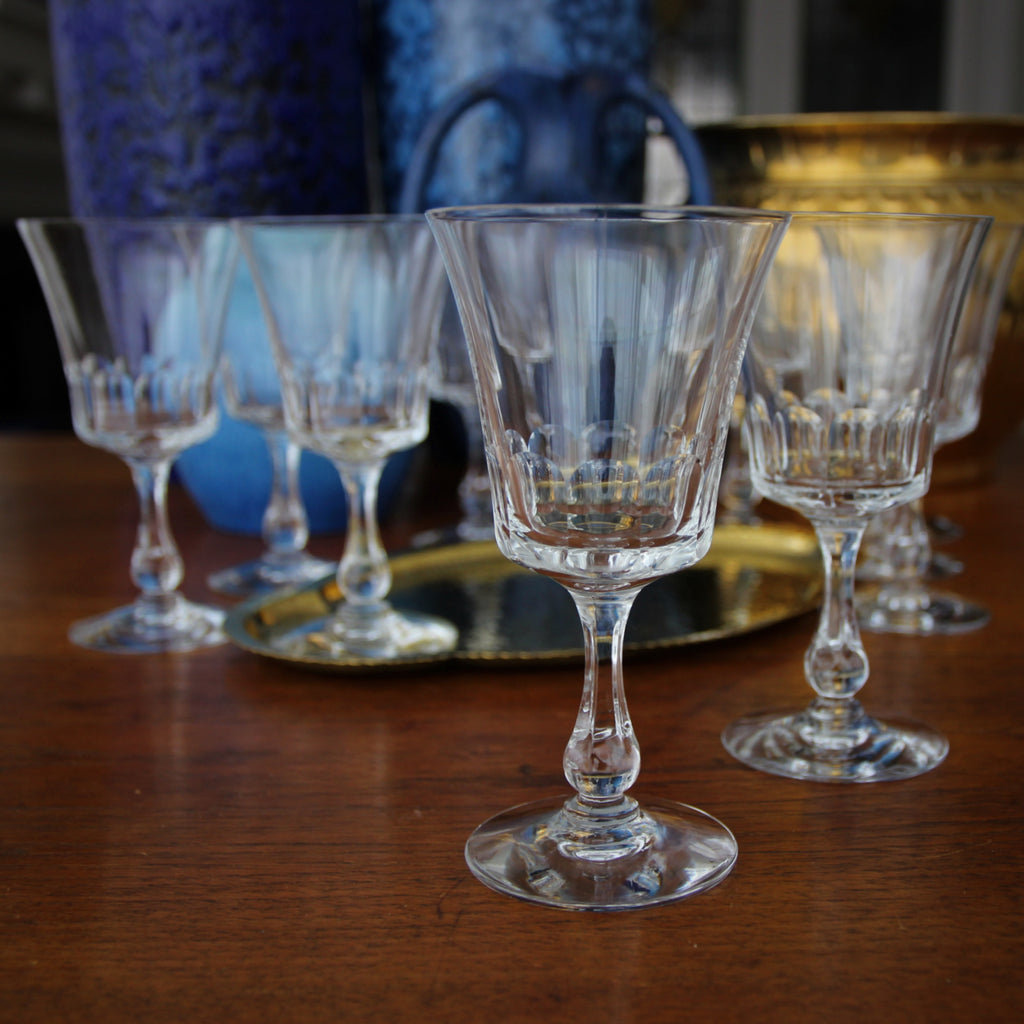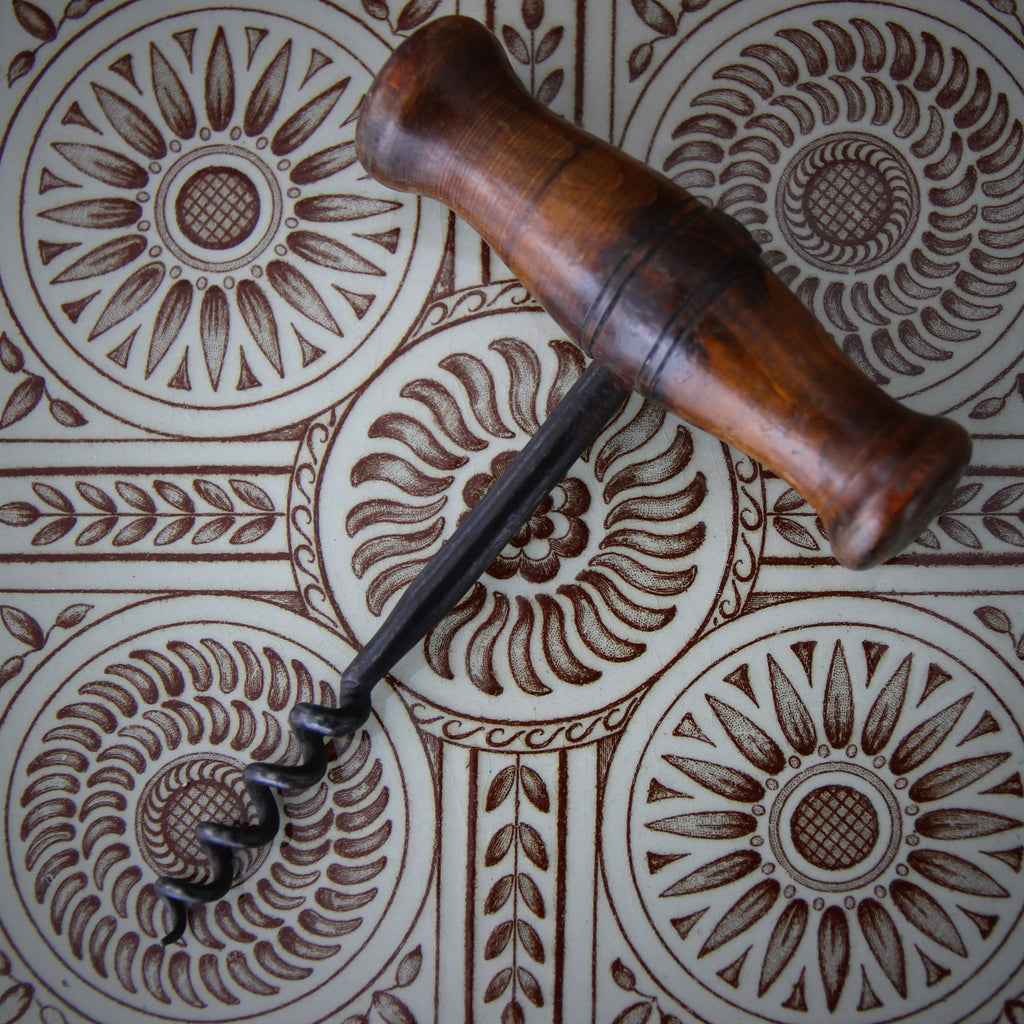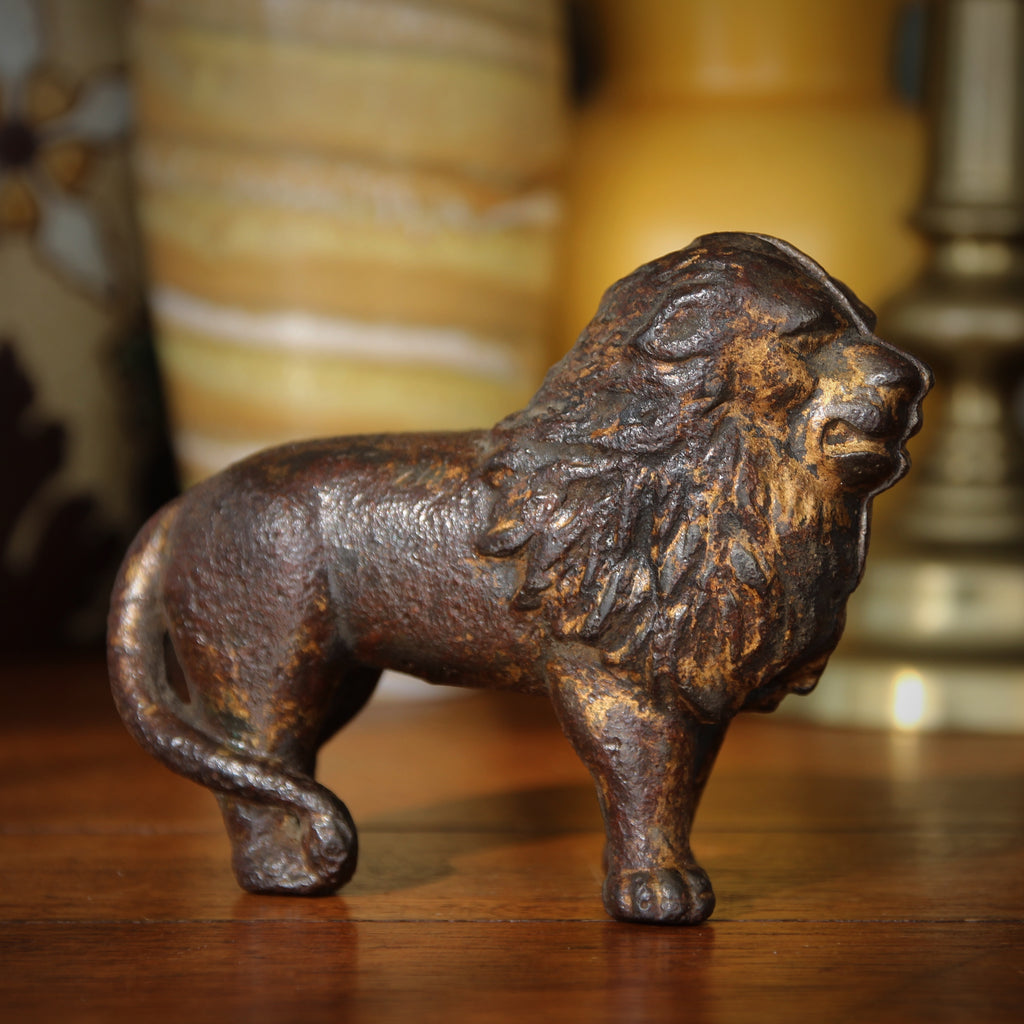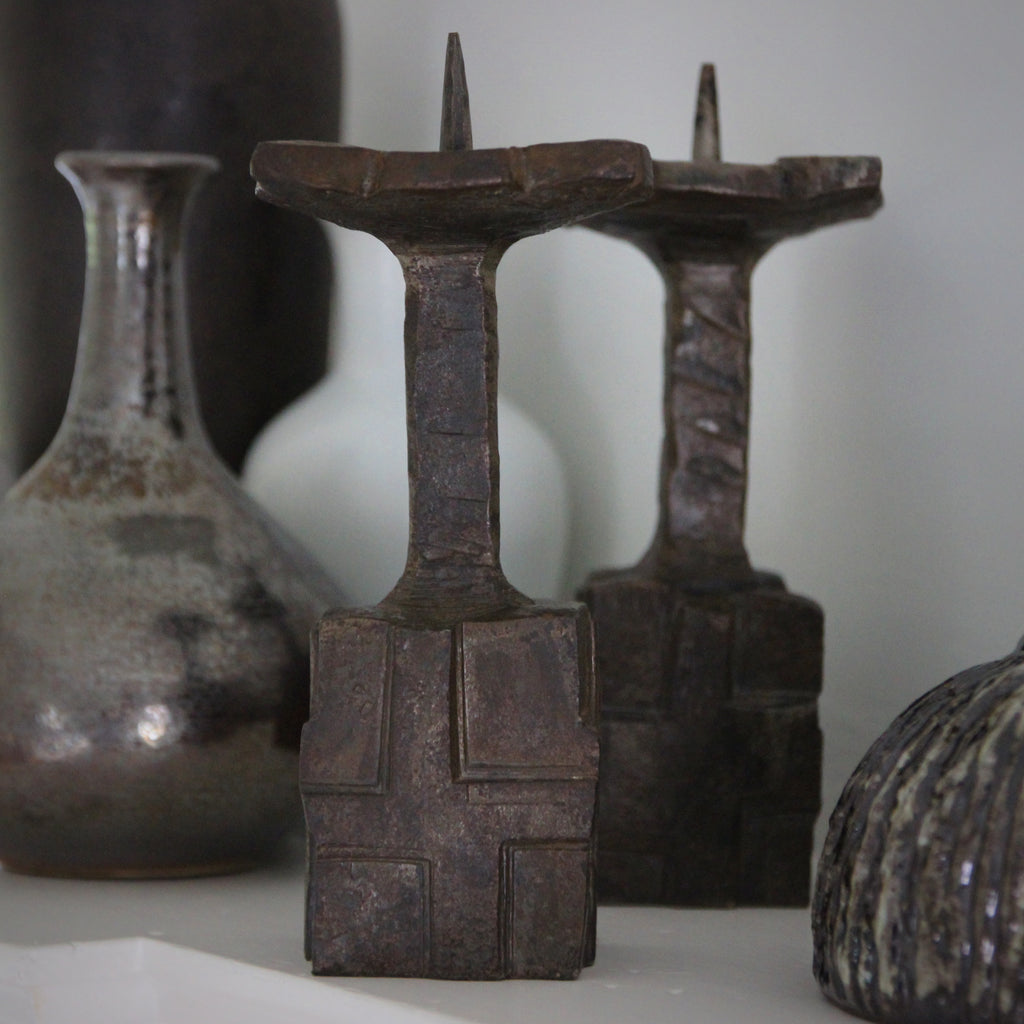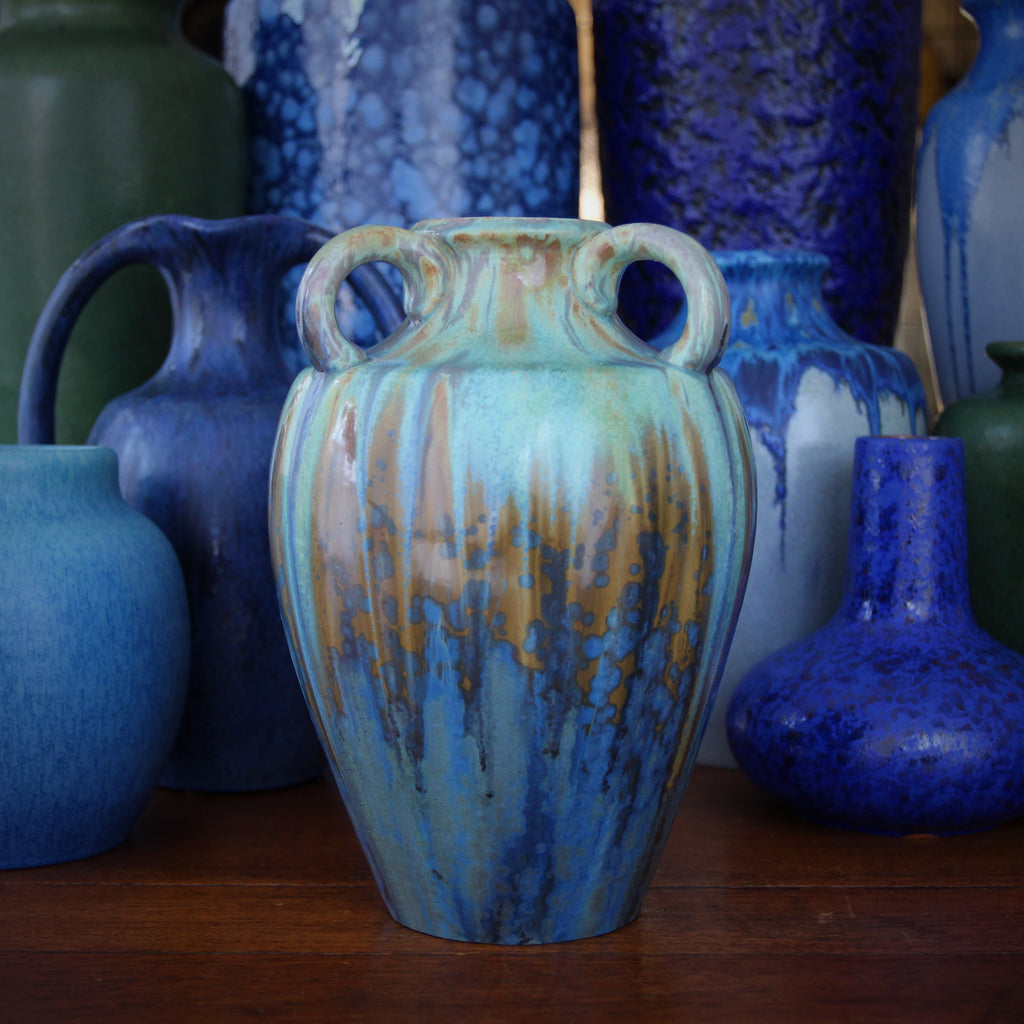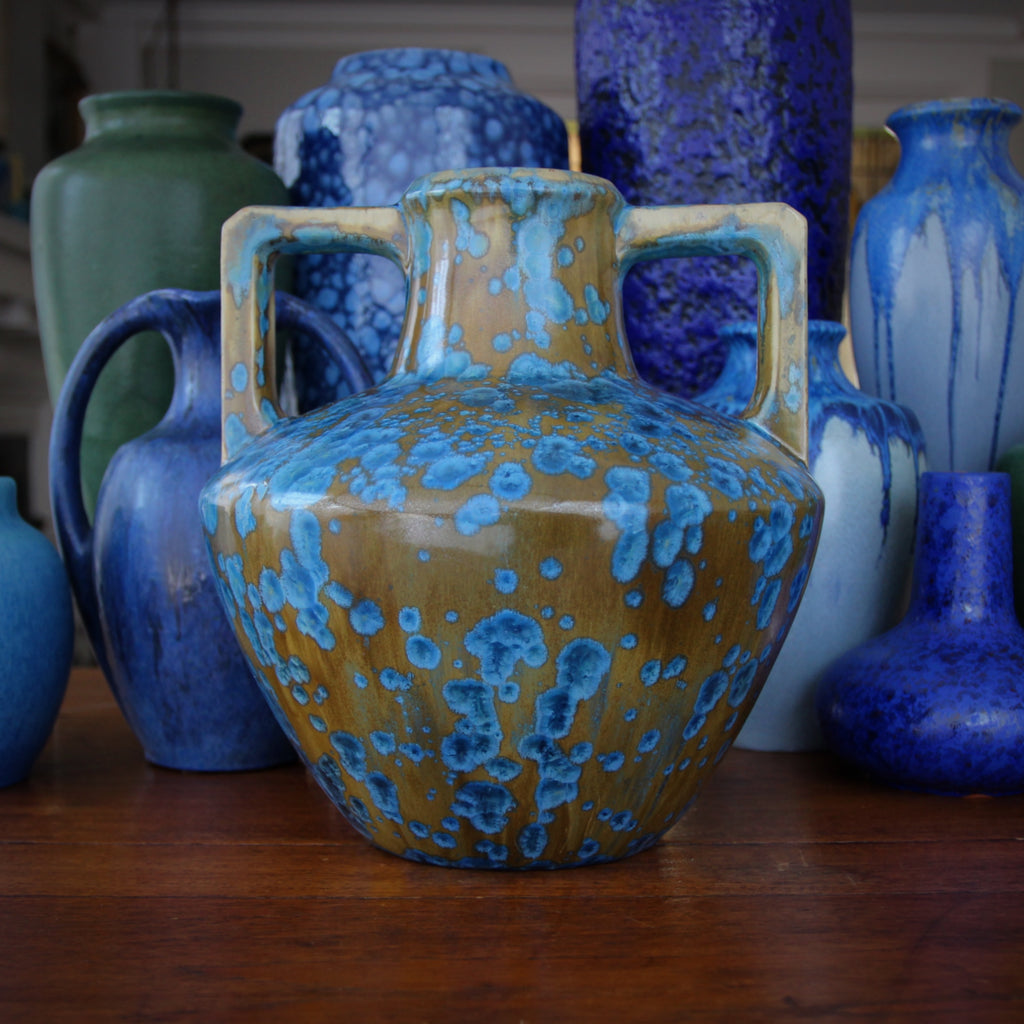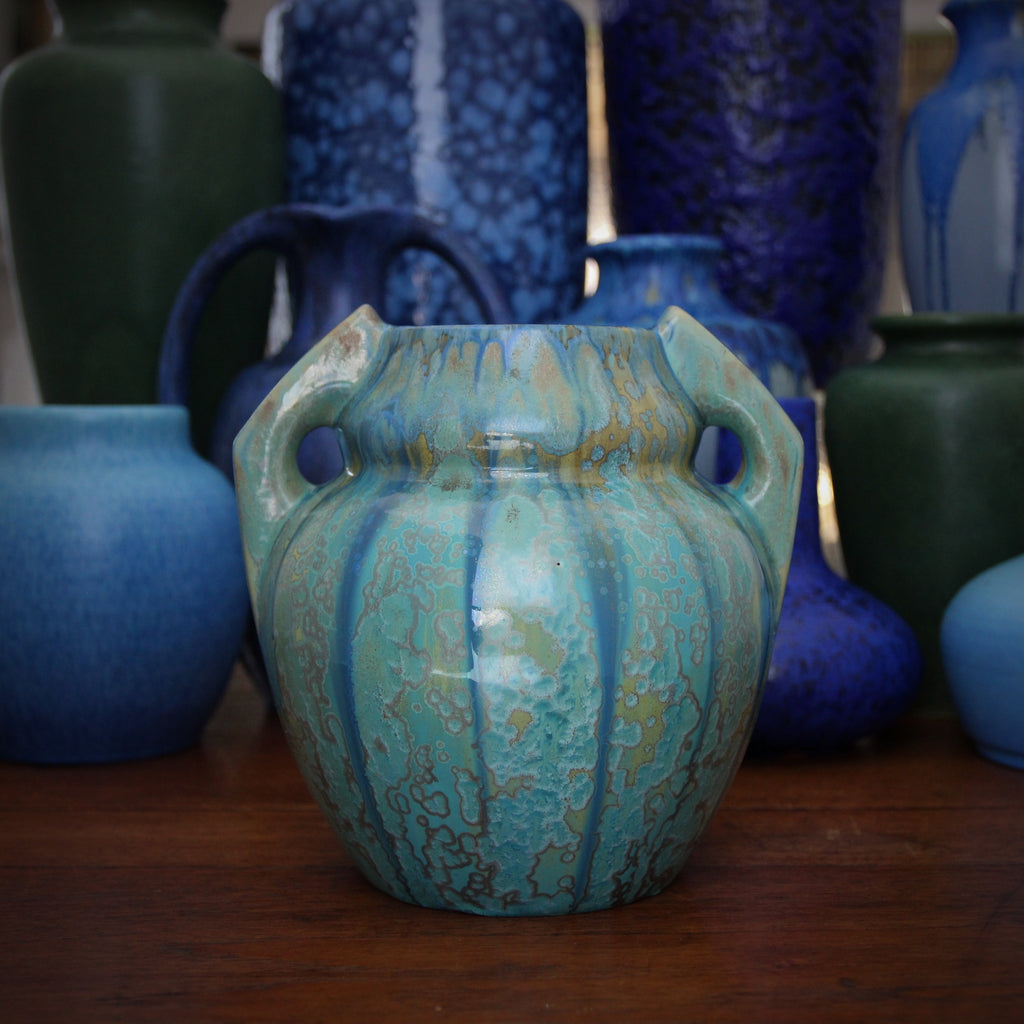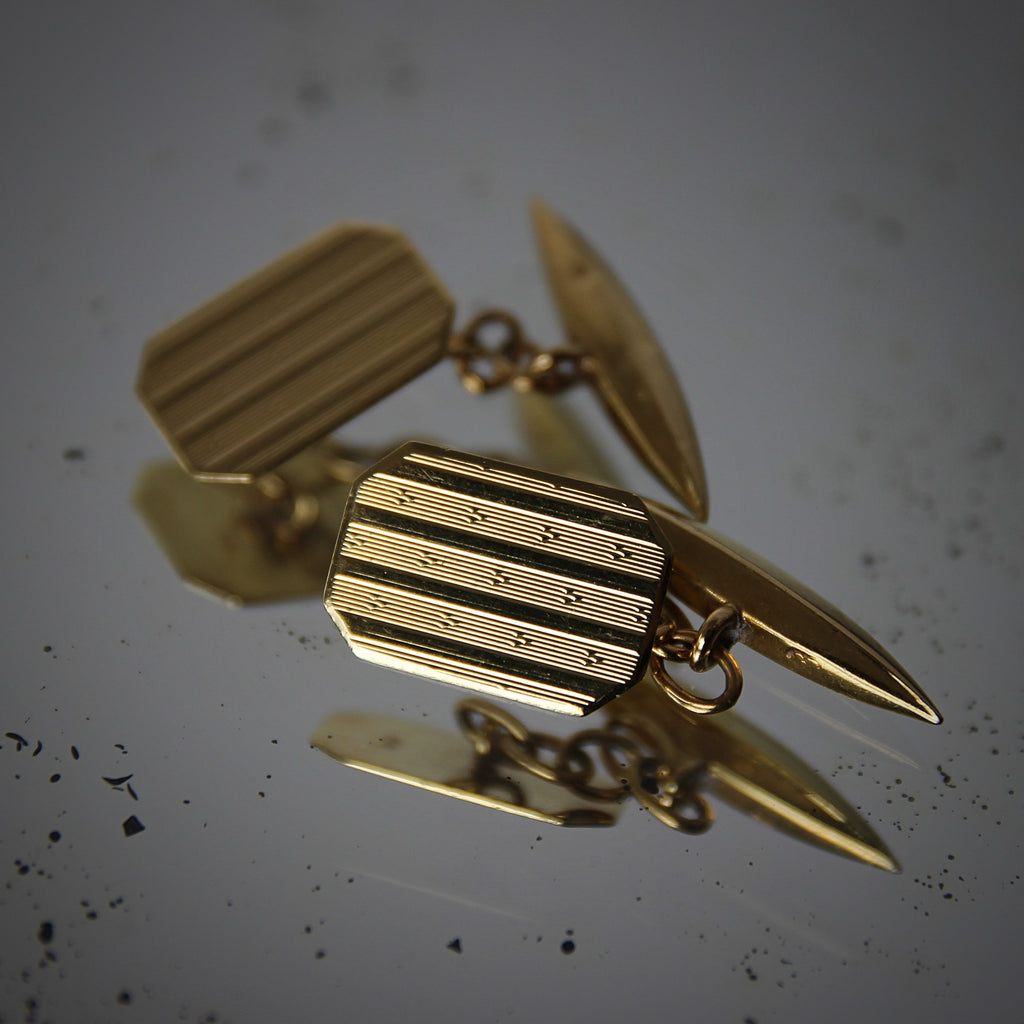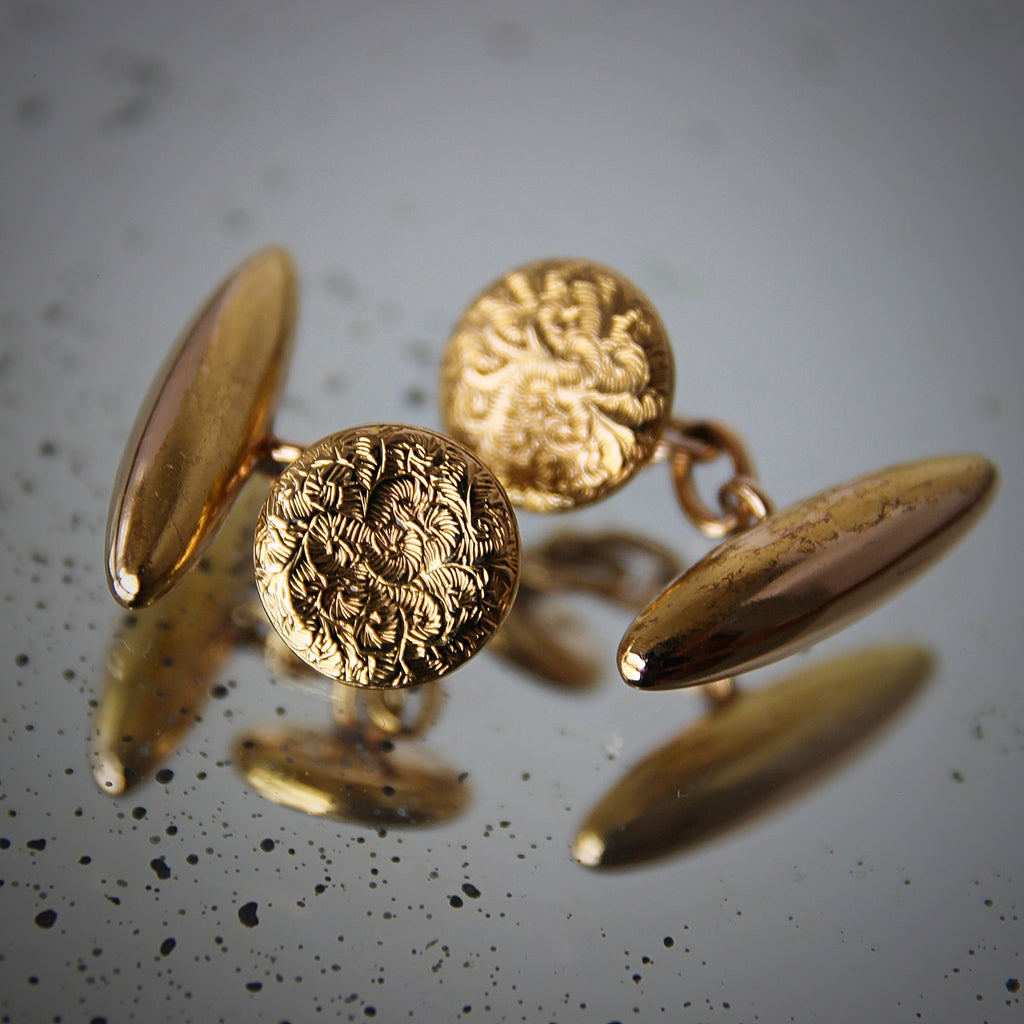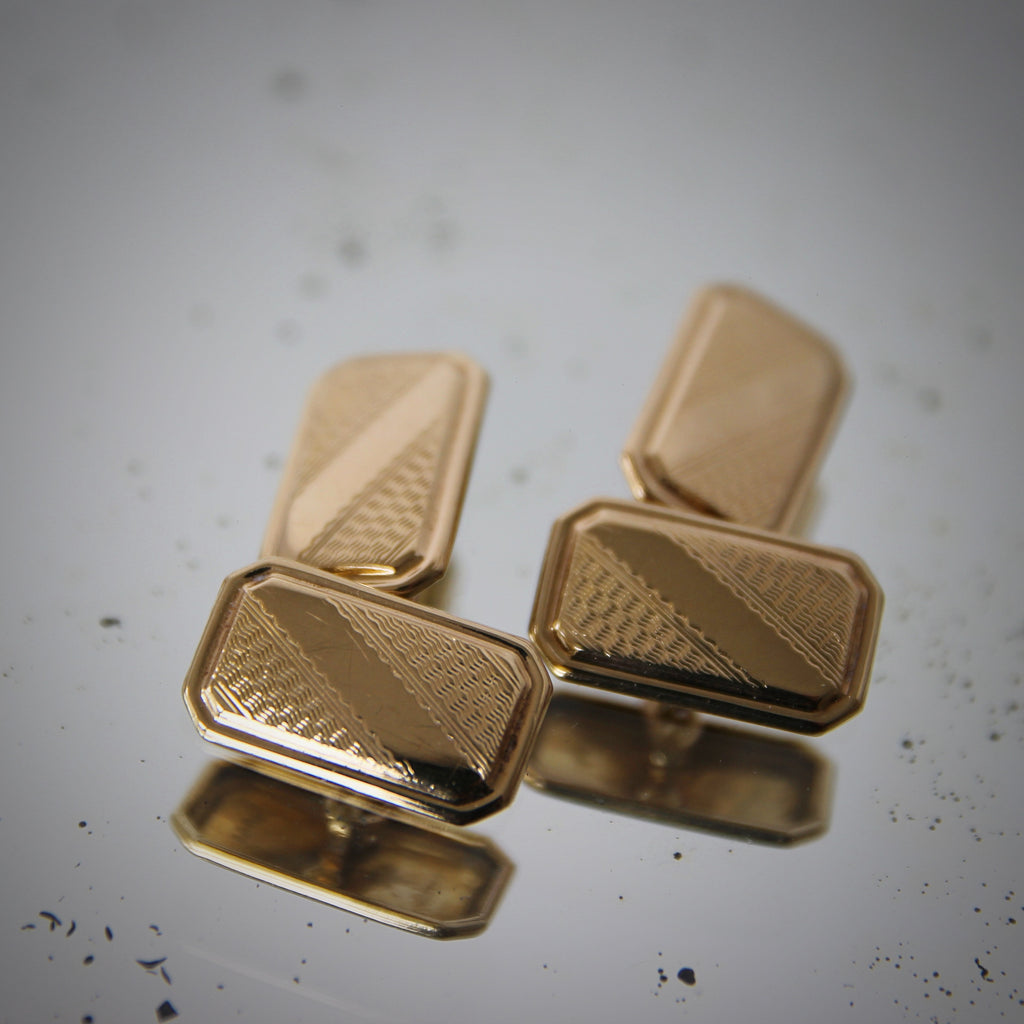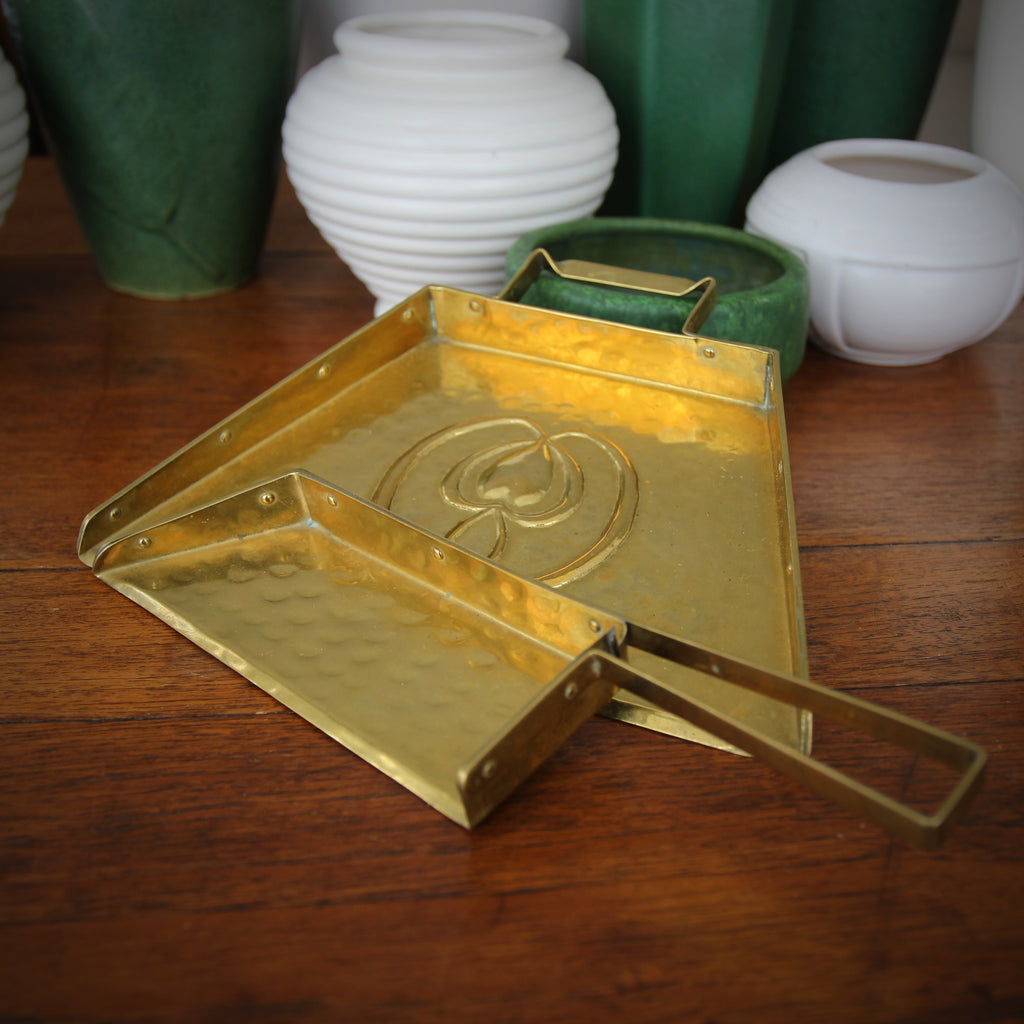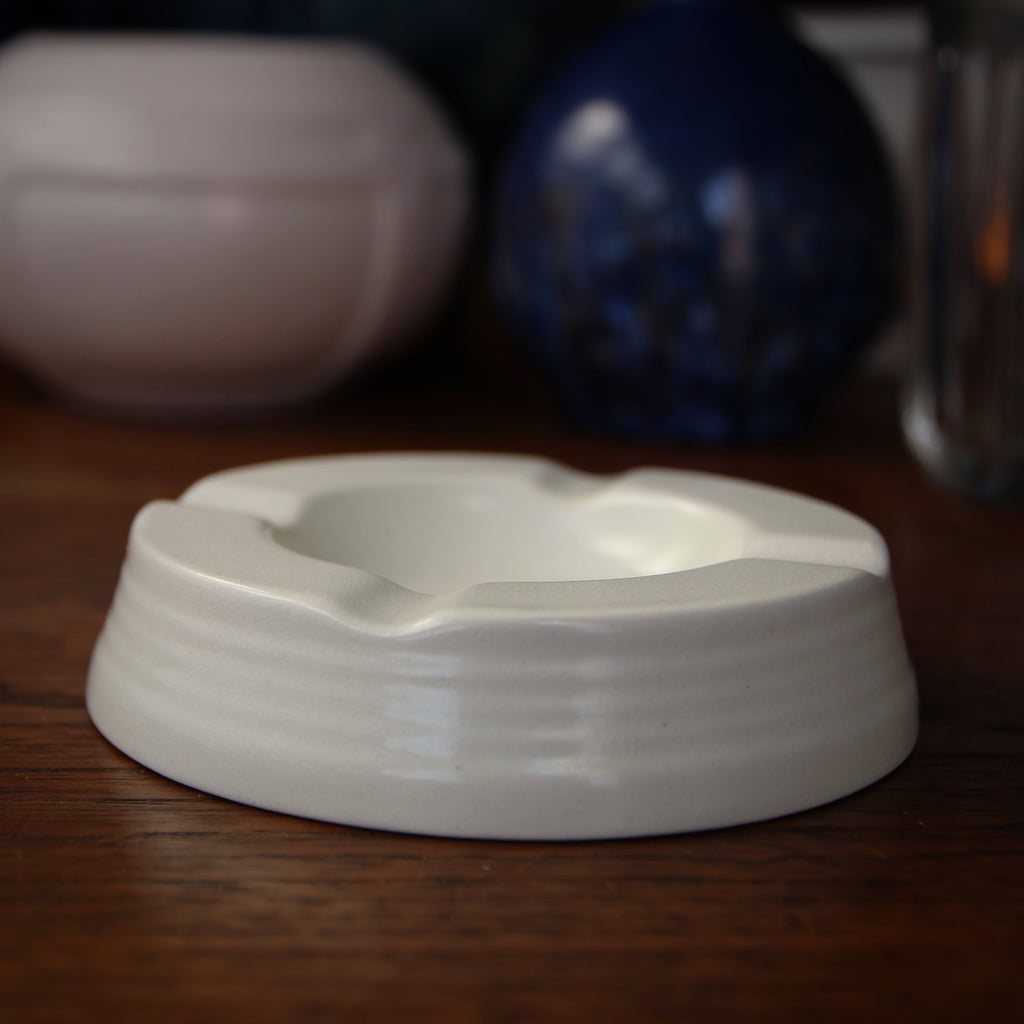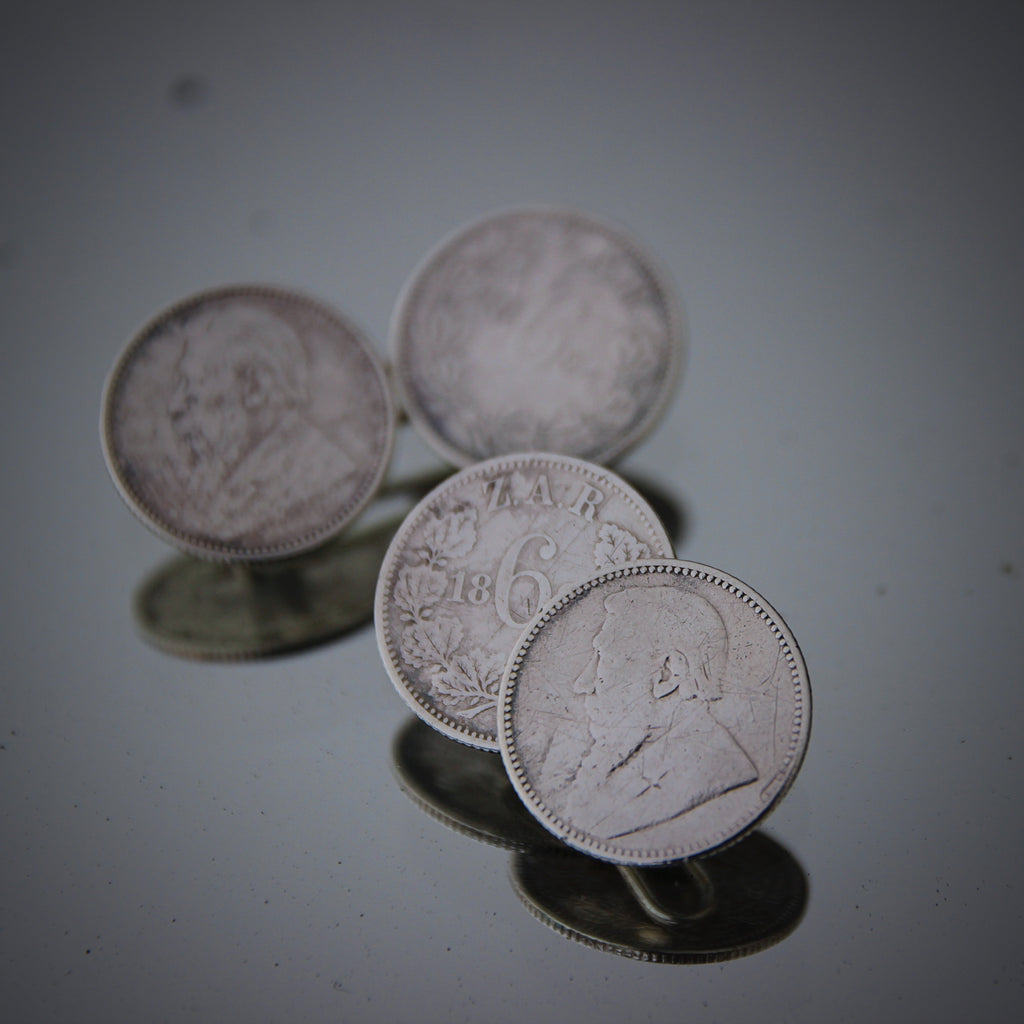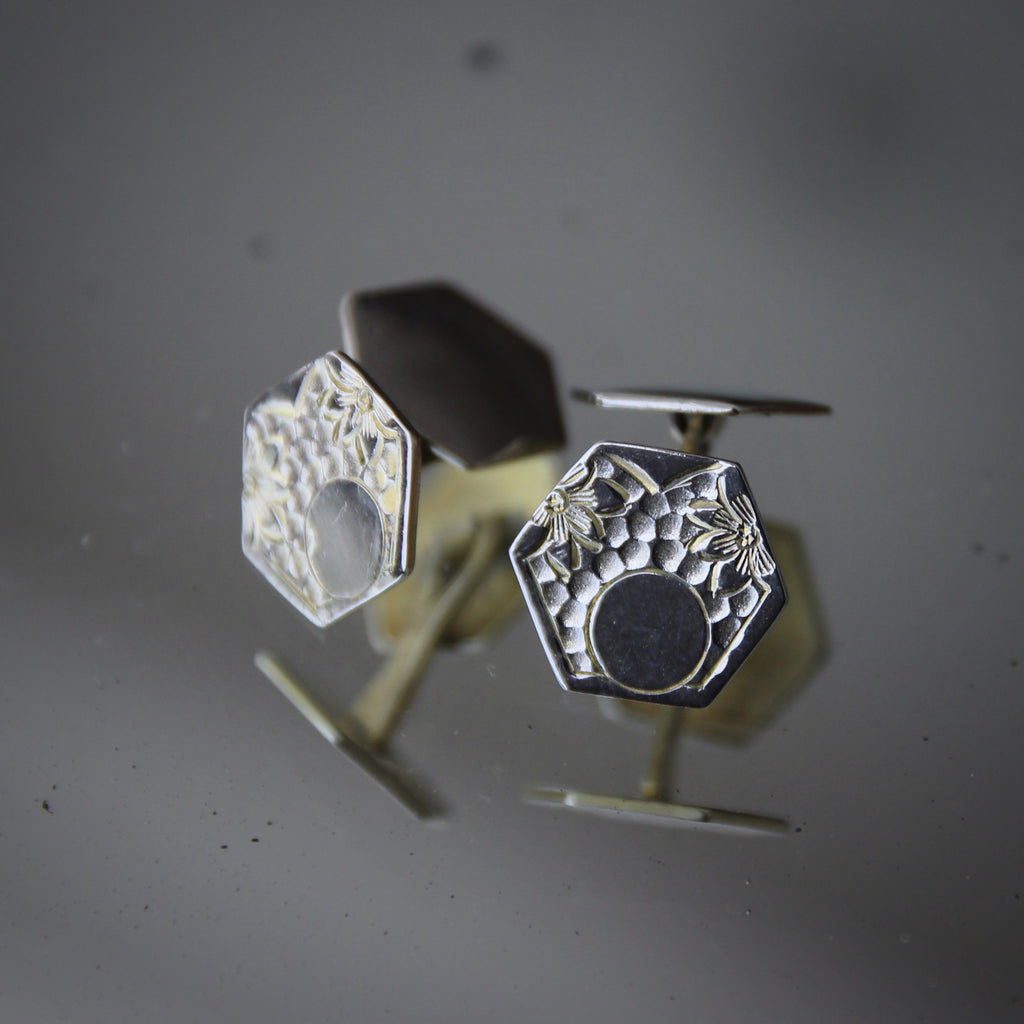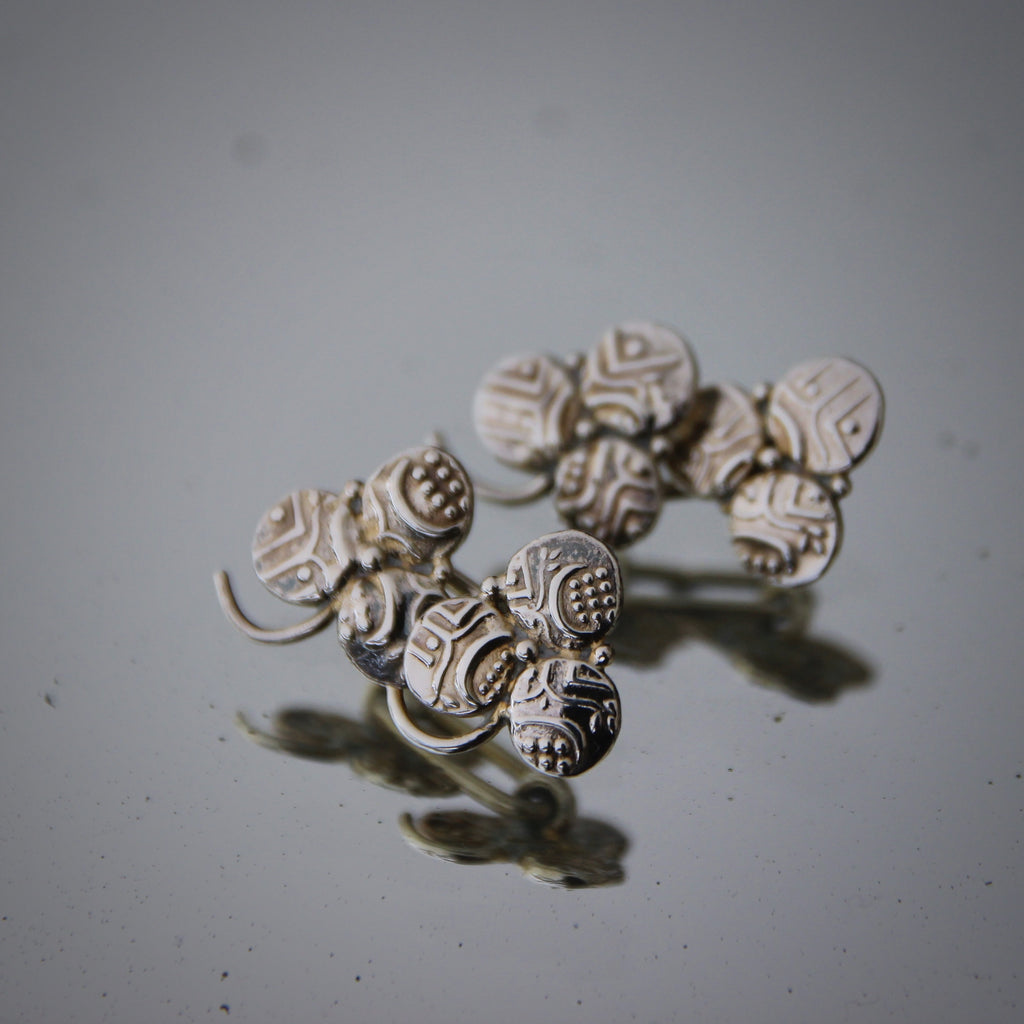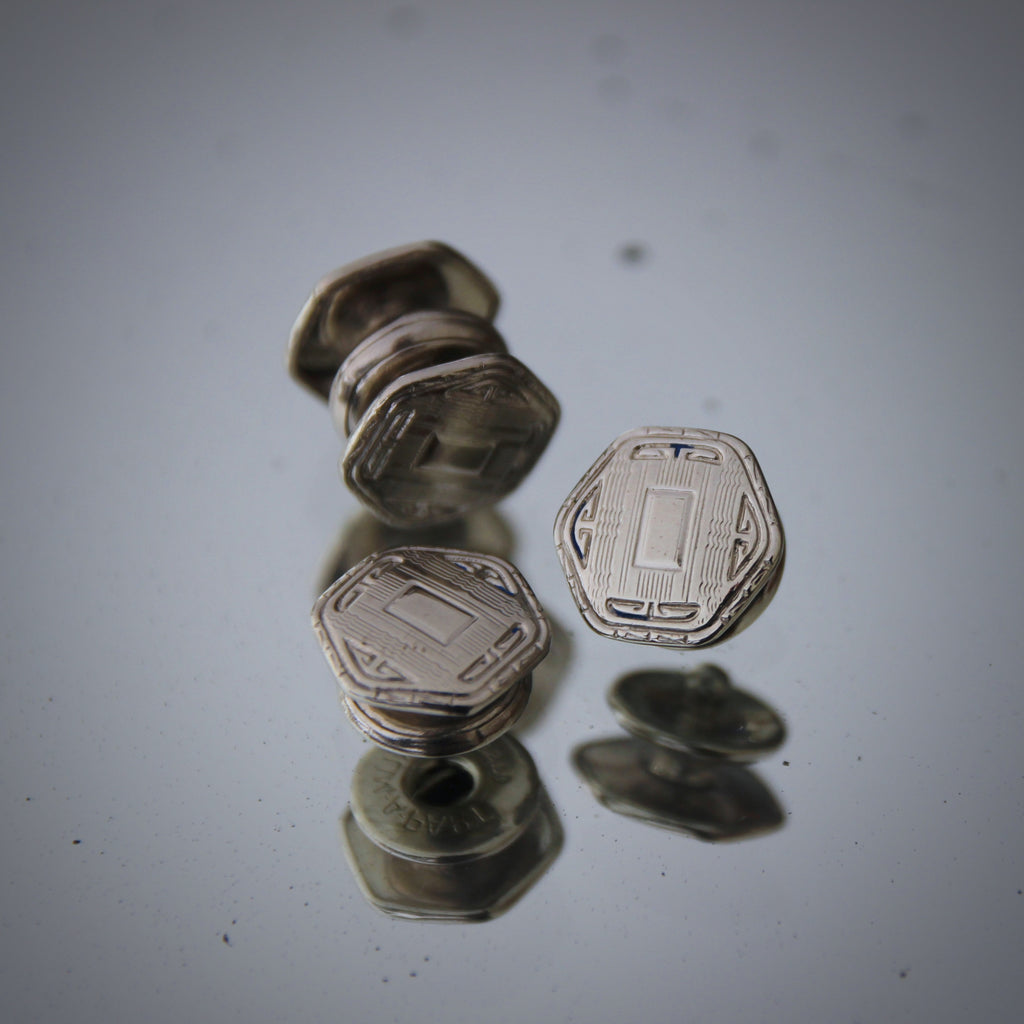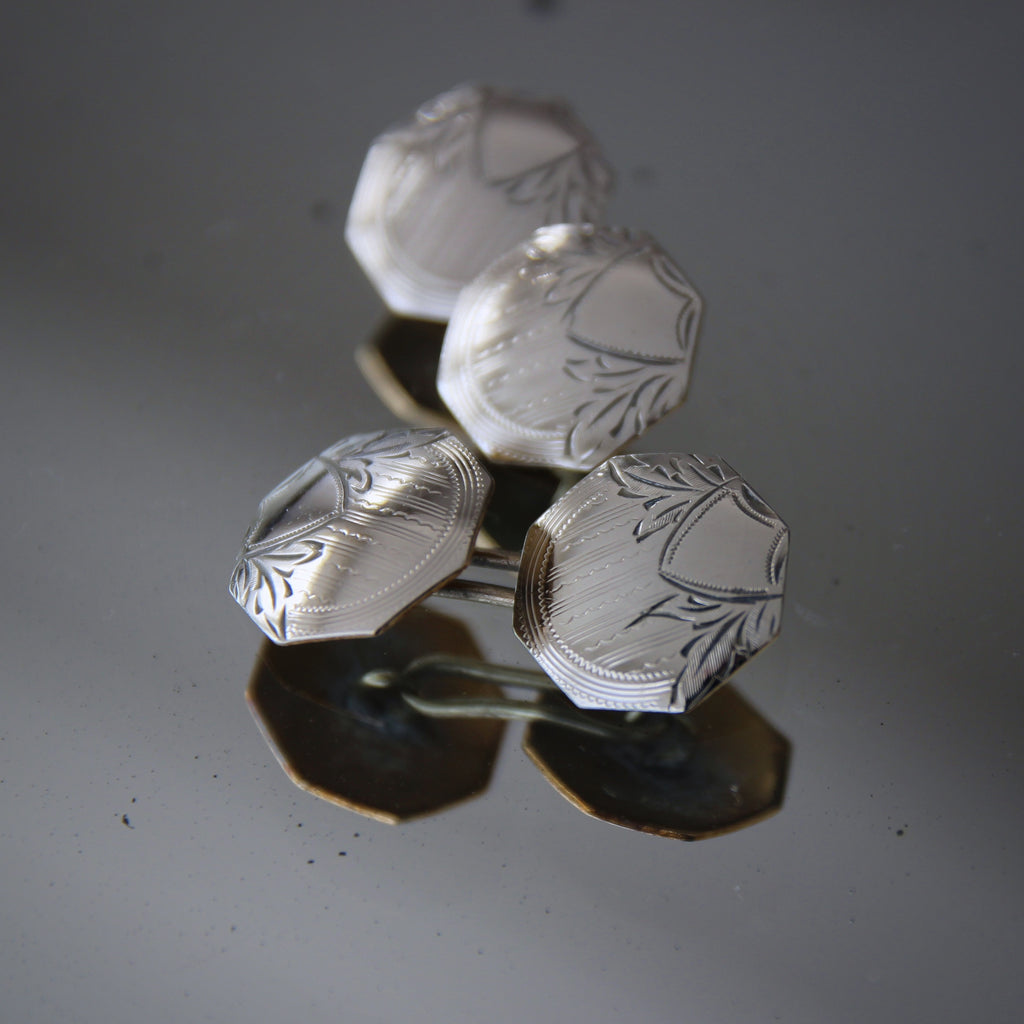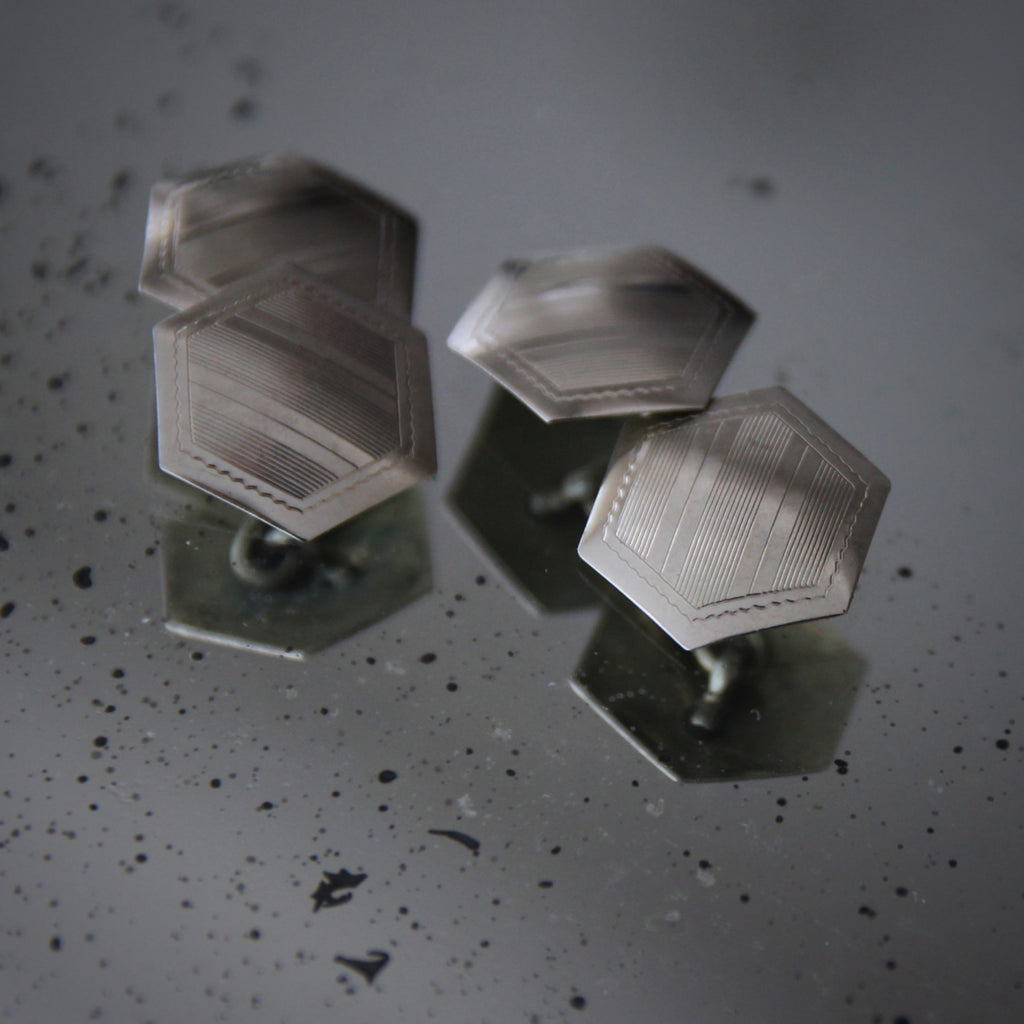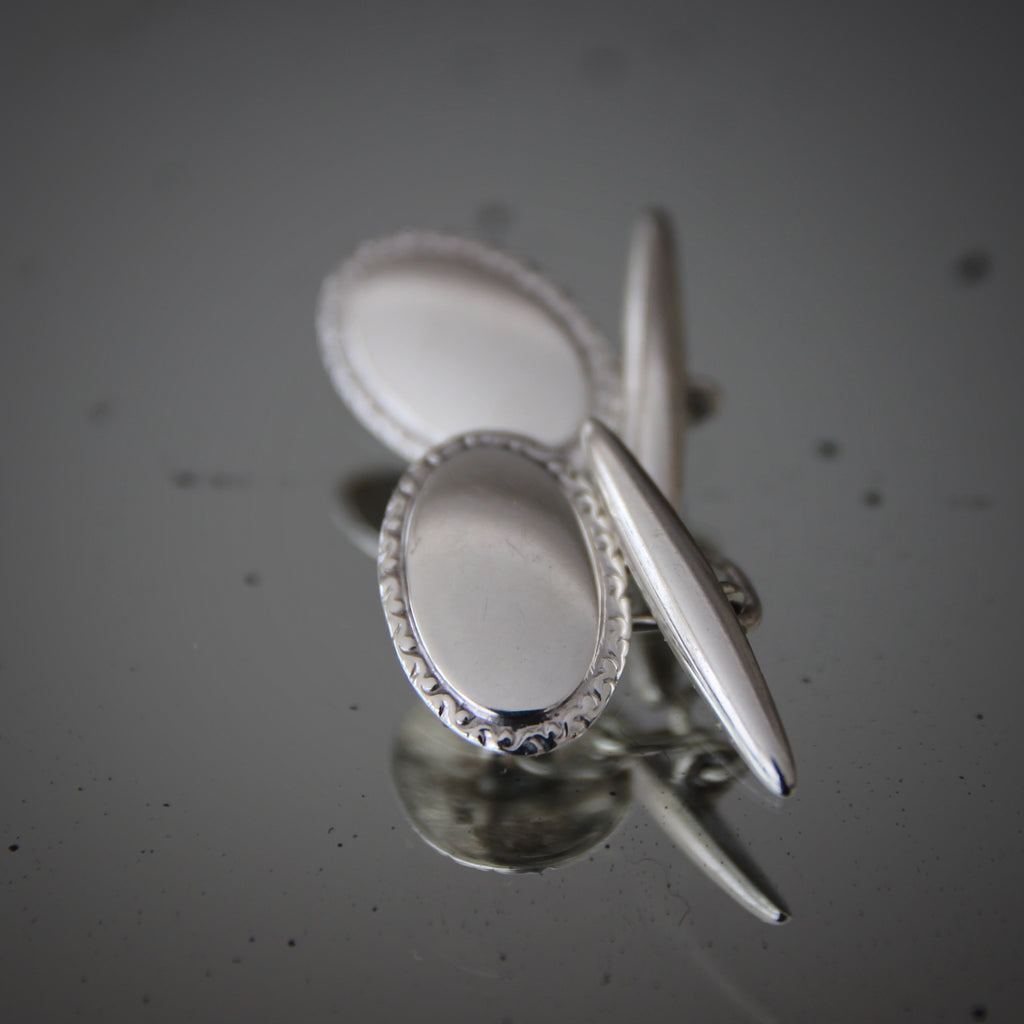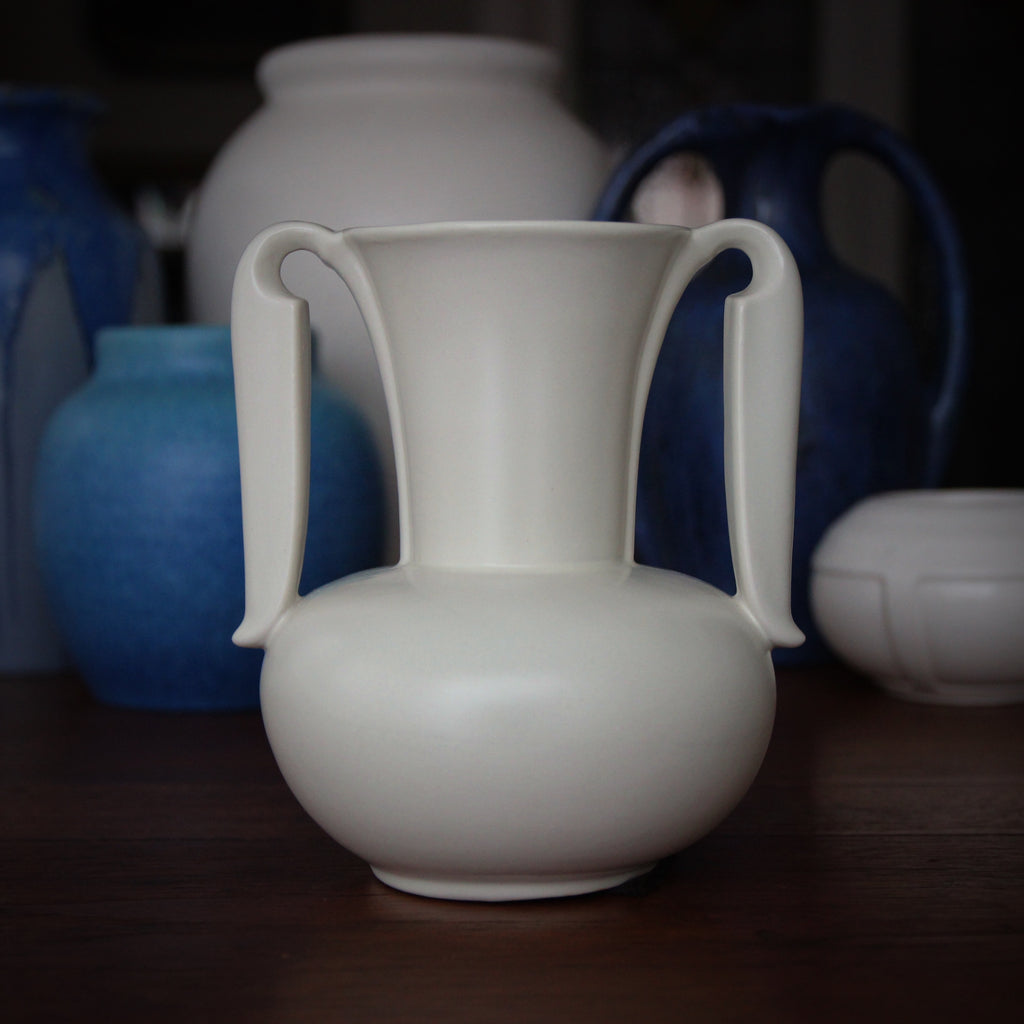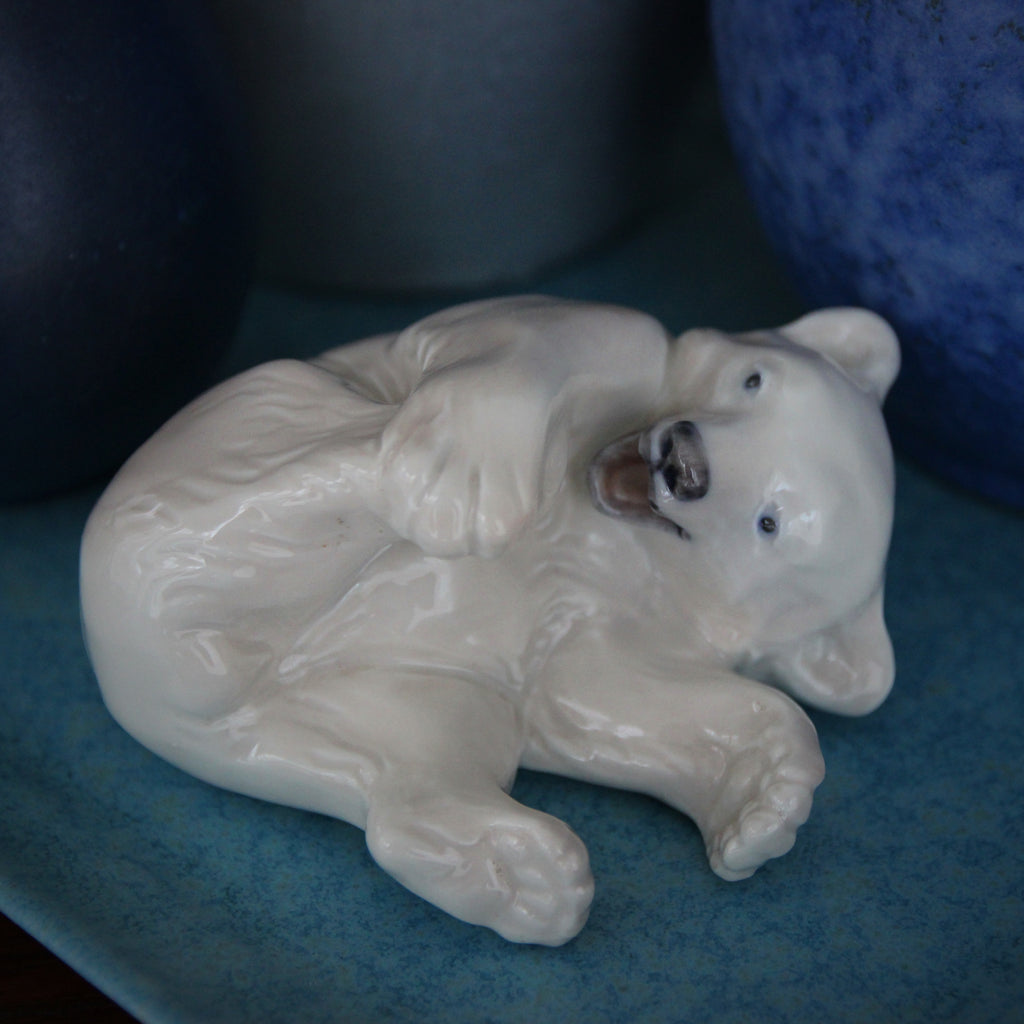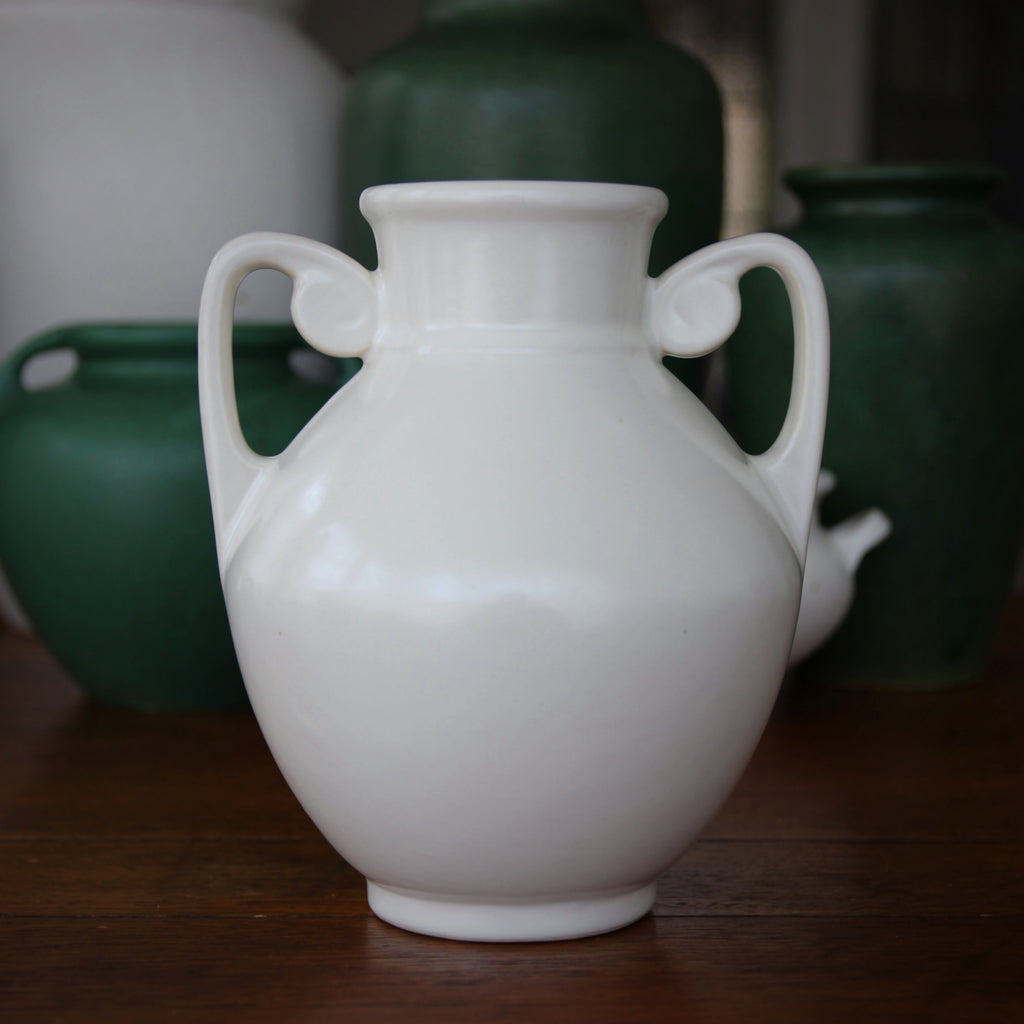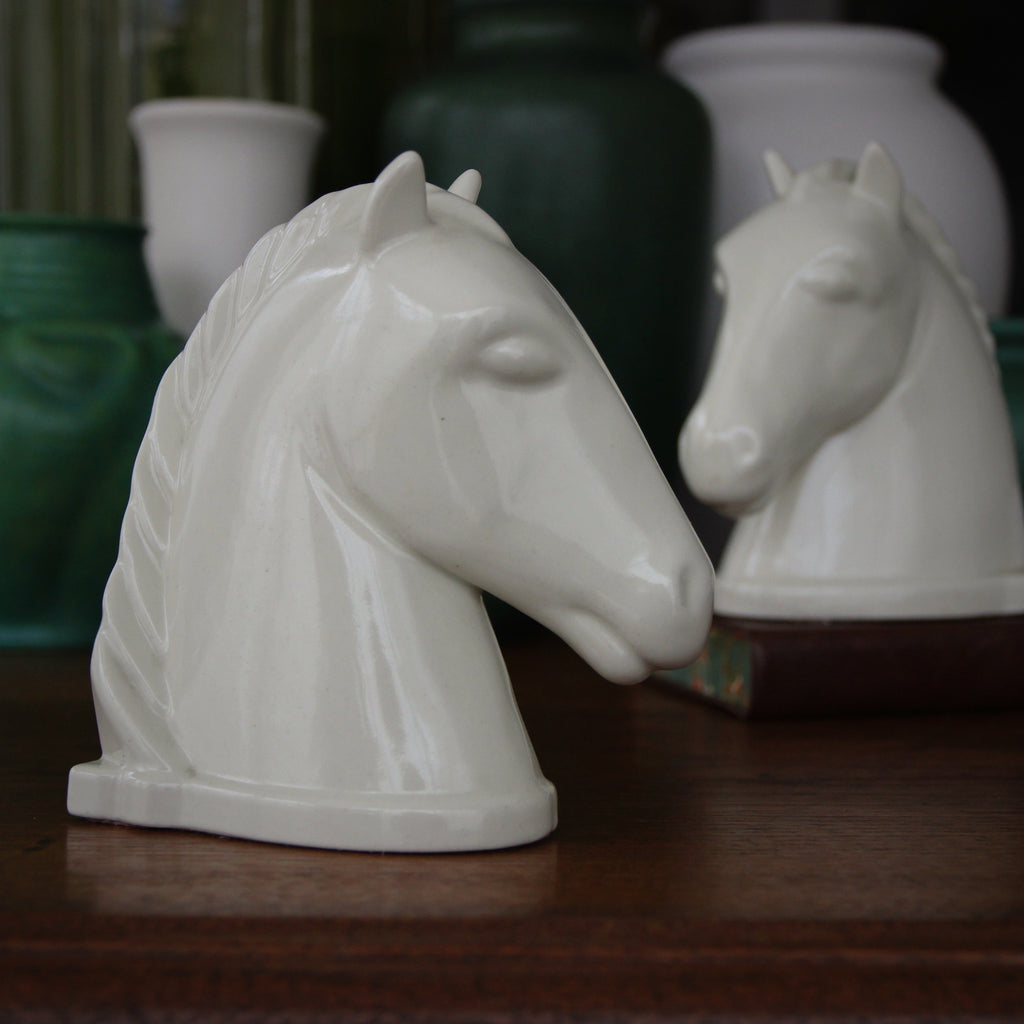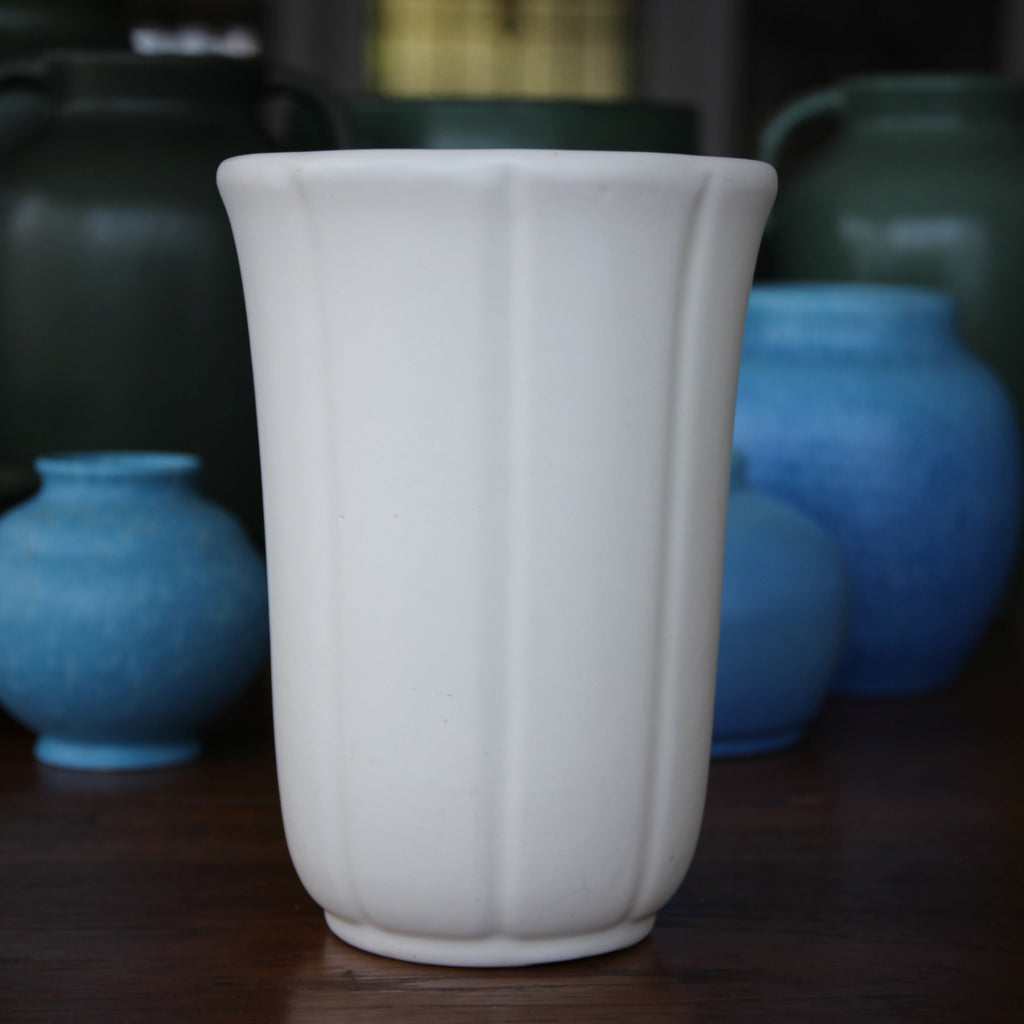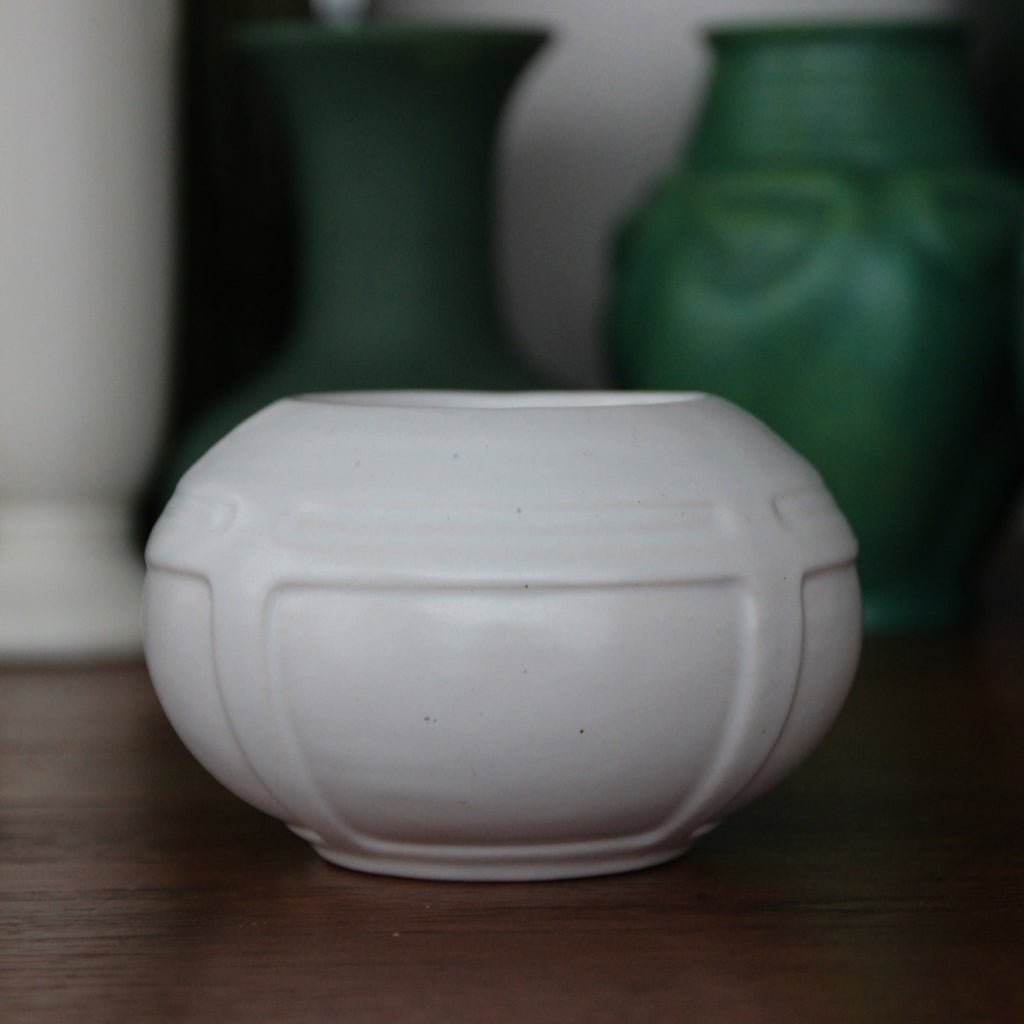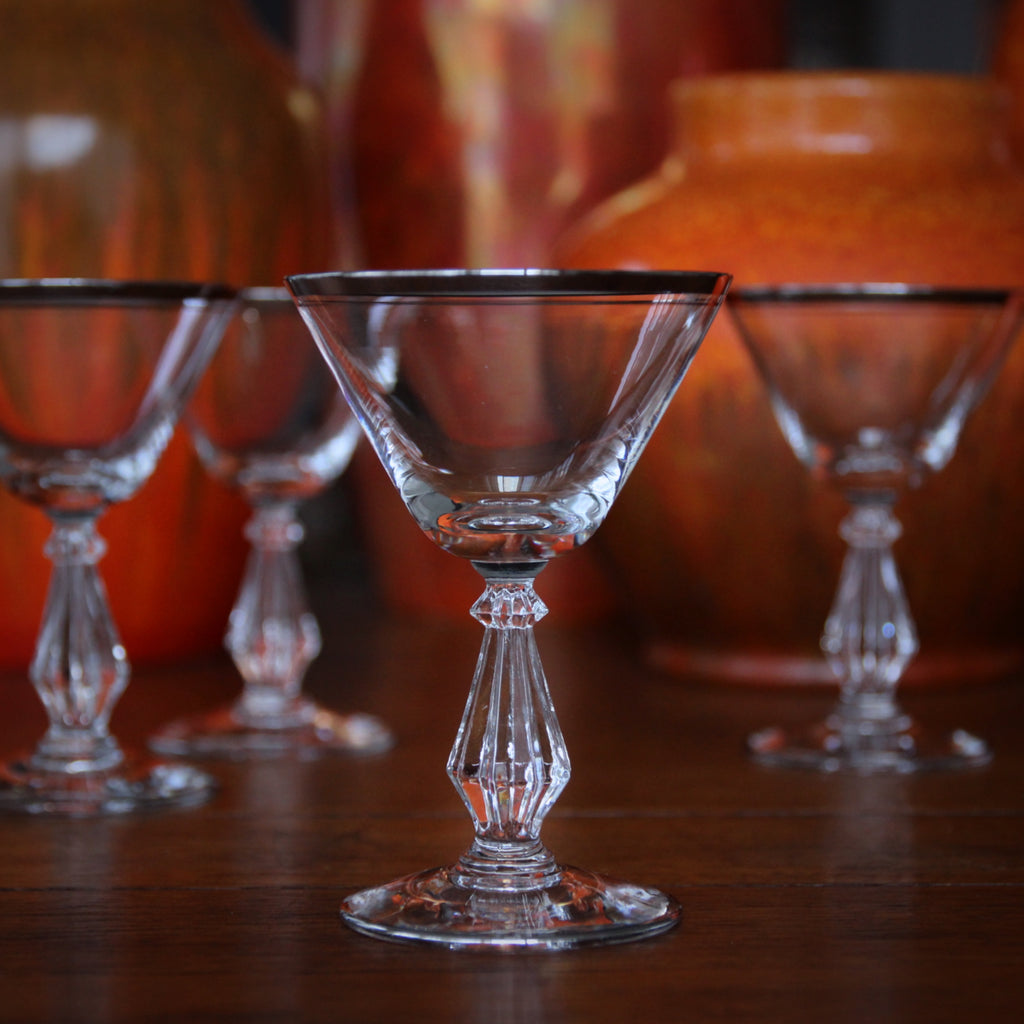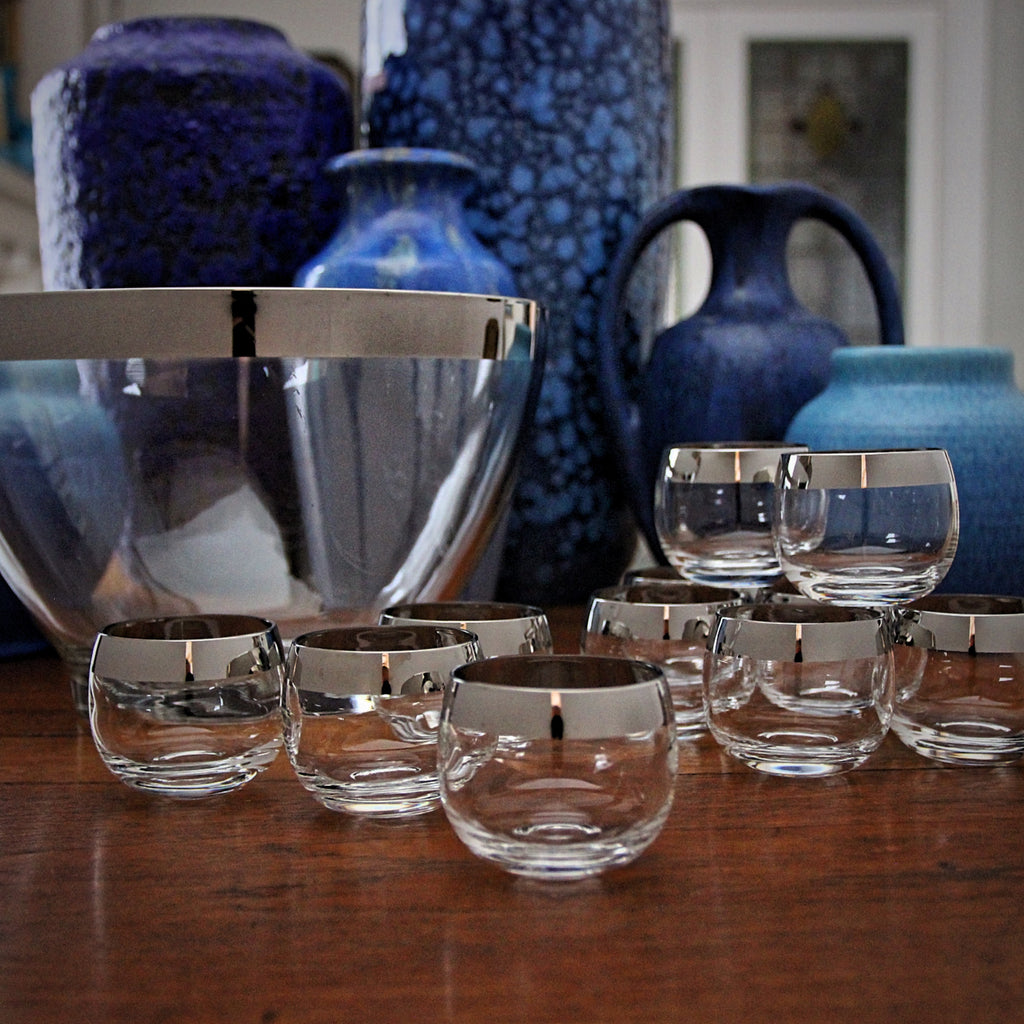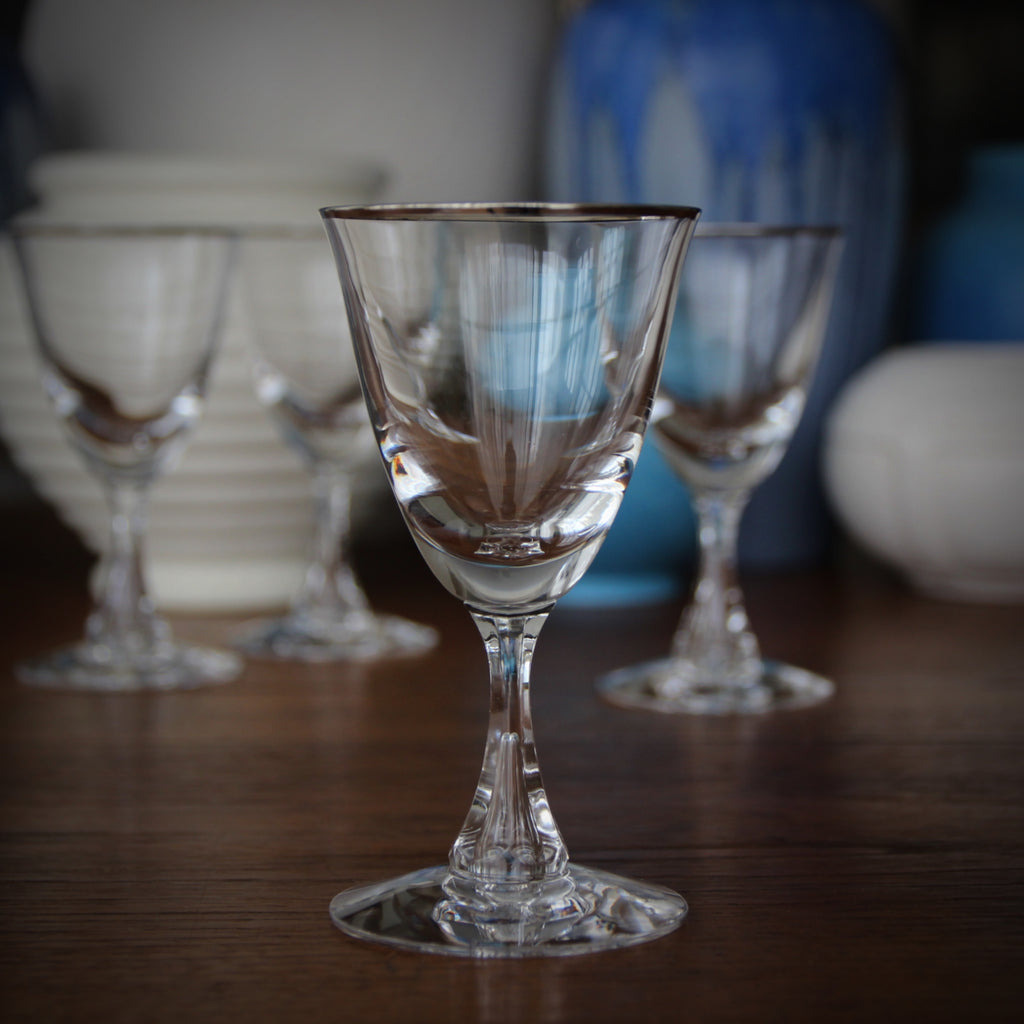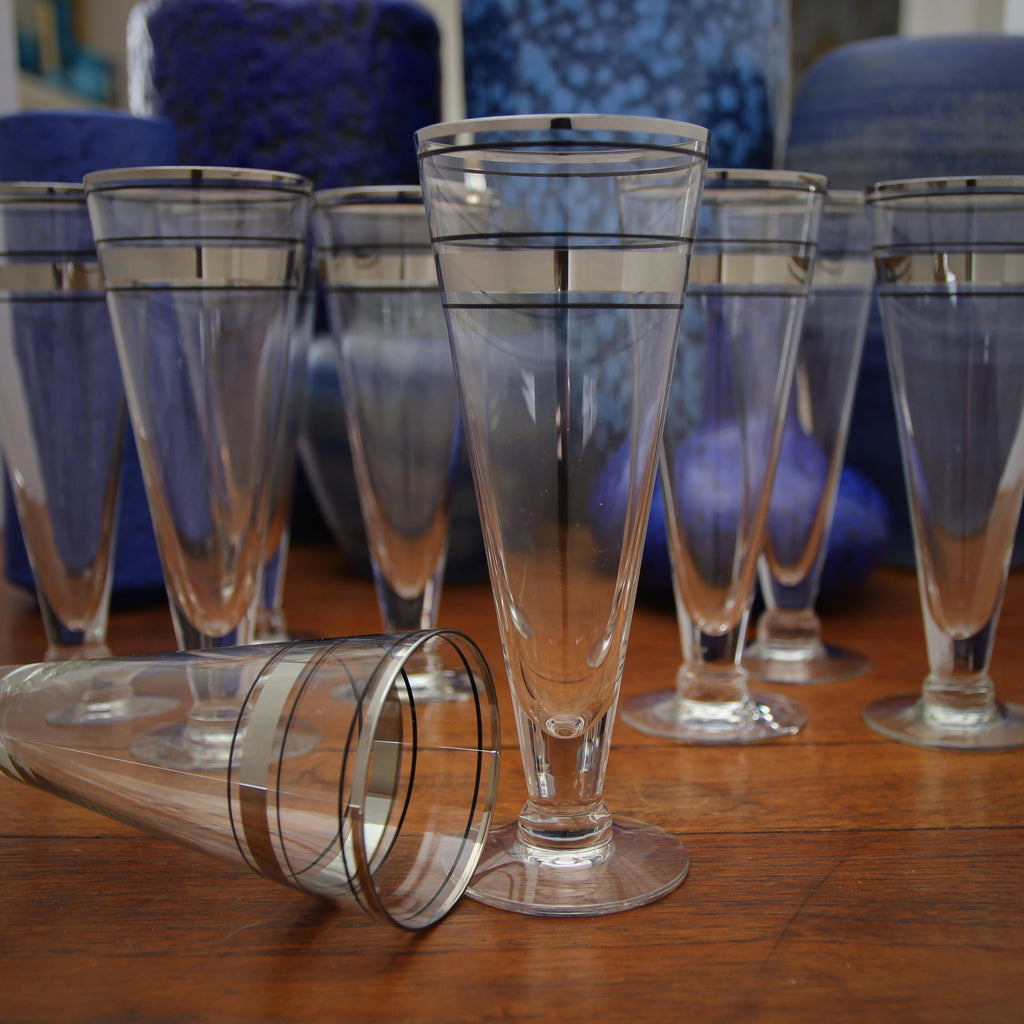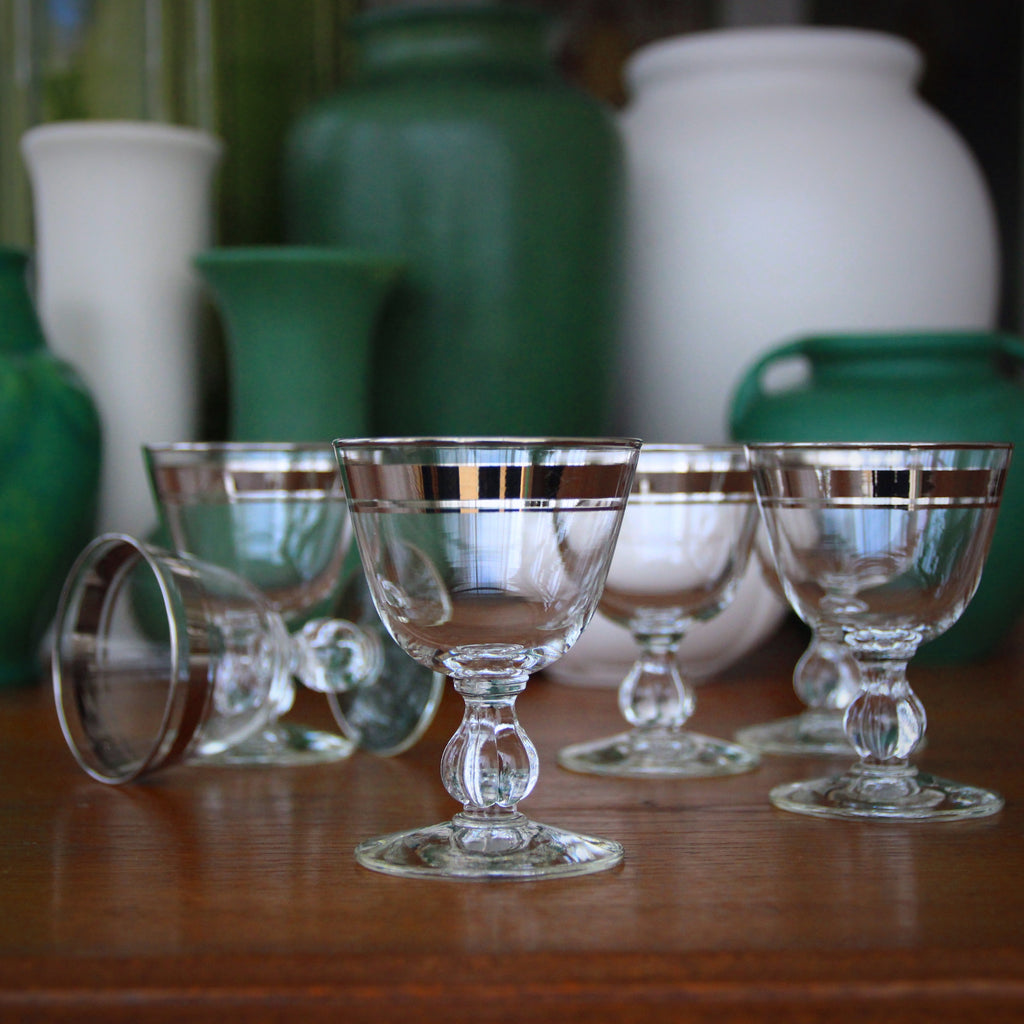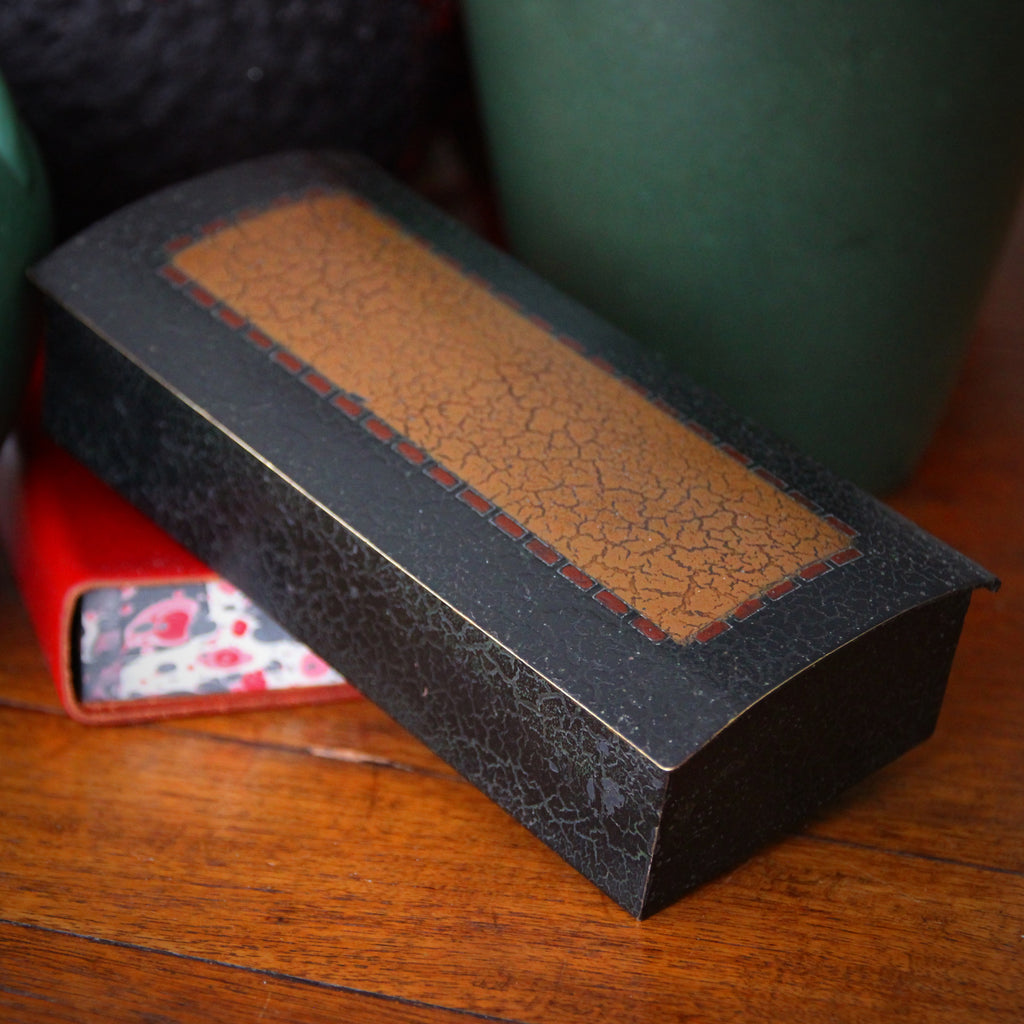JOURNAL RSS
Two weeks from today—18 April 2022—is Tax Day, that annual heavy lift that we keep putting-off 'til the last minute. For me, it is also the annual season of resolution: resolution to organize myself and "never go through this again!" To that end, here's a small solution. (A very small solution.) This little bronze Arts & Crafts organizer, made by Silvercrest (c. 1920), could make your organizing just one little bit easier. The bronze has a mottled and textured surface and is enhanced with an applied silver scrolling pine motif. It could hold fresh stationery, payments to be mailed, or envelopes containing receipts for tax time.
Cheers!
Beverages always taste better in crystal. This set of six crystal wineglasses have vertical ribs, a laurel wreath band, radiant cuts to the foot, and a knuckled balustrade stem. Holding eight ounces apiece (when filled to the rim), they'll ring beautifully with every "Cheers!".
Real, true crystal—the organic material—is the purest form of quartz. The best examples of rock crystal are as clear as glass; most samples have streaks or veins of cloudy white. Sometimes called "rock crystal," this natural stone is mined and (for many centuries) has been fashioned into jewelry, vases, chandelier pendants, and drinking vessels. It is from this original "crystal" that leaded glass gets its name (although leaded glass is not crystal at all).
Old Giza
The Great Sphinx of Giza is the oldest known monumental sculpture in Egypt, completed around 2500 BC. It is also one of the most recognizable monuments in the world. Two thousand years ago—during the Greco-Roman Period—rich and powerful citizens made the difficult journey to stand before what was at that point an antiquity. The Sphinx crouches along the West Bank of the River Nile, carved out of the bedrock under the plain. The large mass of extraneous stone, removed during the carving, was intended to be used to build a temple surrounding the Sphinx (though this was never completed). The Sphinx stands 66 feet high and 240 feet long. It was originally painted, archaeologists believe, because traces of color have been found in...
Understated Elegance
On this day in 1866, just months after the close of the American Civil War, George Krementz founded his jewelry manufacturing company in Newark, New Jersey. For the first 12 years, he made a "general range" of women's jewelry but strictly for wholesale trade to other jewelry makers, not under the Krementz brand name. In 1884, he received a patent for his new collar stud design (which would become the first men's item he would manufacture). Collar studs were used to attach starched collars to dress shirts, in the days before they were sewn together. Krementz's new design was of one-piece construction (no seams, thus stronger) and could be made quickly on the new machinery he developed. Shortly after receiving his...
Technology Face-Off
Technology—and the corporate campaign to exploit it—transforms and adapts to satisfy the "needs and opportunities" of the times. Sometimes a "face-off" ensues: as technology marches forward, new businesses blossom and grow while other businesses wither and fall-away. Over the last 150 years, industry has responded (multiple times) to the way society reads and collects information. Let's close-out the month of March with this interesting bookrack, made shortly after the Turn-of-the-Twentieth-Century. Before the Industrial Age, there were very few people in the Middle Class. There were a handful of land and factory owners and a mass of people who worked for them. Though people were taught to read, only the wealthy could afford to collect many books. A private library was only within...
Beautifully Receptive
Yesterday we shared a French ceramic "comb dish"—once used to neatly tuck-away a comb on the dresser, washstand or vanity table. Today we share an Edwardian English "hair receiver." An object like this would be found on many an upper class woman's dressing table. As a woman brushed-out her hair, probably before bed, and loose hair collected in her hairbrush, she would gather that hair and stuff it down into the hair receiver. When a sufficient amount had been accumulated, she would send it to a hairdresser who would fashion it into a hairpiece. That ornament, made of her own hair, could be worn by the woman to supplement her hairstyle. This turned ebonywood hair receiver is topped with an engraved...
Hidden Treasures
During the Victorian Age, there was an object dedicated to every possible use. This was especially true when it came to food service: celery vases, spoon warmers, berry bowls. But personal care and tidiness also enjoyed a wealth of strange and specific objets, like the French ceramic "comb dish" shown above. This ceramic covered bowl, decorated with a handsome Greek Key transfer print, would be stationed at a vanity table or upon a dressing table—providing a place to store one's comb between uses. It would contribute a measure of orderly process to one's morning ablutions. At a woman's grooming station, there also would be a "hair receiver," a small canister into which she could push the loose hair pulled from...
Ode to a Shrinking Font Size
Every year, it seems, the fine print on boxes, documents and mobile phones gets smaller and smaller. Is Kellogs attempting to use less ink? Perhaps Apple is trying to conserve pixels? Never mind, I say. Just start a collection of magnifying glasses—and position them strategically around your home and office. This brass-framed magnifying glass is nice and strong. The antique patina provides a handsome finish.
Lean Times
England enjoyed powerhouse economic growth in the Nineteenth Century. But, after World War I (1914-1918), England fell into a slump which lasted throughout the 1920's. Things got even worse in the Thirties as the whole world suffered the Great Depression. Then came the War—a terrifying six years of danger, loss, debt and economic deprivation for England. Unlike in the United States, where the economy boomed after the War, the decade following World War II was still very poor for the British economy. England had lost many of its export markets, racked-up tremendous debt, and needed to re-build its destroyed infrastructure. It was not until the Mid-Fifties that England was powered-up and producing at an impressive clip.
School's Back
To the delight of parents nationwide, "real" school is back, at least for now. After months of video classes, isolation and hoping for a children's vaccine, it seems that the morning school bell has finally rung.
The school bell, shown above, was made in England in the late Nineteenth Century. It is made of a type of bronze—sometimes called "bell metal"—in the Aesthetic Movement style. Horizontal etching on the body becomes horizontal ribbing on the shaft—carried-through to a turned, ribbed ebonywood knob at top.
Nine Months 'til Christmas!
It's beginning to look a lot like . . . Spring. But Christmas is a short nine months away. Start your shopping now! Here's a pewter Christmas Tree, made in Los Angeles, which could be hung upon the tree or in a window. It can also be used as a holiday candle snuffer. Click on the photo above to learn more about it.
To Clean or Not To Clean?
How much to polish antique metal is a matter of personal taste and local custom. As a rule, antiques dealers generally believe it is better to do less—and preserve the value of something—than to over-clean (or over restore) something and destroy its value. English antiques dealers tend to go a bit heavier on the polishing of antique metals than their American counterparts. For me, it depends on which metal is being considered and what the metallic object is. Copper, as long as the finish is nice and even, I will never polish. There is nothing more beautiful than a deep, rich, dark, nut brown copper finish—again, as long as it's even. The same is even more true of bronze....
Crouching Tiger
We're now several weeks into The Year of the Tiger—one of the twelve characters in the twelve year "Chinese" Zodiac cycle. Tigers are the LEOs of the Asian Lunar Zodiac: courageous, assertive, thrill-seeking, quick-tempered, leaderly and desirous of being the center-of-attention. Notable Tigers include Queen Elizabeth II, Tony Bennett, Christian Bale, Leonardo DiCaprio, Lady Gaga and Stevie Wonder.
This little tiger—cast in brass and finished with a verdigris bronze patina—will sit quietly waiting for just...the...right...moment to spring. Until then, his tense energy will remain coiled and waiting (on your desk, bookshelf or windowsill).
Great Drama
Though it may be a cliché, it is often presumed that great artists lead troubled, tortured and turbulent lives. In the case of the great German composer, Richard Wagner (1813-1883), this seems to be the case. Two hundred years after his birth, his music works still electrify audiences—some of whom travel thousands of miles to see good productions of his masterworks. And, yet, some of the troubling aspects of his life still hover over his legacy, perhaps promoting even more scrutiny as the decades mount. Wagner was the ninth sibling born to his family. His father died when Richard was six months old and the boy grew-up believing that his stepfather, Ludwig Geyer (a playwright and actor), was his biological progenitor. Young...
A Link to Secessionism
Secessionism was the Arts & Crafts Movement variant of Vienna at the Turn-of-the-Twentieth-Century. Like its "sister movements" in other parts of the world, Secessionism marked the "movement away" from the prevailing design and aesthetic conventions which preceded it. It also utilized a distinctive vocabulary of design elements including natural and botanical motifs, the elevation of handcraft and the promotion of natural materials.
The cufflinks shown above are probably not Viennese (or even Austrian). They are most likely American. But they are certainly from the Secessionist period—and utilize a Secessionist-inspired scrolling motif.
Springing Goatward
At 11:33 am (Eastern Time) today, the Earth experiences the Vernal Equinox—that Springtime moment when the Earth's tilt is perfectly balanced against the Sun. Neither the Northern Hemisphere nor the Southern Hemisphere leans closer to the Sun. The result: the lengths of day and night (on this date) is almost equivalent all around the globe. It will also be the first day of Spring in the Northern Hemisphere (and the start of Autumn in the South). From this day forward, for three months (until the Summer Solstice), each day will have increasingly longer sunlight hours than darkness. Today is also the first day of the sun sign Aries. Aries is the first sign of the Zodiac—a fact befitting of Aries' hard-charging...
Puzzled
Art meets engineering meets intriguing plaything. This finely-engineered and beautifully sculpted "toy" could stand-alone as an objet d'art on your desk. It would certainly make a nice (and heavy) paperweight. But it is also a puzzle; its meticulously-honed solid brass members assemble into the geometric shape you see above. Made in Brooklyn, this little work of art will prove hard to resist. Visitors to your office will be unable to not pick it up!
The New Modern Woman
The 1920's marked the birth of a new Modern Woman. During World War I, while many American men were at war in Europe, women joined the labor force as never before (often replacing men who had been sent-off to fight). More women than ever experienced a taste of moving within the commercial working world and enjoyed increased independence, the result of earning their own wages. After the war, some women did return to home and hearth. But many more women seized the opportunity to reinvent their roles in society. Working outside of the home was one of the biggest changes. But style and fashion underwent changes, too. "Bobbed" hairstyles reflected the modern, sporty times. Clothing was revolutionized: out went the corsets...
The Wearing of the Green!
May the road rise-up to greet you. May the wind always be at your back. May the sun shine warm upon your face and rains fall soft upon your fields. And, until we meet again, may God hold you in the palm of His hand. A hearty greeting on Saint Paddy's Day! And an Irish Blessing, too. For such a small country, Ireland has certainly dispersed its countrymen far-and-wide. Most of this, of course, reflects the Emerald Isle's tortured history—and the need for the much-oppressed Irish to seek better conditions and futures. Isn't that the reason most people move far from home? Two of my grandparents, barely out of their teens, left their humble dairy farms in Ireland to seek work...
Cufflinks Are Not Earrings
We've sold hundreds of pairs of cufflinks over the years. Eighty percent of the time, the purchaser is a man buying cufflinks for himself. The other twenty percent of the time, it's someone else (occasionally a woman) buying a gift for a man. When I'm selling a pair of cufflinks to a woman—which are intended to be a gift for a man—the customer will will nearly always remark, "My husband's very conservative in his dress." She will guide me to show her the more-understated options. My response is always, first, to show her the more conservative options. Then I will explain that cufflinks are not like earrings. Whereas earrings are highly-visible, centrally-placed, and subject to intense scrutiny, a pair of...
Out-of-Sight, Out-of-Mind
For most of LEO Design's 27 years, we've sold more photo frames, antique and well-crafted contemporary, than any other type of item. People like being surrounded by nicely-framed images of loved ones—even if they have thousands of digital pictures saved on their iPhone photo rolls. Displaying a picture in-the-flesh makes it prominent. One comes across it—glances at it—unexpectedly, unintentionally. And that's what makes a framed picture so much nicer than a digital screen image: you do not have to seek-it-out in order to enjoy it. When the photo's out-of-sight, it's out-of-mind. The frame, shown above, is from the 1940's. The brass is embossed with a highly-stylized, scrolling botanical motif. The metal is formed into the frame's profile, it's cut and assembled,...
Dreaming of Summer
Summer is still months away. In fact, Spring has not yet begun. But we can begin to dream of the idyllic Summer season: the warmth and the smells, the buzz of insects and the long, carefree afternoons. On reflection, I'm not quite sure when I last enjoyed a "long, carefree afternoon." Considering the news, the virus and the General National Tension, "carefree" has been a rare indulgence since . . . about . . . 2016. But the point isn't to have an idyllic day; the point is to dream of one. And that's where this piece of pottery comes-in. This "Empire Ware" English Art Deco ceramic jug was made in Stoke-on-Trent and is dated September 1933. The form is pleasant enough....
Peachy
Form, beauty and function—this French Art Deco decanter has it all. Its silhouette is inspired by the Medieval "Globus Cruciger," that orb-form symbol of monarchic earthly power (deigned from above). The pleasingly rotund vessel is blown in peach-colored glass. An "equatorial band" (the better to hold the decanter securely) is hand-faceted which matches the handsome faceting on the stopper. Such a vessel could be used to decant wine for serving at-table. Red or white wine would look great in it. But it would also be suitable for spirits—especially those strong (or sweet) libations which are served in small measures, like port, brandy or sherry. The decanter holds 20 ounces, a little more than half a litre.
Soft Brutalist
Add Sweden to the makers of cufflinks here at LEO Design. These sterling silver cufflinks, made in the late 1940's or 1950's, sit (aesthetically) somewhere between the earlier Art Deco period and the Brutalist Movement to come. Thus they present the crisp elegance of Deco while leaning-forward (but not too far!) into Modernist Brutalism. They present a "softer side" of Modernism—clean, elegant and not too chunky. They are crafted of 925 silver.
A Real Gem
Lush "pools" of color—emerald, jade, forest green and turquoise—dapple and slide-down the walls of this Brush-McCoy vase from the 1920's. The company called this glaze treatment "Onyx" and it was produced in various shades of reddish-browns and bluish-greens. The name, Onyx, is apt. Like the namesake gemstone, each piece is a unique and random (mostly uncontrolled) blend of colors. No two pieces are the same. The piece above really presents the rich and complex coloration and depth of the polished gemstone. The process involves multiple applied glazes which "activate" during the firing process, running, blending and creating new and unplanned color effects.
Georg Mendelssohn
Georg Mendelssohn (1886-1955) was a master metalworker, best known for his artistic brassworks in the early Twentieth Century. He was part of the Deutscher Werkbund, a progressive arts movement and predecessor to the Bauhaus School. His "primitive style" works (as they were called) fall within the greater Arts & Crafts Movement, called Jugendstil in German. Georg was born in Tartu, Estonia (then called by it's old German name, Dorpat). His family was well-educated, successful and upper middle class. Though his family had some Jewish ancestry, he was baptized and raised Lutheran. As a boy, he taught himself jewelry making. Shortly after the Turn-of-the-Century, while still in his teens, Georg moved to Italy where he helped found a Tuscan artists' colony...
Unidentified Flying Logo
I buy a lot of cufflinks while traveling in England and Scotland. Victorian, Edwardian, Art Deco and Modernism—my acquisitions span several periods and movements, from about 1870 to about 1970. The period which most catches my eye, it seems, is the Art Deco period of the 1920's and 1930's, that "Golden Age" of cufflink-making between the wars. But I also like early Modernist designs, too, especially if they seem to have evolved out of the Art Deco movement which preceded it. I search for cufflinks "with my eyes first," meaning, it is the appearance, design and visual aesthetic of the links which first pique my interest. Of course, material, condition, and theme also plays some role. But, if the cufflinks don't...
More English Deco
A bas relief bouquet of flowers and leaves rises from under a mottled melange of glazes—greens, blues and browns—on this English Art Deco flower vase from the 1930's. This is another good example of the "soft side" of the British Art Deco Movement. Whereas Art Deco often exhibited a streamlined, industrial and sharp-edged aesthetic of Futurism, the Brits seemed to develop the gentler, comforting side of the movement, as shown in the vase pictured here.
The vase, though indistinctly marked, exhibits the hallmarks of British Art Deco.
Tracks in the Snow
While Spring will be here in less than two weeks, there's still a chance that we may see a bit more snow. And, where there's snow, we find foot tracks. Human tracks, including the occasional skid mark. Doggie tracks, occasionally turning in circles. And the random tracks of wildlife—rabbits, squirrels, birds, deer and other indiscernible creatures—which "violate" the perfection of a new-fallen blanket of snow.
My "new" neighborhood in Pittsburgh adjoins the University of Pittsburgh—in a fairly well-urbanized district called Oakland. There are plenty of deer in the nearby Schenley Park, however, they rarely venture-out into the urban bustle.
Nouveau à Nouveau
What's old sometimes becomes new again. Here, a pair of French Art Nouveau silver cufflinks from just before World War One. Within almond-shaped "fields" bloom tiny gardens of flowers—life prevailing despite strict confinement. Alas, the Great War would change everything, including the aesthetics à la mode. Once the War was over, and life returned to normal, the world was ready for something different, something which augured a hopeful & progressive future. Art Deco stood in the wings, ready to take center stage.
The almond-like slivers pass easily through a buttonhole and provide an elegant, delicate closure to the shirt cuff.
That Ol' Thirties Feeling...
British design from the Thirties—the English Art Deco movement—has a certain comforting "roundness" to it. Whether looking at graphics (like period Underground transit signage) or industrial design (like electrical household appliances) or ceramics works (like the decorative pitcher above), the British take on Art Deco mass production seems to have accentuated the "softer side" of the movement. Other countries, France and America come to mind, communicated a more angular, streamlined and "bold future progressiveness" in their Art Deco design—which is beautiful, futuristic and hopeful. English Art Deco—with its gentle plumpness, soothing colors, and the safety of no sharp corners—often puts me into a warm, relaxed and nostalgic mood. The "vase" above, fashioned in the form of a large pitcher, bears a softly-overinflated appearance—distended...
Slouchy Puppy
Though this little sculpture is simple, the artist has deftly captured the slack energy—and curiosity—of a slouchy puppy. He is cast in brass and finished with an aged verdigris bronze patina. He would happily serve as a paperweight on your desk or provide companionship from your windowsill. His larger sibling is also currently available.
RUJT?
Are you J. T.? (Or, perhaps, T. J.?) This handsome pair of Soviet Era sterling silver cufflinks—dated 1 May 1956—are engraved with the letters T & J. A crisp, elegant border frames the monogram beautifully.
Russia is much in the news these days. Sadly, some political leaders and influencers (in Russia and America) are cheering for a reconstituted Soviet Union—and providing justification for the aggression. It's interesting to note that these very cufflinks were crafted during a period of hardship, discord and struggle. And, yet, their beauty managed to outlive the strife. Perhaps there's a lesson for us here: while bad periods pass (albeit after a lot of time and pain), human craft and beauty can survive and continue to inspire long after the conflict ends.
Spring Thaw
It's been a rather cold Winter, at least here in Pittsburgh. Lots of snow—which melts and refreezes into sheets of ice. But, despite the unpleasantness of the season, there is a cleanness to the Winter which I find refreshing (especially after the blinking energy of the Christmas Holiday Season). Nothing looks more innocent and pure than newly-fallen snow. Sound is muffled under the frosty, thick white blanket. The cold quells the smells which waft in the other seasons. And the chill drives many people indoors—making the streets and sidewalks just a little more peaceful.
The turquoise and white glaze on this West German Modernist piece—which appears to melt and drip down the sides of the vase—wears a certain wint'ry look.
Forward, March!
March—and her birthstone, the Aquamarine—is here! The name Aquamarine was coined in 1677; the clear, aqueous blue gemstone was reminiscent of seawater, or "water" + "from the sea." But the stone had been well-known well before this date. Ancient Romans believed that the gemstone had the power to calm the seas, thus protecting seafarers. In New Age circles, the aquamarine's clear, bright coloration symbolizes youth, purity and happiness. And they are believed to help bring happiness to marriages. Aquamarine is the state gemstone of Colorado. Aquamarines are the aqua blue variation of the gemstone Beryl. Because they are rather plentiful, aquamarines are not very expensive (unlike the much-rarer beryl variant, the emerald). And enormous aquamarines have been mined; the largest...
Victorian Refinement - XIII
The Art Nouveau Movement could be found in many Western countries during the late Victorian and Edwardian eras. It might be called Arts & Crafts (in England), Craftsman Style (in America), Jugendstil (in Germany), Secessionism (in Austria) or Stile Liberty (in Italy). While the different countries may express different aspects or aesthetic characteristics, their motivations remained unified: a move away from industrial production while promoting accomplished handcraft—employing themes of nature, honoring natural materials, and reviving historic cultural elements (literature, mythology, symbolism or indigenous graphics).
These 14 karat gold cufflinks were made in Austria at the Turn-of-the-Century. A scrolling botanical hand-etched design swirls about the faces of the cufflinks.
Victorian Refinement - XII
Jet is the petrified remains of Jurassic period pine trees—buried in oxygen-free bogs and tightly-compressed for millions of years. Actually, jet is a type of coal and it will burn if placed in a fire. When touched with a red-hot needle, jet will emit the smell of burning coal (which it is). While it is considered a gemstone, it is not a mineral (for there are no crystals in it). Instead, it is classified as a mineraloid. The oldest discovered jet objets are small amulets, carved circa 10,000 BC and excavated in Germany between the World Wars. Though jet can be found around the world, "Whitby Jet," from Whitby, England, is perhaps the oldest and most famous deposit (at 181 million years...
Victorian Refinement - XI
A light—but stylish—engraved treatment adds an elegant zing to these handsome Victorian Aesthetic Movement rolled-gold cufflinks, made at the Turn-of-the-Century. Such a restrained and tailored look is well-suited to elegant menswear. I see them on a soft blue shirt—with crisply-starched cuffs—peeking-out from the sleeve of a dark grey, chalk-striped wool. Conservative, perhaps, but classic to the core.
Victorian Refinement - X
This pair of American Victorian cufflinks are a dynamic swirl of floral engraving, etched graphics and an energetic, circling border meant to contain all the motion and energy. They were made around 1900 in Providence, Rhode Island—a powerhouse of American jewelry manufacturing in the late Nineteenth and early Twentieth Centuries. They are signed "Parks Brothers & Rogers" which operated from 1892 until 1930.
Victorian Refinement - IX
The Scots love their stones! Colorful semi-precious (and just plain decorative) gems are used in all manner of traditional jewelry and ornamentation. These Victorian Scottish cufflinks from the 1890's are crafted of beveled slivers of red agate. The traditional design of the silver fasteners reflect the period and style in which the cufflinks were made. The result is a handsome and handcrafted look which honors the stones so dear to the Scottish people.
Victorian Refinement - VIII
Though made in the Victorian 1890's, these cufflinks have a handsome Georgian sensibility: simple, restrained, elegant. The "mounded" oval forms are polished but otherwise left clean—making them suitable for the engraving of a monogram. Although unmarked, they have some gold content of unknown percentage. Monogramed or not, they would provide a classic, understated closure to your shirt cuffs.
Tuesday, Two Twenty-Two Twenty-Two
We interrupt our regularly-scheduled programming (Victorian cufflinks) to make note of this exceptional day: Tuesday, Two Twenty-Two Twenty-Two!
Two golden (polished bronze) eggs sit in this rustic cast-bronze nest, lovingly crafted in Canada. Such an interesting desk item will certainly provoke visitors to pick-up and fondle the clutch. The nest, alone, would make a perfect clip holder, ring saver or place to throw your keys near the door. And, of course, the two eggs will forever commemorate this special date.
And now: back to our regularly scheduled programming...
Victorian Refinement - VII
The English jeweler, Charles Horner, founded his namesake company in West Yorkshire in the 1860's. Although he made a large range of jewelry, the company is best known for its sterling silver Arts & Crafts hatpins, necklaces and brooches, which are usually enameled. Charles died in 1896 after which his sons opened a new workshop and expanded the product line to include other silver objects including clocks, silverware and various table service items. Most of Charles Horner's sterling was taken to the assay office in Chester for official hallmarking.
After WWI, the company began producing items with the new plastic material "casein" (under the trade name "Dorcasine").
Victorian Refinement - VI
In architecture and the decorative arts, a "grotesque" is a hideous human or animal face used in a highly embellished (and theatrical) manner of decoration. They have been utilized since Ancient Roman times, perhaps to illustrate the dark side of human behavior or to scare away evil spirits or habits. The name is derived from the Italian word "grottesca" which means "from a cave," for it was by being lowered into caves that 15th Century archaeologists rediscovered Emperor Nero's Domus Aurea palace in Rome—where such grotesque masks had been employed with abandon. Grotesques were much-used in the Medieval period, too, especially in churches, reminders to the faithful of the ultimate wages of sin. They were intended to frighten the congregants while warding-off evil....
Victorian Refinement - V
The Aesthetic Movement flourished in the last three decades of the Nineteenth Century. It could be considered a precursor to the Arts & Crafts Movement—with its liberal use of stylized botanical and naturalistic themes, the strong influence of Japanese graphic design, and a fearlessness of presenting handsome physical adornment.
Aestheticism valued beauty, above all, and argued that the only requirement of art was to convey that beauty. "Statements" (like morality or justice or historicism) were not required of great art. Aesthetes promoted "Art for Art's sake" and "Beauty for Beauty's sake." Good taste, artistic talent, and (above all) aesthetics were the hallmarks of great works. If a painting (or sculpture or lamp or necklace) was beautiful, no further statement was necessary.
Victorian Refinement - IV
A lush bed of engraved ivy leaves crowd the chevron-form faces of these English Late-Victorian gold-content cufflinks from the 1890's. Despite the tremendous detailing, they present a rather sophisticated look on the cuff—shape, color and subtle texture. Click on the photo above to learn more about them.
Victorian Refinement - III
Birmingham was a center of British Industrial Age manufacturing—and jewelry making was no exception. This "City of a Thousand Trades" has been producing metalworks, china, glass, weapons, automobiles and machinery for centuries. In the Nineteenth Century, Birmingham was called "The Workshop of the World" and it was populated with manufacturers large and small. Though the city is inland, a vast network of canals allowed cheap, fast and efficient shipping; raw materials were brought-in and finished goods were shipped out. Such direct access to coastal ports allowed high-quality Birmingham goods to be shipped-onwards to the rest of Europe, America, Asia and Africa.
Victorian Refinement - II
Queen Victoria reigned from 1837 to 1901—an era well-represented in our collection of handsome cufflinks. For the rest of the month, we'll be sharing some of these Victorian cufflinks offerings, many of them recently acquired.
Handsomeness is not the only interesting attribute of these Victorian English cufflinks from the 1890's. The polished carnelian "domed" cabochons are set into silver mounts—which can be "unclipped" and used as four shirt buttons on a dress shirt. Victorian ingenuity allows for variety and adaptability, even today.
Victorian Refinement - I
Cufflink production really took-off during the Victorian Era, thanks to the growth of the Middle Class (with a new-found discretionary income) and the evolution of industrial production (which made it possible to create quality goods in significant quantity at affordable prices). Victoria reigned from 1837 to 1901. Here at LEO Design, we collect American and European cufflinks from the Victorian though the Modernist eras with a sizable Art Deco collection. For the rest of the month, we'll be sharing some of our Victorian cufflinks offerings, many of them recently acquired.
The gold-content cufflinks, shown above, express elegant Victorian elan. A "ruffled" edge, decorated like architectural moulding, surrounds a central face, machine-etched with radiant engraving and a stylish "diamond" graphic at center.
Saint Valentine's Day
Saint Valentine was a Roman priest (and possibly bishop) who ministered to persecuted Christians in Third Century Rome. His evangelical efforts were not appreciated by the Roman authorities. He was arrested more than once, the final time by the Emperor Claudius Gothicas—who came to like Valentine. However, when Valentine pushed the Emperor to convert to Christianity, the monarch provided his own ultimatum: either Valentine renounce his faith or he would be clubbed and beheaded. The priest refused to renounce and was martyred on 14 February 269. Valentine's relics have proved popular for centuries—and remain so to this day—especially amongst those seeking love and marriage. Portions of his purported relics are venerated in the cities of Rome, Madrid, Vienna, Prague, Dublin, Glasgow, Birmingham,...
Tomorrow
If you're looking for a little "manly passion"—in a Valentine's Day gift, that is—may I suggest these handsome English Art Deco cufflinks from the 1920's. Red enameled rugby stripes zip across the oval faces of these links. Bold, masculine and very stylish.
Two Days Away
Saint Valentine's Day is a mere two days away. How about a lovely piece of art pottery for the lovely love of your life? This German piece, made by Otto Gerharz for Ruscha, captures the essence of Modernist beauty. A corseted, gourd-form shape—with two small handles—is a classic. Indeed, the form looks like it might have been excavated at an ancient archaeological site. The sensational glaze, however—crusty, dynamic, organic—is pure Modernism.
Following the Sun - X
For the last several days, we've been sharing a few of our favorite pieces of sunny, orange pottery. Nothing chases away the Winter Blues quite as well as a sideboard full or radiating orange ceramics! Let's end our parade of favorite orange ceramics with this handsome and commanding English Arts & Crafts piece by Pilkington Royal Lancastrian. This classic, high-shouldered vase was made in the 1920's. A curdled, deep orange glaze—over a brighter marigold—suggests molten lava running-down the sides of this vase. Its size, shape and coloration is certain to make it the center of attention—wherever you place it.
Following the Sun - IX
So far we've shared ceramics offerings from West Germany, England and the United States. Shown above is a Modernist piece from Hungary, made by the Toféj Kerámiauzem in Bodrogkerestzúr, a small village about 140 miles East of Budapest. It was made in the 1960's, in the decade after the Soviets invaded and decided to turn the previously small village into a center of industrial production (which included ceramics manufacture). It has a uniquely thick, mottled glaze and is finished with the workshop's signature yellow interior.
Following the Sun - VIII
The Arts & Crafts movement—indeed the entire Art Nouveau movement—employed various elements of nature in its designs: animals, botanical motifs, natural materials and glazes with earthy, organic sensibilities. Through the voluptuous curves of this English Arts & Crafts vase, shown above, peek the curling "fiddleheads" of fern fronds, seemingly ready to unfurl. The sensuous bas relief is dressed in a mottled glaze of orange and yellow. The piece was made by Pilkington Royal Lancastrian in the 1920's or 1930's.
Following the Sun - VII
Here's something a little different: a Dutch Modernist vase, finished in a matte burnt-orange glaze. But look closely. The glazing nearly throbs with life and texture. It's not "earthy" like terra-cotta, baked mud or a substance harvested from the environment. It's a masterful attempt to meld art and nature.
But there's more to this handsome vase than its coloration alone. The vessel's form is wonderful, too. It has a beautifully-conceived shape which appears distended—ever so slightly—as though it's been gently inflated with air, like a balloon. This tension of form gives the vase energy and life. Add a radiant glaze and you have a sensational piece which will look great either as part of a collection or standing alone.
Following the Sun - VI
This modestly-sized piece—about the size of a softball—provides the perfect counterpoint while sitting along the front row of a nice collection of orange ceramics. It's the right height and volume to provide variety of shapes and dimensions to your collection. And its deep orange glaze, mottled with a rich yellow underglaze, amps up the piece's presence.
Following the Sun - V
Matte glazes have always been my favorite, especially those which are organic, complex and highly-textured. This two-tone glaze—bright orange over vermillion—provides a random and dynamic finish to an otherwise streamlined (and unemotional) form. The color looks good enough to eat! It was made by Scheurich in West Germany in the 1960's or 1970's.
Following the Sun - IV
The organic, caramelized glaze—which drips languorously down the neck, shoulders and sides of this large English Arts & Crafts vase—only serves to heighten the molten sensibility of the underlying glaze. A mottled, rich orange seems to flow and curdle over the yellow glaze below. The effect is like the Sun, being coated in a dripping, cosmic sauce. And the impressive size of this vase ensures it will be a handsome "statement piece" wherever it is displayed.
Following the Sun - III
When I've travelled in German cities, I've always enjoyed taking the subway—the U-Bahn—to get around town, quickly, cheaply and enjoyably. In the German subway stations, two things never fail to catch my attention: 1. the fact that there are no turnstiles at the station entrance (fare payment is based on the honor system) and 2. the stations are often clad in fabulous Mid-Century Modern glazed tiles, not unlike the vases and other ceramics I've collected and sold over the decades. After Germany's defeat in World War II, the country was desperate to get its economy going and its people back to work. Labor was plentiful, under-utilized and cheap. Ceramics production—which is a highly labor intensive industry—took-off in Germany after the war. And the Germans...
Following the Sun - II
Sunny orange pottery was not only to be found on the other side of the Atlantic. The Thirties Art Deco urn, shown above, was made by Stangl in Flemington, New Jersey. The classic urn form, dressed with two drooping, foliate handles, combines Classicism with strong Deco style. The deep orange glazing adds additional weight to the piece—which will create a strong statement wherever it is displayed.
Following the Sun - I
Have you had enough of winter, yet? The Beijing Olympics have yet to begin and, already, I have seen enough snow. And let's not start talking about the cold!
Here's a little antidote: a collection of orange-glazed ceramics from LEO Design. For the next several days, we'll be sharing a few of our favorite pieces of sunny, orange pottery. Nothing chases away the Winter Blues quite as well as a sideboard full or radiating orange ceramics!
My favorite glazes boast organic, one-of-a-kind glazes. The nature of such glazes makes them hard (or impossible) to control.
It's February
Welcome, February, and your birthstone, the amethyst!
Amethysts were once amongst the most precious of "cardinal" gemstones—alongside diamonds, rubies, sapphires and emeralds. Their deep and regal purple coloration sat perfectly alongside the rich jewel tones of the other precious gems. In the Eighteenth Century, however, large deposits of amethysts were discovered in Brazil which reduced their rarity (and value), allowing wider distribution of the beautiful stone at more affordable prices.
Arts & Crafts Cufflinks - V
This week we shared a small collection of some of the Arts & Crafts cufflinks to be found in the LEO Design on-line shop. We end our presentation with this handsome pair of silver cufflinks.
Gothic and Medieval themes were commonly employed in Arts & Crafts design. These sterling silver octagonal shield-form cufflinks display two Crosses Pattée—a medieval cross of four equivalent members which widen from center to edge. In these cufflinks, one cross is hammered, the other is embellished with a small stylized botanical (like an Acanthus bud or Fleur-de-Lys). They would provide handsome punctuation on any wrist cuff.
Arts & Crafts Cufflinks - IV
One of the recurring design conceits which I've noticed in Arts & Crafts cufflinks is the combination of hammered metals with Greek Key meandering. Perhaps it's a way to "dress-up" the Arts & Crafts—a way to give the cufflinks a more-polished formality. Greek Classicism is used to provide a counter-balance to the more casual Arts & Crafts sensibility.
This modest pair of American Arts & Crafts cufflinks present hammered centers, encircled by Greek Key bordering. The silver-plated finish has warmed-up over the years, giving the cufflinks a soft, golden radiance.
Arts & Crafts Cufflinks - III
One feature of Arts & Crafts design was the "revival" of earlier themes: mythology, literature, aesthetics or other venerable ideas. The Gothic was a perennial favorite source of inspiration for Arts & Crafts designers and artists. Perhaps it was Gothic's rustic handcraft. Perhaps it was the romance of gallant knights. Or perhaps it was the lofty ideals (of heaven) that The Gothic strove to represent.
This pair of sterling silver Arts & Crafts cufflinks boast a Gothic shield-form silhouette. The silver is rustically striated, producing a rough-hewn texture, reminiscent of tree bark. A
Arts & Crafts Cufflinks - II
Though the LEO Design aesthetic begins with the Arts & Crafts movement, funnily enough, we do not find that many pairs of Arts & Crafts cufflinks. This week we will pull-together and share a short presentation of some of the Arts & Crafts cufflinks to be found in the LEO Design on-line shop.
This pair is a favorite! Sterling silver almond-form cufflinks are hand-planished and edged with a stylized Classical engraving. The combination of shape, soft hammering and gently-gleaming silver makes for a stylish pair of cufflinks for the modern man.
Arts & Crafts Cufflinks - I
At LEO Design, we buy and sell a lot of handsome cufflinks. We find many from the Late Victorian era and even more from the Art Deco & Modernist eras. But we find precious few designed in the Arts & Crafts manner—which is the starting point of the LEO Design aesthetic. We've pulled-together a handful of Arts & Crafts cufflinks to share over the coming week. You can see these cufflinks (and many more of varying styles) in our on-line shop.
The Arts & Crafts aesthetic comprises a wide range of styles: from the chunky rustic to the delicately sophisticated. Sometimes these two aspects will be found on a single object.
Pulling it Together...
Though it seems I've only just packed-up my Christmas decorations, the next big deadline looms: getting my tax information to my accountant! This always seems like a big lift: all that digging, all that sorting, all that collating. But, usually, the anticipation is far more painful than the actual process. Usually I can get everything together in 8-10 hours—one long day (or two short days). Then I can return to The City of My Dreams (New York) to meet my accountant and dump everything on him. Why not organize in style? Shown above, metal paperclips from Italy—curled like little snails, "chiocciola" in Italian. Approximately 125 clips come in a little round, aluminum box. Certainly your accountant will be impressed...
Pour a Glass!
Western Pennsylvania, Ohio and West Virginia were a powerhouse of American glass production in the Nineteenth and Early Twentieth Centuries. This "geographic cluster" had all the "ingredients" needed to produce glass: the raw material (silica, ash and limestone), fuel for manufacturing (coal or natural gas), plenty of labor (much of it from Eastern Europe with its long history of glassmaking excellence), and the means to ship the finished goods (by river or rail).
One of the finest manufacturers in the region was Fostoria Glass. In fact, it was one of the best glassmakers in America—and a frequent supplier to the White House.
Pop the Cork!
I collect (and sell) a lot of corkscrews. And they generally fall into two categories: those that have always been special, and those that have become special through time—with the hard-won patina of age. The cork pull shown above falls into the second category.
Made in France in the 1920's, a beautifully-turned hardwood handle is affixed to an elegantly-sculpted iron screw. Handsome and effective. But add 100 years of use and "seasoning" and you have an object that looks better (and has more character) than it ever did in its youth.
Let it add a bit of rustic glamour to your bar or bar cart.
Six Months 'til LEO!
Six months from today—on 23 July—the sun in the heavens will enter the zodiac constellation of LEO, which is, naturally, my favorite sun sign. This also means that we've recently entered the zodiac sign of Aquarius—which is the "polarity" (or polar opposite) of the LEO birth sign on the annual "wheel of zodiac signs." In Greek mythology, Aquarius provides a remarkable story. Tros, the King of Troy, had a beautiful son. He was so beautiful, in fact, that Zeus (the King of the Gods) wanted him for himself. One day, while the youth was tending his father's flocks upon Mount Ida (in Phrygia, modern day Turkey) Zeus took the form of a giant eagle and swooped-down to carry-off the young...
More Light Forthcoming
Though the days now are getting longer and longer—ever sooo s-l-o-w-l-y—we crave more and more light. And we'd like it now! The shortest day of the year is a month behind us, but the longest day of the calendar is still five months away. Let these wrought iron Brutalist candlesticks help you illuminate your home. They were made in Germany after World War II and may have been avant-garde altarsticks from a Modernist church. The square bobeches will accept either a round pillar candle or a square columnar candle. Heavy bases provide stability while the rugged aesthetic adds a touch of primitive charm to an Arts & Crafts of Modernist interior.
Three Day Weekend - Part III
Let's end our three day French getaway with this handsome Art Nouveau vase, topped with three "ring-form" handles and dressed in a dynamic olive, turquoise and blue crystalline glaze. It was made around 1910, in the shadow of the Château de Pierrefonds in the Commune de Pierrefonds.
Crystalline glazes are difficult to manage. Since they cannot be controlled easily, they do not lend themselves to commercial production—where speed, consistency and predictability result in greater profitability. Also, small variations in kiln temperature or firing time can produce wildly different (and unpredictable) results—sometimes resulting in manufacturing loss.
Three Day Weekend - Part II
We're in the middle of a three day holiday in France—specifically in the Commune de Pierrefonds, about 50 miles Northeast of Paris. It was here, in the shadow of the Château de Pierrefonds, that the monumental urn, shown above, was crafted. Although the castle was first built in the 12th Century, the Pierrefonds ceramics workshop was not founded until 1903. While the company is not ancient, it was founded just in time to capitalize upon the Art Nouveau and (coming) Art Deco movements. The pottery maker got off to a rocky start. It was founded by the French Count d'Arros, Olivier de Sorra—a wealthy man who was also a painter. His idea was to open a small ceramics workshop within the Medieval castle,...
Three Day Weekend - Part I
Let's take a three-day holiday to Paris—and enjoy a little celebration of handsome French ceramics from the early Twentieth Century. On the way, we'll reminisce about a previous trip to The City of Lights and take a little detour into early Twenty-First Century French politics.
It's amazing how an acquisition—a special souvenir—can trigger so much memory of time, place and circumstances. The piece here brings-back memories of a wonderful and exciting trip at a special time of my life.
Shown above, a Pierrefonds French Art Deco urn with a sensational multi-colored, dripping glaze: olive, turquoise and cornflower blue. Furthermore, the glazes are crystalline—creating seemingly-random "bursts" of crystal formation, an uncontrollable process which makes every piece unique.
That Golden Glow - III
The Art Deco movement "coalesced" at the Exposition Internationale des Arts Décoratifs et Industiels Modernes in Paris in 1925. Technically, it was a seven month World's Fair designed by the French Government to promote the new Style Moderne in the decorative arts: interior design, furniture and home furnishings, glass and metalwork, ceramics, carpets and textiles and any other form of decorative art which expressed Modernism (rather than historicism). 15,000 manufacturers from 20 different countries exhibited their creations and 16 million visitors walked the halls to view the latest in art and design.
Paris was well known for its periodic "salons" but these were traditionally restricted to the so-called "fine arts": painting and sculpture.
That Golden Glow - II
When buying cufflinks in England, if they happen to be silver or gold, I will usually ask the collector for the year and city of the hallmark. He or she will dutifully pull out his loupe, grab his book of hallmarks, and squint into the glass—bringing the cufflink's hallmarks into focus. If he lets-out a wistful "Ahhhhh....," I know that the piece must have been hallmarked in Chester. It rarely fails. The town of Chester holds some kind of romantic spot in the heart of British jewelry collectors. Chester is located not far from Liverpool, in the industrial Northwest of England (which includes Manchester, Sheffield and Birmingham). Two thousand years ago, it was an important Roman fortress—and some of those...
That Golden Glow - I
When I buy cufflinks, my foremost consideration is aesthetics. Simply put, I am most drawn to their design, appearance and condition. Whether they are made of precious materials (or not) is a secondary (or tertiary) concern. If a handsome pair of cufflinks happens to be made of gold, I'll buy them.
In the very early Twentieth Century, cufflinks were still considered a quotidian and functional accessory. Most men wore cufflinks, at least on occasion. After World War One (and even more after World War Two), cufflinks use dropped precipitously—at which point cufflinks started to be associated with "fancy dress," not everyday male life.
The Great Clean-Up
Most years, during the first couple of weeks of January, we've always tried to squeeze-in as many friends as possible for small dinner gatherings. Mostly we wish to see them after the busy holiday season. But we also want to make the most of our Christmas decorations before we put them away for the year. What good becomes of hours of work decorating when only a small handful of people get to see them? Alas, this year, the coronavirus has quelled our plans to open our house too widely. And the time has come to take-down, box-up and stash. 120 years ago, the English Arts & Crafts "crumber," shown above, would have been a customary sight at the dining table. The two...
Two Weeks In
At two weeks in, how's that resolution faring? I hate smoking. I always have. But I must make two important points: I have frequently really liked the people who smoke and I have always been attracted to the accoutrements of smoking. Some of my friendliest, wittiest and most upbeat acquaintances—those with a robust joie de vivre—are (or were) smokers. Perhaps it's all that practice; huddled outside, in the cold, forces a certain bonhomie among the outcast coterie of surviving puffers. As an antiques dealer, I have also been attracted to the objets of smoking from the late Nineteenth and early Twentieth Centuries. When I would find attractive tobacco jars, cigar cutters, smoking stands, cigarette boxes or ashtrays, I would collect (and...
The Missing Links - VII
This week we shared a handful of handsome vintage cufflinks, recently unearthed five years after being packed-up when we closed our Greenwich Village shop. You'll find many more cufflinks in our on-line shop.
We end our parade of cufflinks with this interesting offering. An assembly of four Nineteenth Century South African "Six Pence" coins make for a unique (and rather old) pair of cufflinks.
The Missing Links - VI
We like to think of the various design movements as being discrete, clearly-defined and well-separated aesthetics—with crisp start and end dates. But an artistic movement, like life itself, does not observe such black and white mandates. Like any life, a design movement enters the world as a budding underdog amongst seasoned giants. With time and tenacity, small beginnings can become consequential innovations.
The Missing Links - V
Sometimes an antiques dealer is required to buy something on aesthetics and instinct alone. S/he may come across an "unrecognized treasure" which she has never encountered previously. Sometimes he may not even be sure what it is! Nevertheless, something about the aesthetics or material or uniqueness of the item speaks to him. The item is purchased, wrapped-up and brought back to the shop! Such is the case with this pair of cufflinks, shown above, which I bought in England. They are clearly shamrocks (and clearly cufflinks). They appear to be assembled of some "re-purposed" object. Cutouts from a coin? Or from a piece of decorated metal trim? Perhaps a prehistoric motherboard? This is where my ideas hit the wall....
The Missing Links - IV
Any man who wears cufflinks—especially those who only wear them occasionally—knows that inserting the links takes a bit of skill and practice. The more a man does it, the easier it becomes (just like fastening button-fly jeans). Nevertheless, many men choose to avoid cufflinks altogether. "Snapping" cufflinks were invented in the early 1920's and they made dressing considerably easier. By this time, valets and manservants had already become a relic of the past. Snapping cufflinks came along at the perfect time! A snapping cufflink has two separate sides—one "male" and one "female"—which fit together. The two parts are separated (snapped apart) and inserted into the two sides of the cuff before the shirt is donned (which allows the man to use two hands...
The Missing Links - III
I often find "silver-fronted" (or "gold-fronted") vintage cufflinks are England. It was a way for jewelers to present quality metalwork in an affordable manner. This goal—to make nicer things for less money—has always been the mission which drove industrial design and mass production. It's helpful to remember that sewn-on buttons were not common or ordinary (for most people) until the early Twentieth Century. First of all, buttons were historically expensive—and played a featured role in promoting the wealth and status of the button wearer. There were times and places when buttons were taxed as luxury indulgences. During the Nineteenth Century, shirt (and collar) studs started to be made with increasingly affordable materials, using mass-production methods, which dramatically lowered their cost...
The Missing Links - II
This week we are showing a handful of handsome vintage cufflinks, recently unearthed—five years after being packed-up when we closed our Greenwich Village shop. See more cufflinks tomorrow and many more in our on-line shop. Simple and handsome—two of my favorite words—but hardly boring. The light machine-etched striping and bordering on these Art Deco cufflinks give them subtle sophistication, just enough embellishment to make them special. The light, shiny metal remains unidentified. There is no mark. They could be a novel tarnish-resistant base metal of the Thirties or possibly platinum (which was not always marked 100 years ago). These cufflinks would make an ideal "starter pair" for the wrist of a young graduate or a young man heading-off to the...
The Missing Links - I
It's been nearly five years since we closed our Greenwich Village store and re-established ourselves in Pittsburgh. And, yet, we are still unearthing merchandise which had been hurriedly packed-up in January 2017—and has remained buried since then. This week, we'll be sharing a few of the (several dozen) cufflinks which have recently been excavated, polished, photographed and listed to our on-line store. When I think of Australian jewelry, opals usually spring to mind. The indelible scene from "Priscilla, Queen of the Desert," in which three drag queens (on a bus!) divert to Coober Pedy to replace their engine, dominates my impression of the jewelry industry Down Under. Redneck miners and Sydney sophisticates mix with disruptive consequences. But, apparently, there's more to Australian jewelry...
Clean Form
Here's another amphora, though this one has been pushed-beyond the classic form, known to antiquity, and into the streamlined energy of the American Art Deco movement. Long handles—reminiscent of a lop eared rabbit—droop lazily from the narrow mouth, coming to rest on the bulbous body below. The satiny matte white glaze adds a clean, modern and satisfying spin to the urn-form vase. It was made by Stangl in New Jersey—the sister company to the highly-collectable Fulper workshop, maker of top-line Arts & Crafts ceramics a the Turn-of-the-Century.
Clean Fun
Polar Bears, those fascinating hunters of the Arctic Circle sea ice, have suffered the devastating effects of global warming and ice melt in the last couple of decades. Because they hunt on sea ice, they are classified as "marine mammals." Their favorite food is fresh seal—whose ample fatty blubber helps the bears survive the lean times between meals. In recent years, the image of a mother polar bear and cubs, balancing upon a too-small chunk of melting ice, has become the heartbreaking symbol of a world where rising temperatures spell destruction for the vulnerable creatures who live next to (and exist upon) the sea. This Mid-Century Modernist sculpture captures a polar bear in happier times—rolling on the ice. It was made in...
Classic Clean
Some things never get old. Or, perhaps a better way of phrasing this is, "Some things are so old, they are now timeless."
Amphorae are the narrow-necked ceramic vessels—with two vertical handles—which were used in ancient times to store and transport foodstuffs like wine or oil. The name "amphora" derives from the Mycenaean Greek, meaning "to be carried on both sides." The oldest existing amphorae are Phoenician, from the Eastern rim of the Mediterranean, dating from 3,500 years BC. The Greeks later used amphorae (or the amphora form) for highly decorated artistic ceramics—and the Etruscans and the Romans did likewise, later.
A Clean Run
Four of my favorite things come together in this one sensational Handsome Gift: bookends, sculpture, horses and white pottery! Abingdon Pottery (Knoxville, Illinois) was founded in 1908 and quickly made its name as a premier manufacturer of plumbing fixtures and other "sanitary ware." They used very high quality clay—some of it imported from England—which was fired into "vitreous china" with exceptional durability and uncommon attention to finishing detail. The Great Depression devastated Abingdon's incoming orders, so they began making smaller, decorative gift items (using the same clay) to keep the business afloat from 1934 to 1950. During this short period, Abingdon made vases, bowls, bookends and other decorative household items which were discontinued when the demand for plumbing fixtures returned....
Clean Lines
With the Holidays behind us, it's nice to embrace the "clean start" of the New Year and the Winter Season which comes with it. This simple vase features a sophisticated (though subtle) flair at the rim and vertical ribbing which suggests the stems of the flowers which will fill it. A fresh, matte white glaze further enhances an immaculate aesthetic.
Starting Fresh
It's becoming an annual refrain. With each passing year, I release a wearied sigh and proclaim with great relief: "Well, I'm glad that year is over!" To paraphrase The Queen, it's been a "Lustrum Horribilis"! Half a decade of horror! But Hope springs eternal—especially amongst retailers, who always believe, deep-in-their-bones, that Good Times are just around the corner. "This will be the year!" While I await the abundance, I also appreciate an aesthetic "cleansing of the palette"—a fresh, pure start to the New Year. What could look cleaner, fresher, and newer than a collection of matte white vases bowls and plates? This Art Deco bowl, by Roseville, is trussed in an attractive architectural scaffolding. Finished with a satin white, it provides...
Cheers, Crisp & Clean - V
One of my favorite Christmastime songs isn't a Christmas song at all. It's Ella Fitzgerald's recording of Frank Loesser's masterpiece, "What Are You Doing New Year's Eve?" Written in 1947, it originally was never intended to be a "December song," but the bittersweet melancholy lends itself so beautifully to the longing and anticipation which accompanies the ever-darkening season.
These four Mid-Century Modern Manhattan cocktail glasses could serve-up a sophisticated mixed drink or splash of Champagne as the bells toll. They are the classic 1950's cocktail glass—and finished with platinum at the rims and around the foot.
Cheers, Crisp & Clean - IV
This week we're sharing some of our glassware which embraces the crisp and clean aesthetic of the Winter season—and will help you ring-in the New Year in style!
For a few years now, "punch parties" have been en vogue. But these are not your grandmothers' gatherings! Millennial hipsters—reviving all manner of mixed drinks—have rediscovered why "spiked" punches have long been popular. This Mid-Century Modernist punchbowl, by Dorothy Thorpe, comes with ten (four ounce) "roly-poly" punch glasses. Wide platinum bands provide substantial gravitas and style—even for the most discriminating hipster. And a refreshing splash of punch—raised for the countdown—will certainly make for a uniquely stylish New Year's Eve.
Cheers, Crisp & Clean - III
This week we're sharing some of our glassware which embraces the crisp and clean aesthetic of the Winter season—and will help you ring-in the New Year in style!
This set of four fine crystal wine glasses sit atop faceted stems and are punctuated with (handsome and decorative) platinum rims. Holding four ounces each, they are a nice size for a lunchtime tipple—or a sufficient serving of a sweet or fortified wine.
Raise one to the New Year!
Cheers, Crisp & Clean - II
This week we're sharing some of our glassware which embraces the crisp and clean aesthetic of the Winter season—and will help you ring-in the New Year in style!
This set of eight Modernist Pilsner glasses are decorated with handsome platinum banding, including a platinum ring around the rim. Such a rim is decorative, yes, but it also provides a bit of attractive "metallic reinforcement" on the glass's most vulnerable surface. And, while so many people associate Champagne (and coupes) with the New Year's countdown, some people prefer a different kind of "bubbly." Dress-up your brew with this elegant, tapered glass. What could be more "New Years"?
Cheers, Crisp & Clean - I
We're counting-down the last few days of the outgoing year, while simultaneously plunging-into the first few days of the new season: Winter. We'd like to share some appropriate service ideas for your New Year's Eve festivities—glasses which embrace the frosty bite (and clean aesthetic) of the Winter season.
This set of six cocktail glasses from the 1950's sit atop a "pumpkin" stem and are finished with platinum banding around the tops of the glasses. The platinum rims provide an extra level of protection to the glass—besides punctuating it handsomely.
Boxing Day
Today—the day after Christmas Day—is called "Boxing Day." It is a major holiday in England and in other British Commonwealth countries. "In the old days," servants (of which there were many) were expected to serve their employers (of which there were relatively few) on Christmas Day. Christmas was no holiday, no day off for the staff. Nor was it an easy day: ambitious meals, parties and other social events had to be planned, managed and cleaned-up after. Thus, "Boxing Day" was instituted, the day when staff would receive their "boxes" (presents) and have (most of) the day off. This brass cigarette box straddles the Arts & Crafts and the Art Deco movements. The interior is lined with wood and the...


